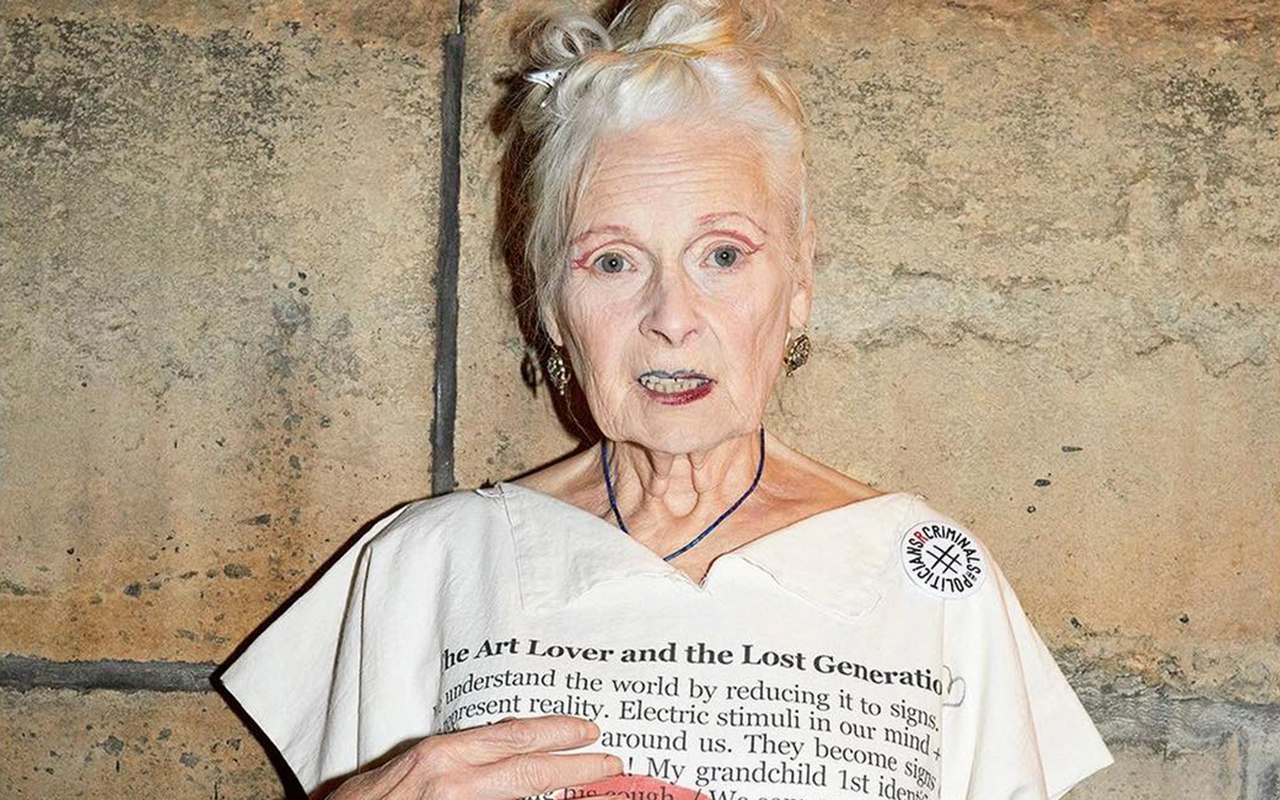
All photos: Facebook Vivienne Westwood
2022 ended with the farewell to one of the emblems of 20th century British design. Provocative, revolutionary, creative and political activist, Vivienne Westwood was a lawless idealist who forever transformed UK fashion. Her revolution was to make visible her aversion to corruption and injustice in the world, as well as to denounce the passivity of youth through clothing. Westwood gave birth to the punk movement in fashion, but also took couture by storm in the ’80s and ’90s; and built a global empire with stores all over the world, a priori antagonistic concepts (capitalism/anarchism) for a transgressor of the needle, but for Westwood there were no limits or labels. Fashion was a weapon and its objective was clear from the beginning: to change the rules of the game, destroy conventions and make the world more just and equal.
The renowned fashion designer died on December 29th at the age of 81 surrounded by her family in Clapham, South London. In a statement from the brand, they assured that Vivienne Westwood “continued to the end with her subversive design, her artistic activities and her activism, to change the world.” Her husband and creative partner Andreas Kronthaler said of the designer: “I will continue to hold Vivienne in my heart. We have been working to the end and she has given me many things to keep going.” Her legacy lives on.
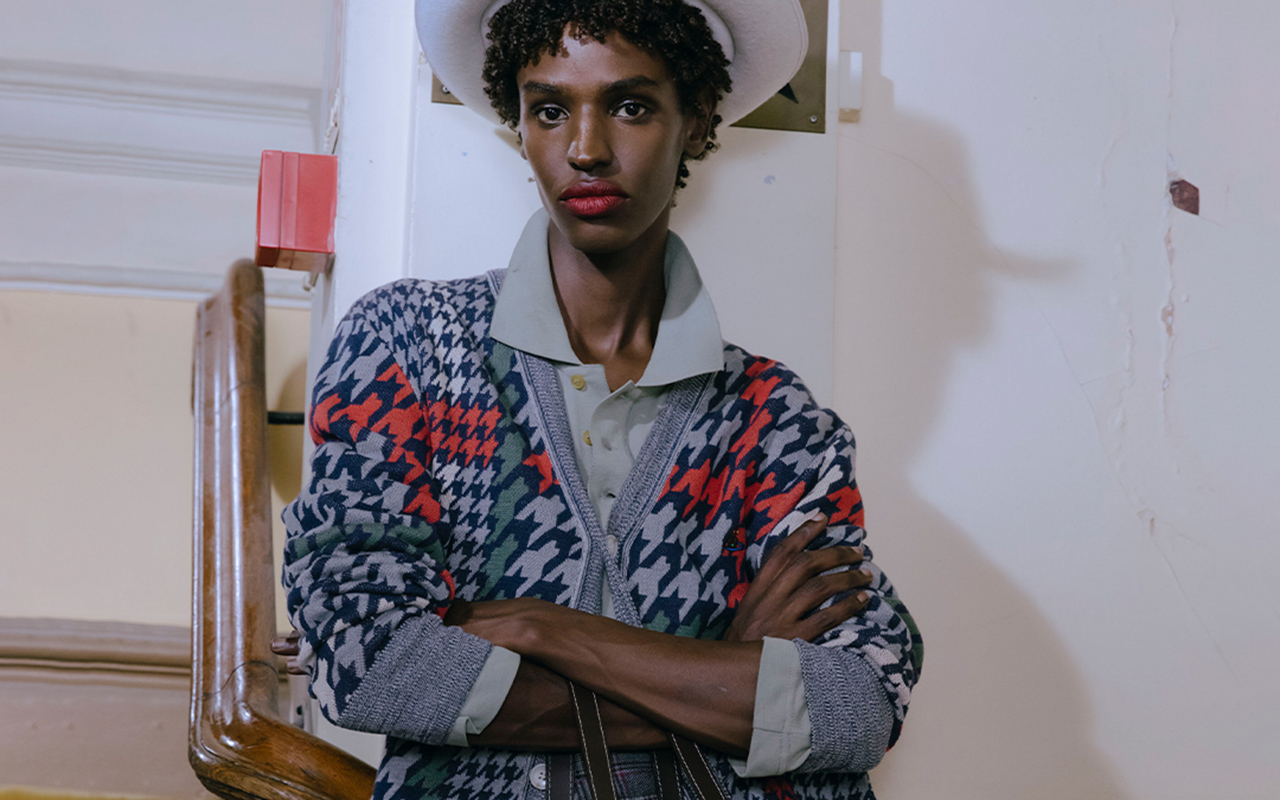
As a child she showed proise
Vivienne Isabel Swire was born in 1941 in the town of Tintwhistle, near Manchester. Her working-class parents encouraged her to do crafts, a skill little Vivienne was extraordinarily good at. She also liked to read a lot and spent long afternoons in the library. As a child she had an enviable self-confidence, believing herself to be an exceptional craftswoman. “Honestly at the age of 5 I could have made a pair of shoes,” the designer said in an interview. Her family moved to North London in 1958. Despite her abilities, the young Vivienne graduated as a primary school teacher, then married Derek Westwood, a young blue-collar worker with a flamboyant mod aesthetic. The first creation, without knowing how to sew, was her own wedding dress, as well as the jewelry she wore.
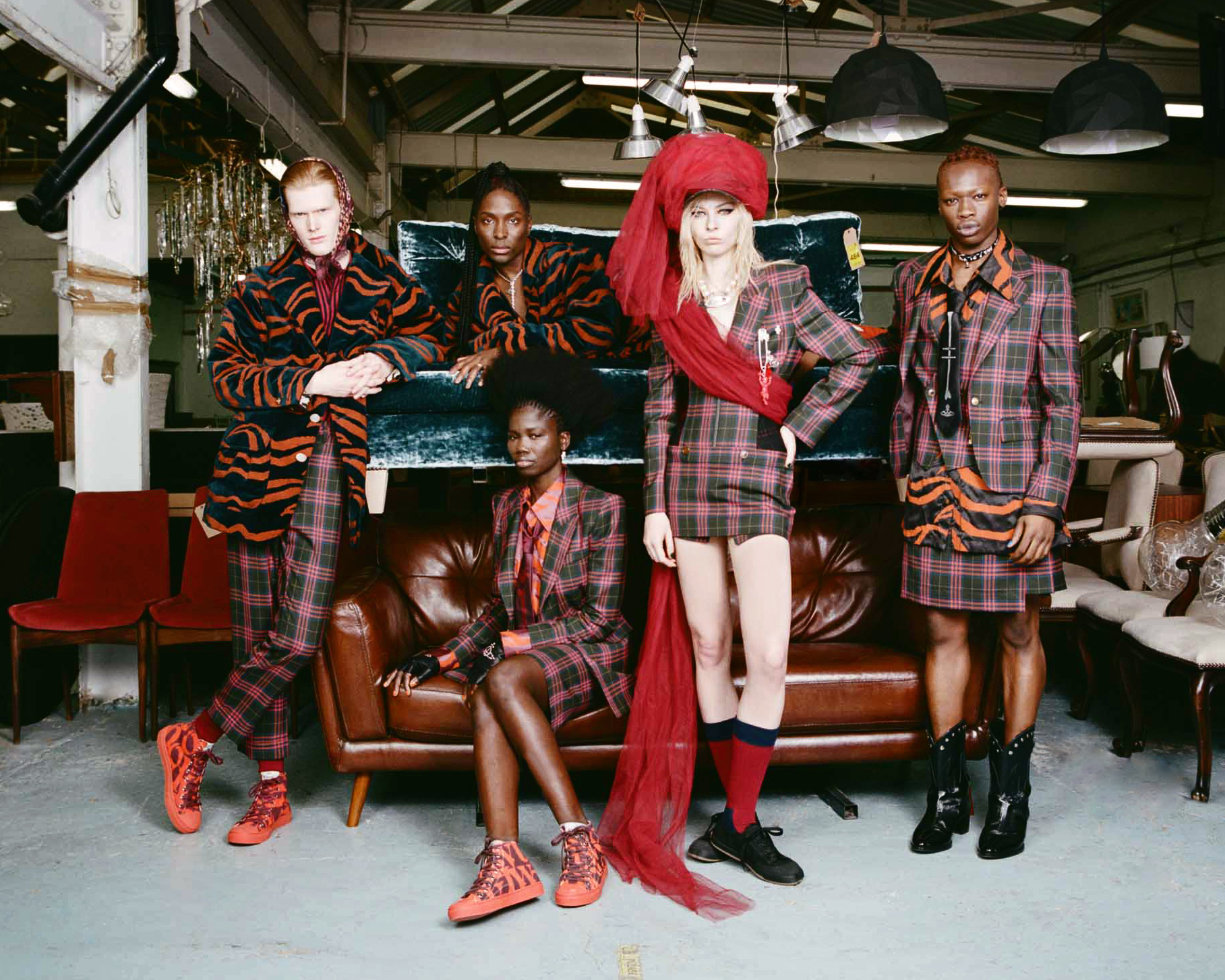
The influence of Malcolm McLaren
Meeting Malcolm McLaren then changed the peaceful life of Vivienne Westwood. He studied art and shared a class with one of Vivienne’s brothers, he had curly red hair and a face bleached with talcum powder. He called himself the godfather of punk. With an eccentric appearance, McLaren impressed with his creativity and brilliance, at the same time that he offended the older generations and hated everyone, except himself. The attraction to Vivienne was immediate and together they began one of the great creative partnerships in recent UK history. For the young designer, McLaren was an awakening for her: introducing her to art, music, and the transformative power of fashion.
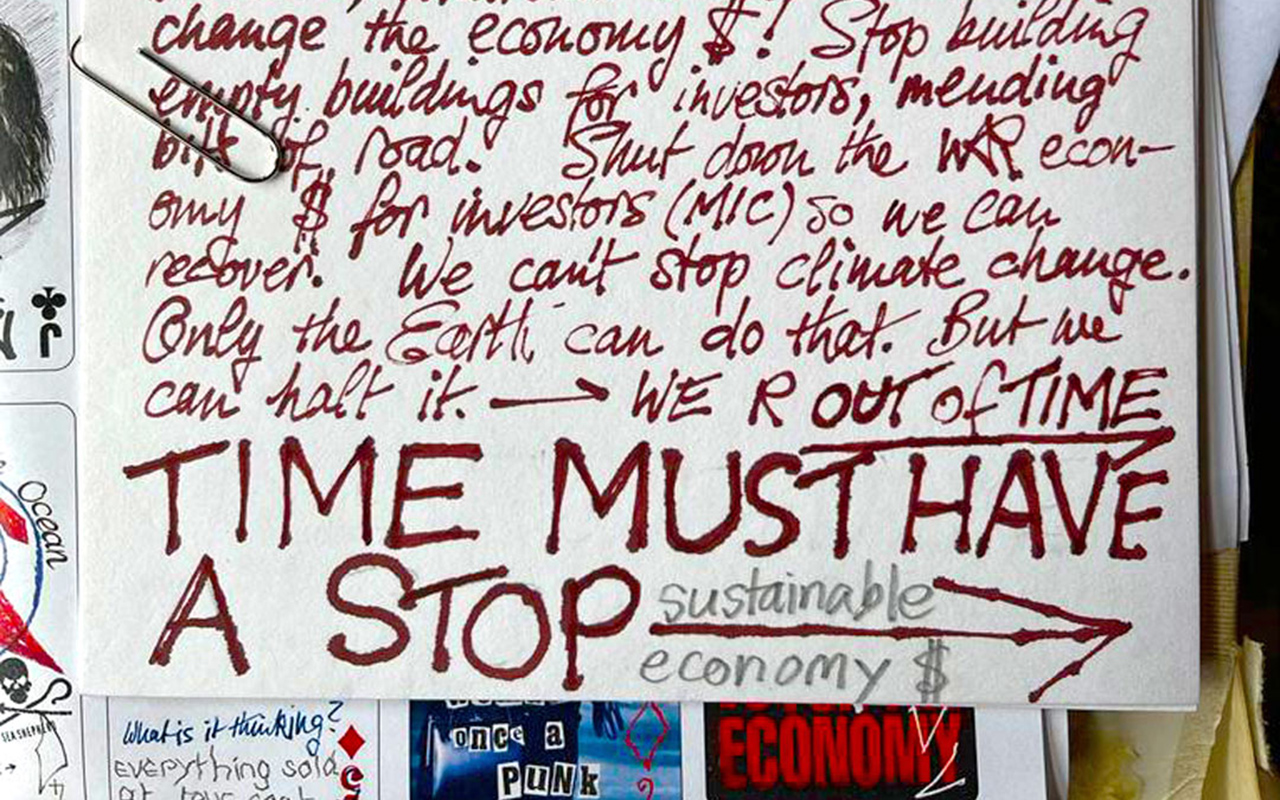
Fashion and punk
In 1970, McLaren became the manager of The Sex Pistols, a group that defined the punk movement. At that time, Westwood had learned the trade in a self-taught way and opened a store on Kings Road in London inspired by the aesthetics of the group. She called it a subversive name: ‘Sex’ with a huge pink sign alerting passers-by: “only the brave enter”. Inside, everything was shocking. The serving staff and the clothing on display were designed to explore the individualism and identity of the wearer. Clothes with studs, chains, zippers, tight leather garments, impossible heels, T-shirts with subversive messages… Everything was designed to shock. “We invented punk,” Westwood stated in her autobiography. In fact, the presence of Vivienne and McLaren was inherently intimidating. They wanted to impress, irritate and provoke a reaction, but also inspire change. Punk was still an explosion in all its magnitude.
McLaren later acknowledged that he was willing to misrepresent popular culture to reduce it into some kind of marketing campaign, but for Westwood, the move ran deeper because she saw it as a youth insurgency against the corruption of the old world order. The British designer believed that fashion and music would channel the anger of young people and bring about change, but later realized that many of them simply ignored global injustice, and with their nose studs and punk rock music the only thing that they did was dance and have a good time.
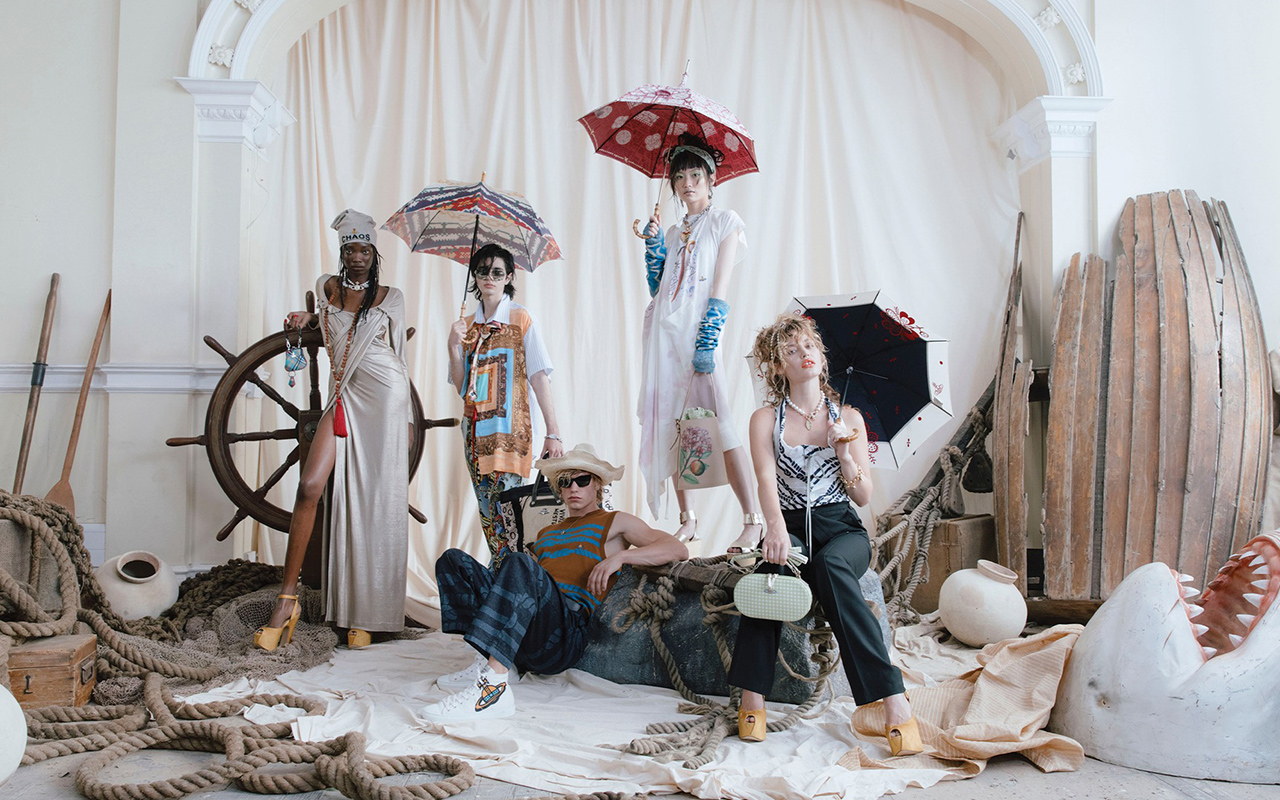
The jump to the big catwalks
Punk was just one chapter in the legacy that Westwood leaves behind in fashion. The designer took her subversive ideas and stormed the catwalks in London and Paris. Vivienne worked at first alone with a sewing machine at home and used the moulage technique, joining the pieces together and using her own body as a template. She researched the history of fashion, remade it in her own way, and challenged the world of haute couture. An alliance with the generation of supermodels: Kate Moss, Naomi Campbell, Laetita Casta… showing her designs also helped her to position herself and become the leading independent designer in the 1980s and 1990s. The key to Vivienne Westwood’s success was that of not losing her orthodox identity when she moved into the world of fashion shows and ready-to-wear collections with abruptly cut garments, games of semiotics, decontextualized objects, draping… Precisely her subversive style and her transgressive image (her hair was either bleached or dyed orange and extreme makeup), made her one of the most distinctive and original designers in the fashion world. In the early 1990s, Vivienne Westwood built a mini-empire: she opened her own boutiques and produced clothing, footwear, accessories, cosmetics, and perfumes. Even bridal fashion! When Carrie Bradshaw’s character in the mythical series ‘Sex and the City’ wanted a wedding dress, she turned to the famous designer, who by the late 90s had already become a major bridal brand.
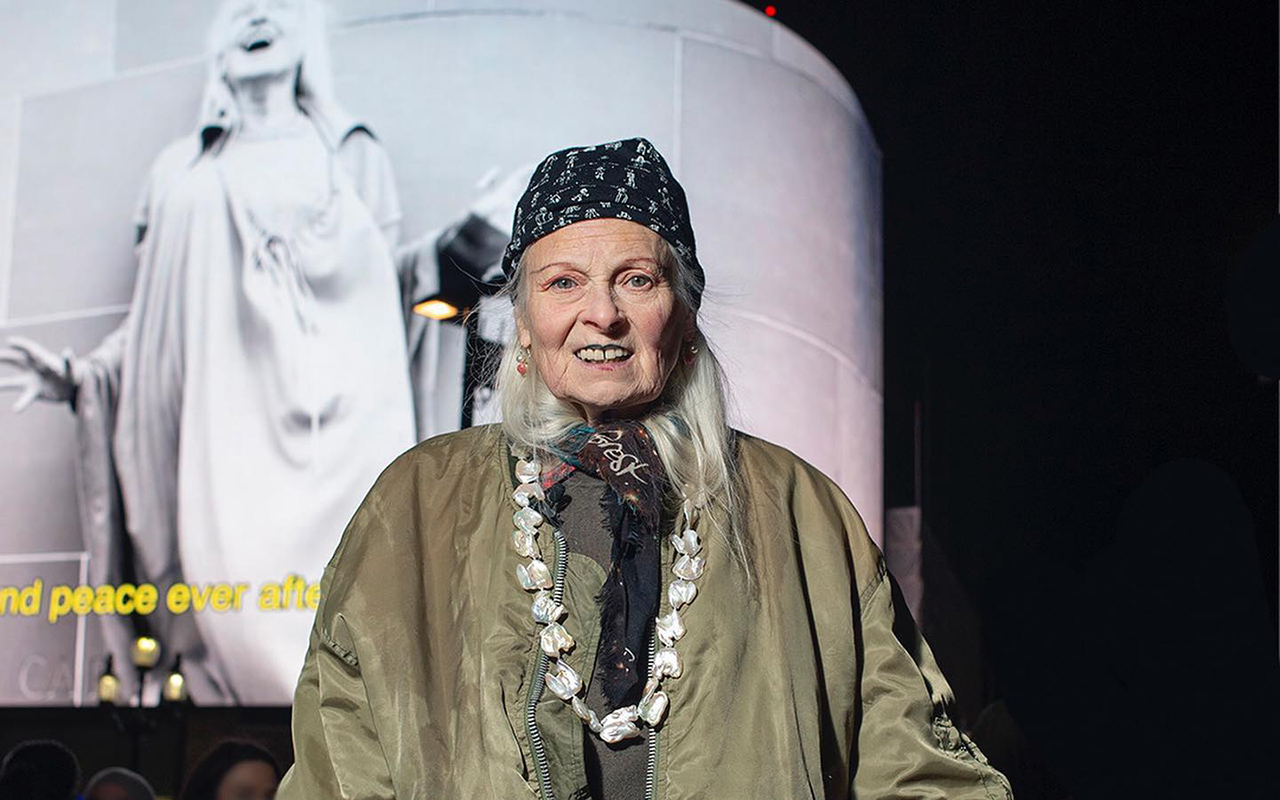
The more committed side
For Vivienne Westwood, fashion was a weapon and the message an inseparable part of her aesthetic heritage. Everything had a purpose. The British designer loathed the political class and launched a lifelong crusade to promote individual freedom, rid the world of nuclear weapons and combat the threat of climate change. “Buy less, choose better and make it last” is one of the lessons that still survives in times of climate emergency.
“I don’t want to be underground ,” she used to protest, defending that she wanted to be out of the spotlight to spread her message. She supported numerous causes, donating to the Green Party and becoming a regular visitor to WikiLeaks founder Julian Assange. She even parked a white tank outside the home of former Prime Minister David Cameron at an anti-fracking protest.
Vivienne Westwood was also honoured by Queen Elizabeth II. The late monarch presented her with the Order of the British Empire in 1992 and the designer appeared without underwear. Her Majesty was not amused by this rebellious gesture, but on her own merits she agreed to name her Dame a few years later. And this is how Lady Westwood, godmother of punk, defended to the last breath, her transgressive ideas applied inside and outside of fashion, but above all, maintaining a coherent attitude towards life by questioning, in her own way, the world order and the rules. of the game.
At Gratacós, we pay homage to Vivienne Westwood with a selection of our most irreverent fabrics. You can find them in our online store or in the Barcelona space.
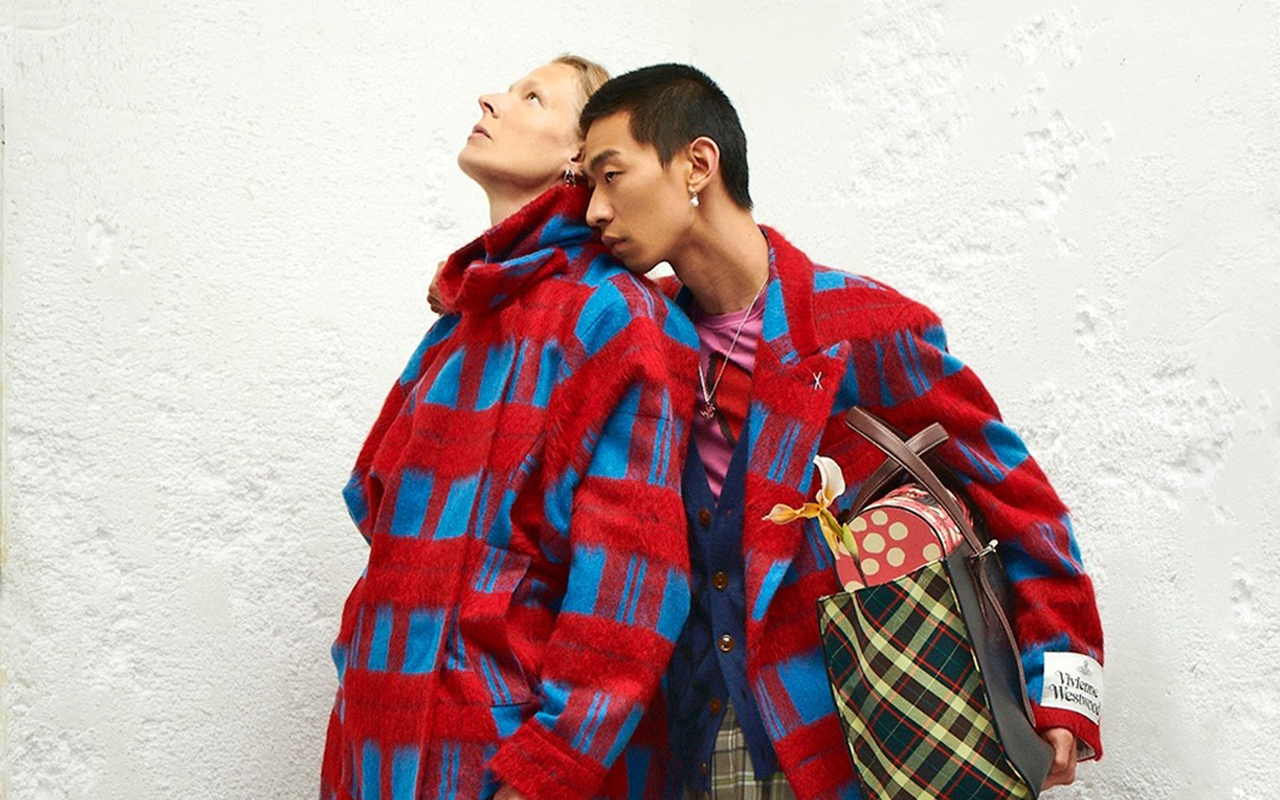
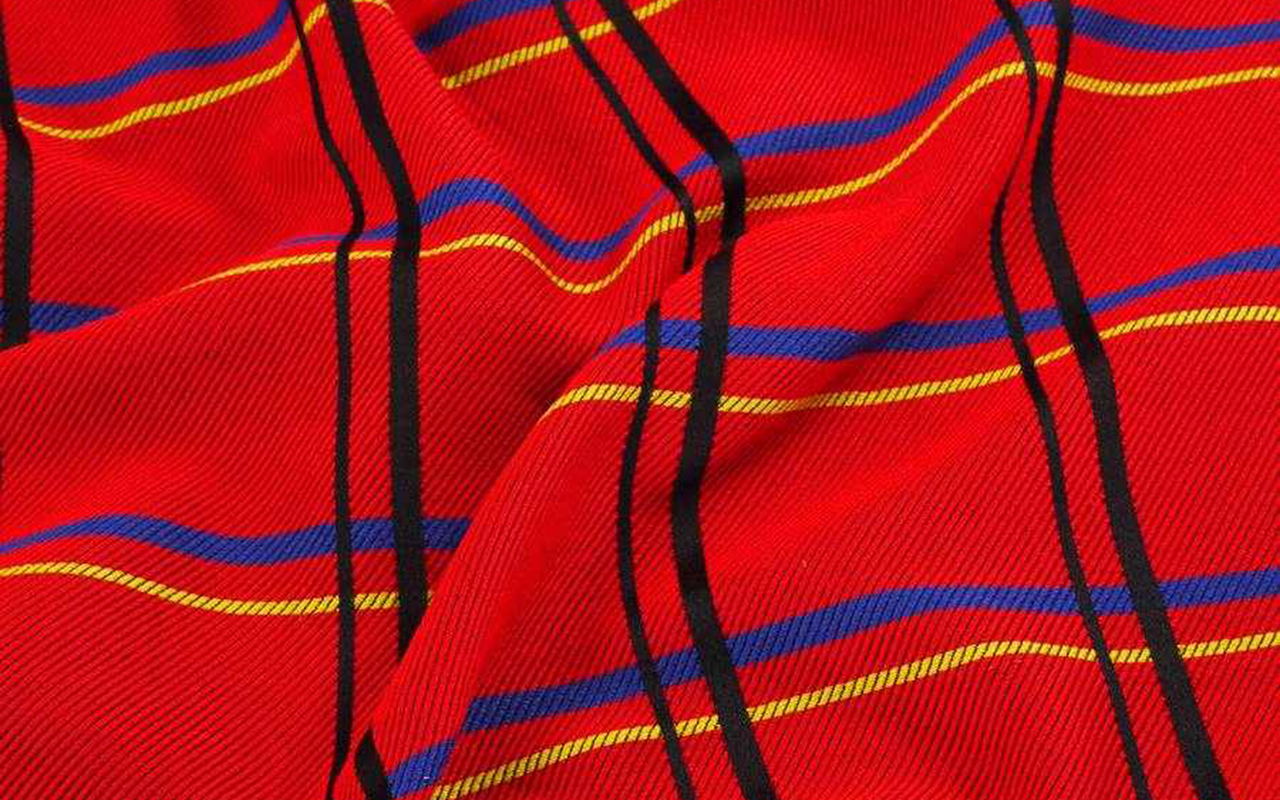
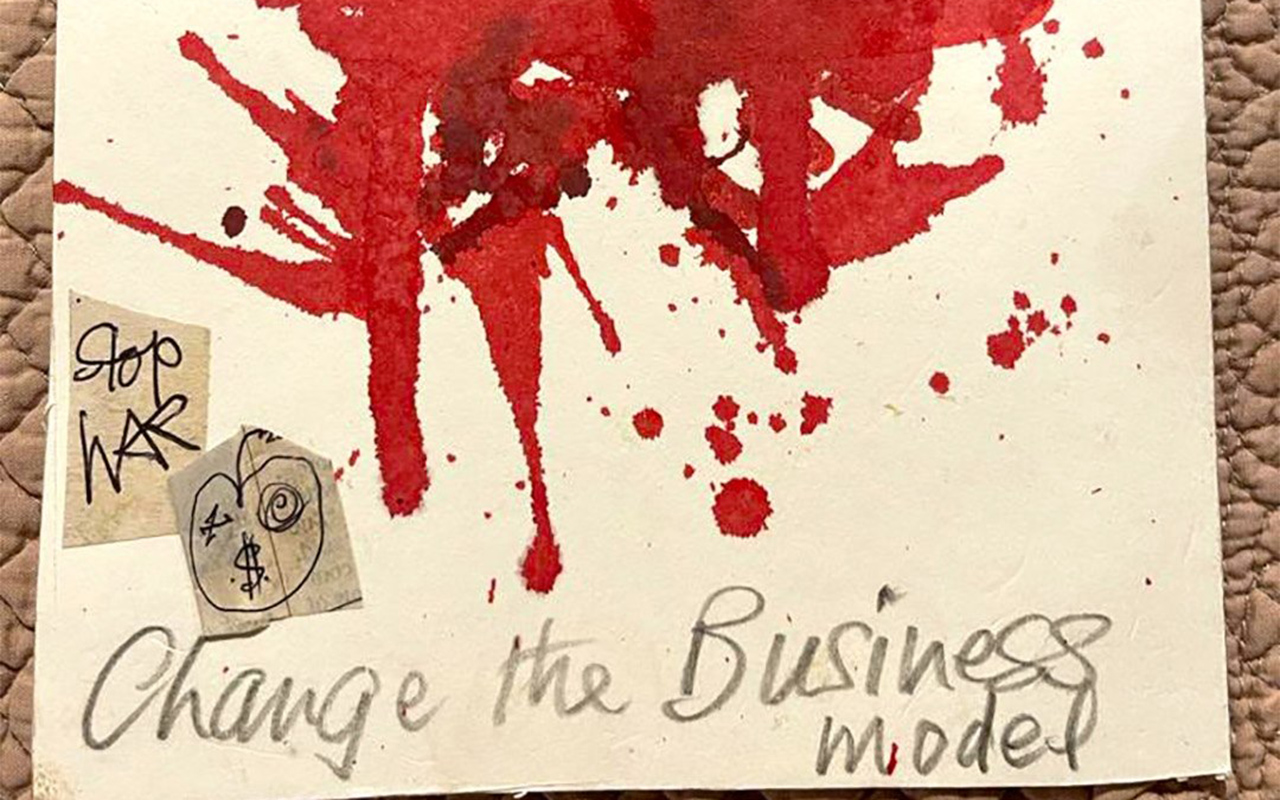

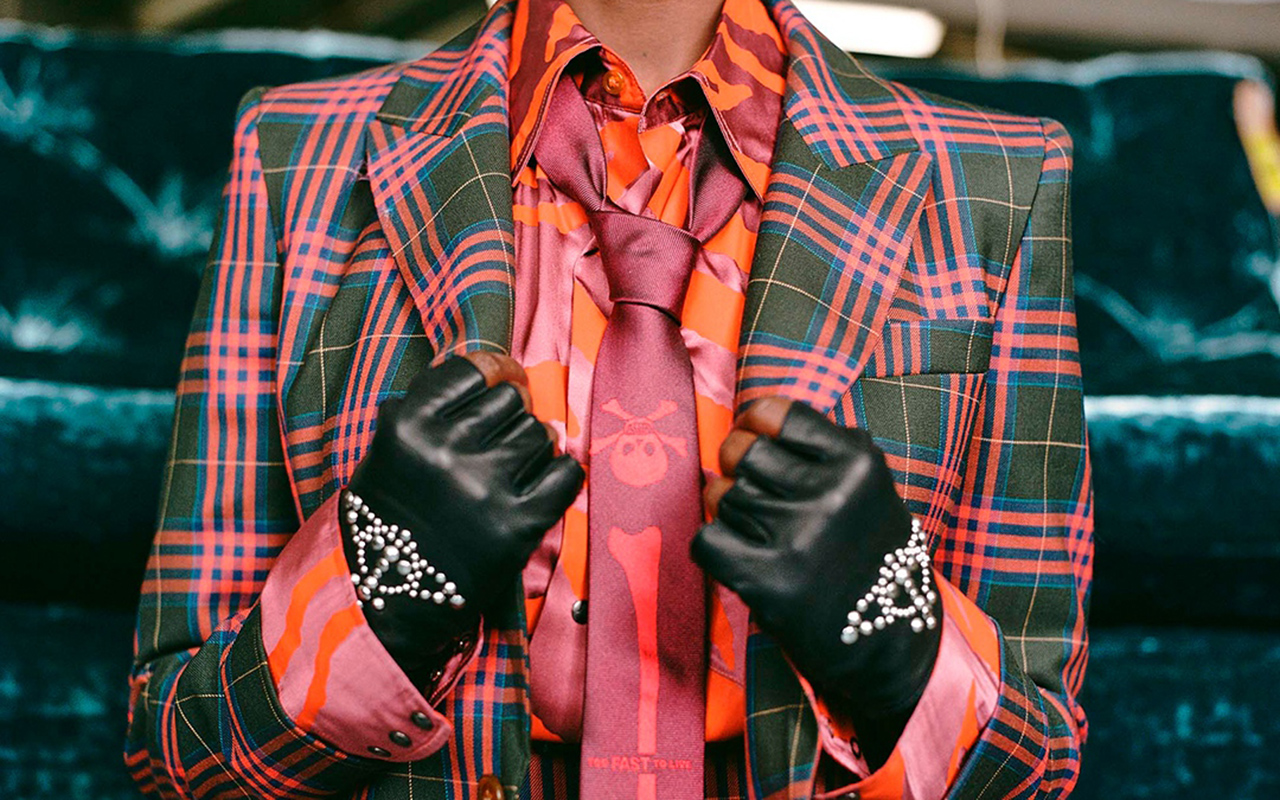
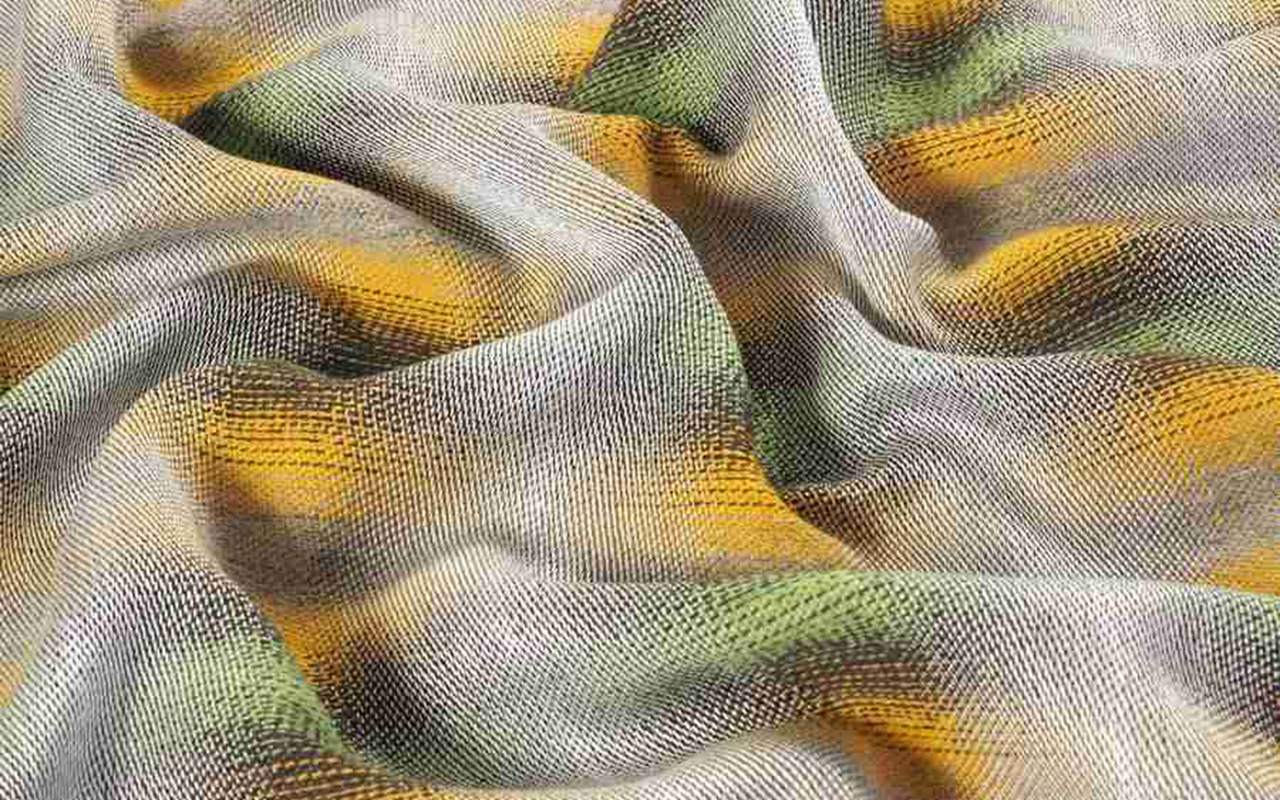
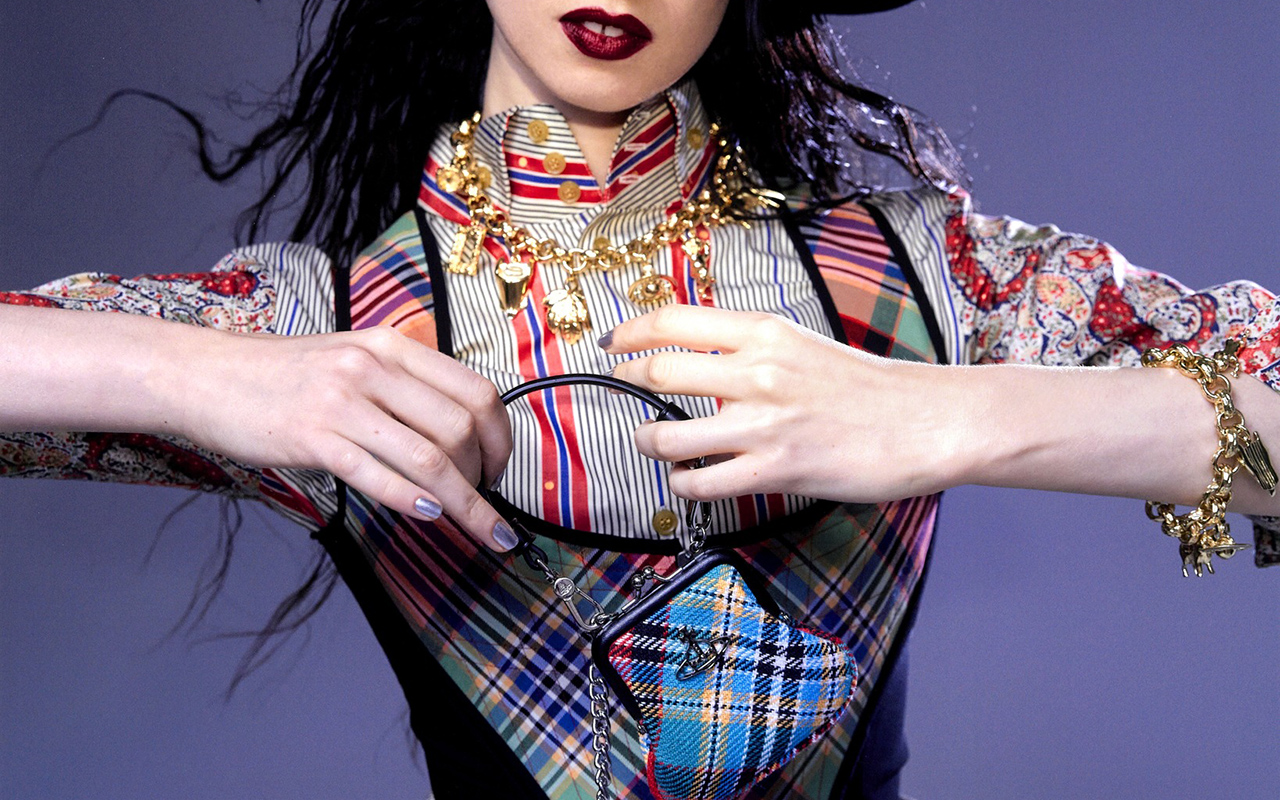
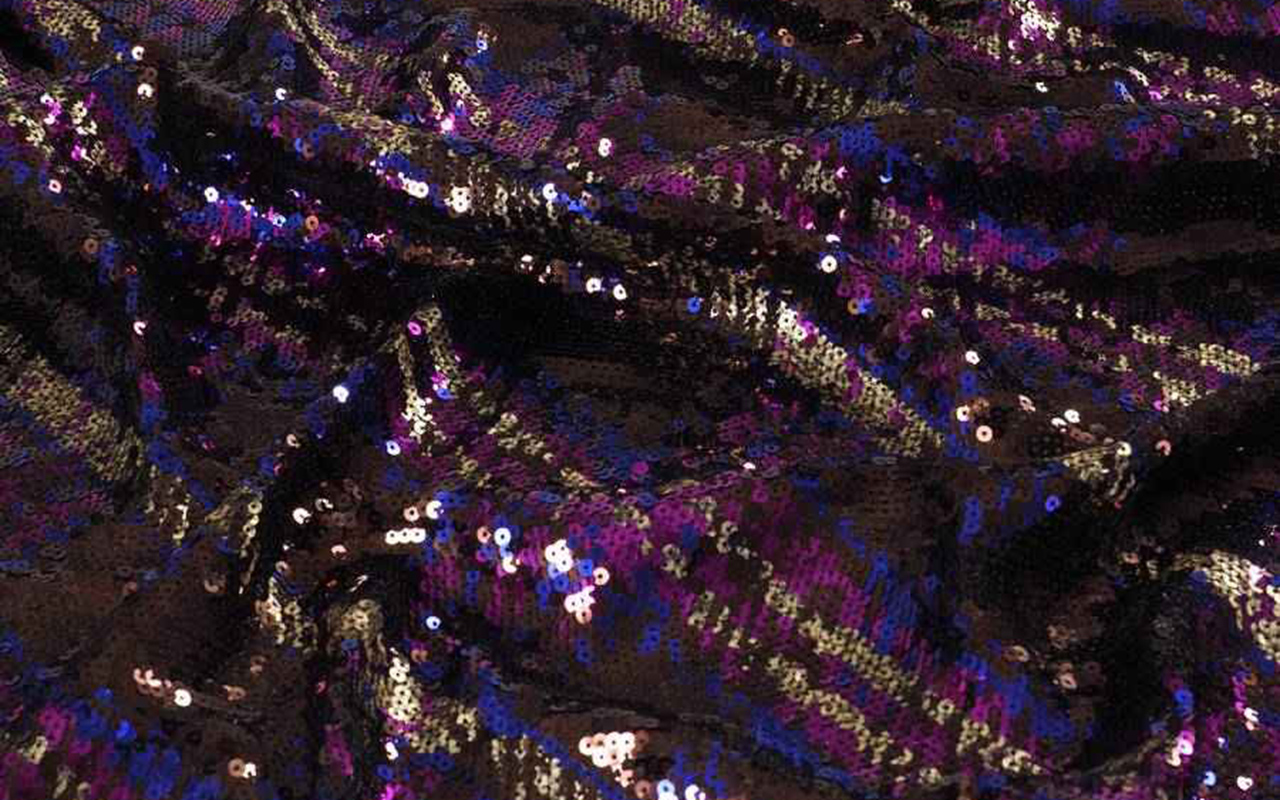
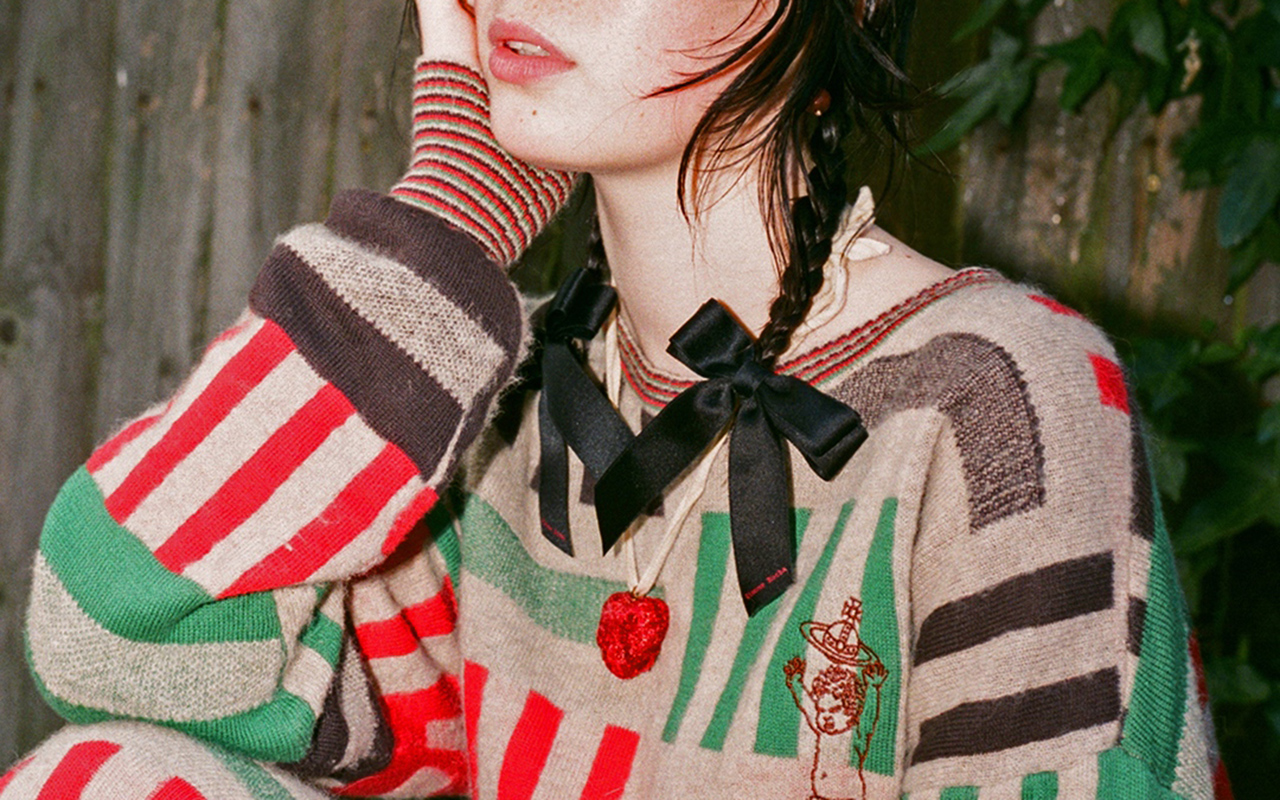
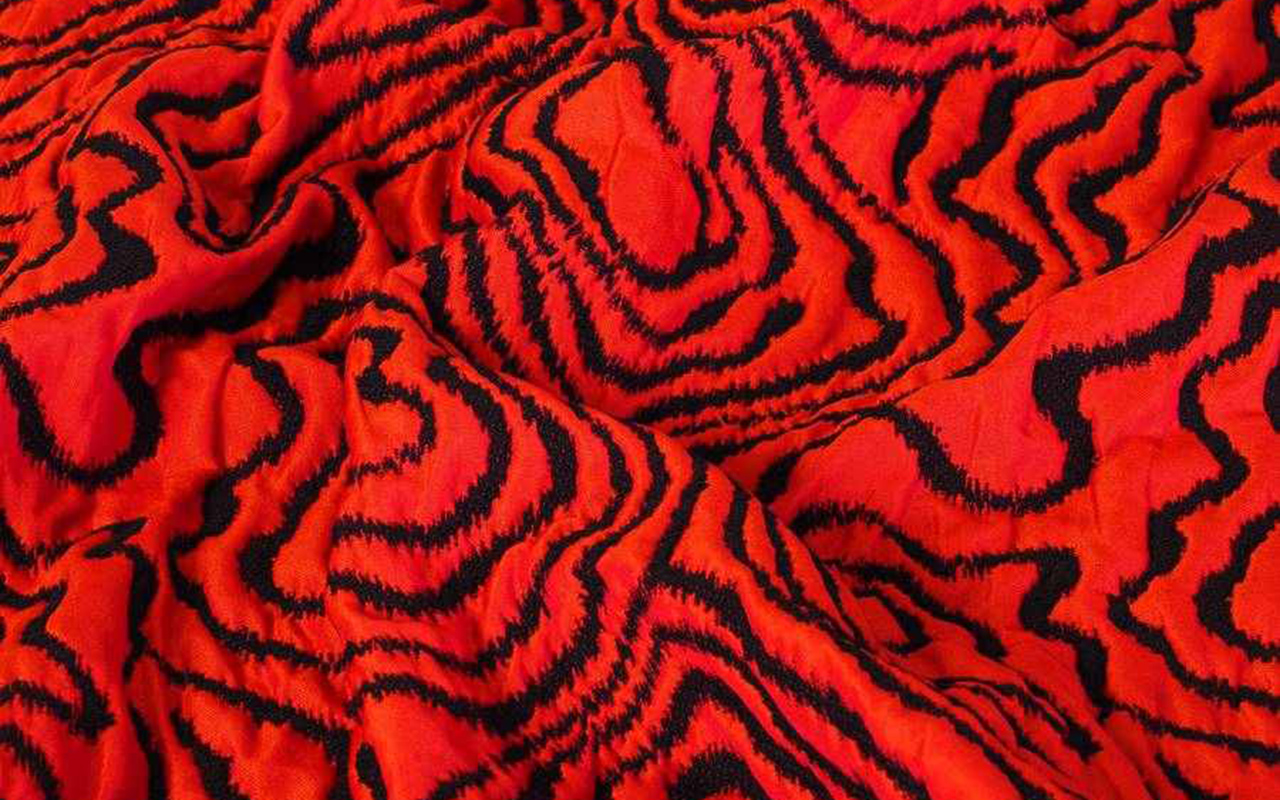
Viernes 30 diciembre 2022
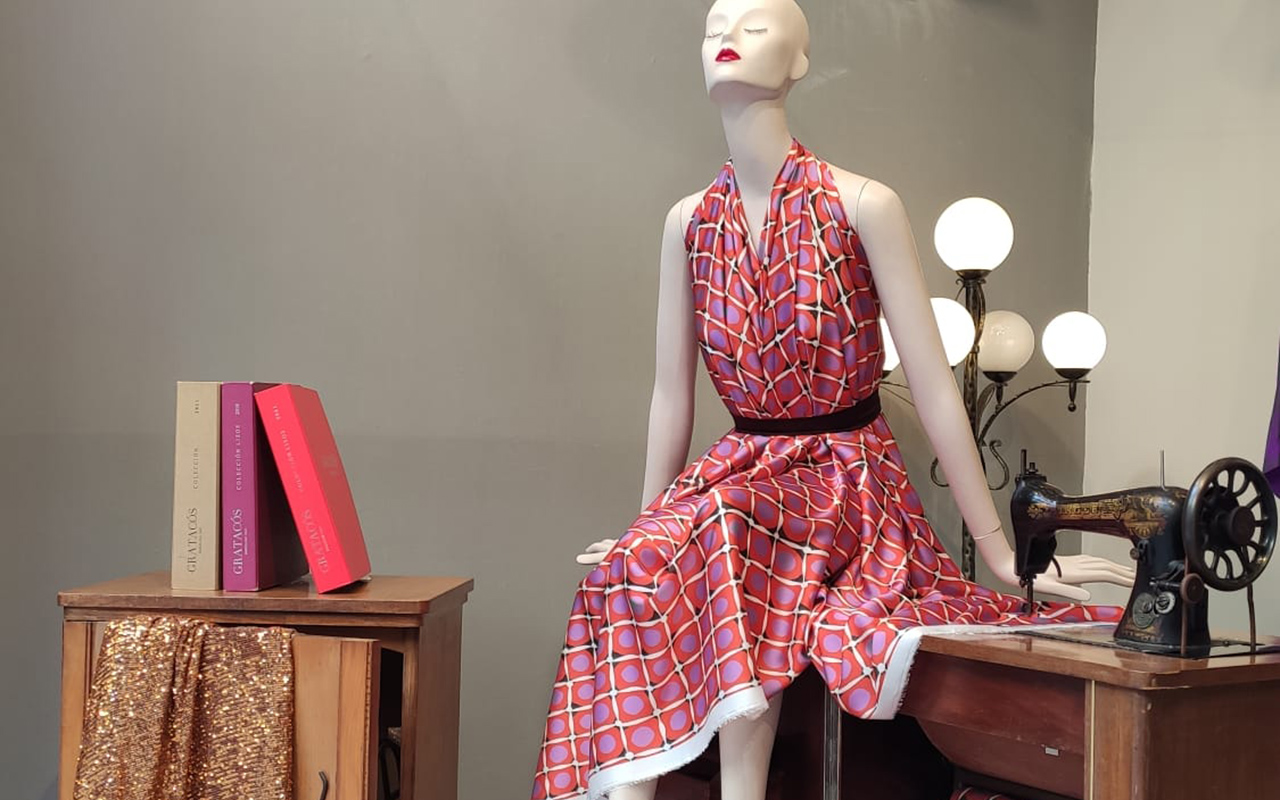
At the end of the year the evaluation lists come out: the best books, the most influential characters, the must-see series, the trends that have marked each season, the new fashionable words that we incorporate into the dictionary… At Gratacós we carry out our particular revival exhibiting the shop windows that have been created at the entrance of our space in Barcelona. In fact, it is nothing new that we bet on creating windows that attract attention. We have always done it and each window represents a new visual letter of presentation because it speaks of who we are and what we do in a creative, spontaneous and current way, using new languages of expression that go beyond fashion.
During this year of return to “neo normality” we have dressed our mannequins with spectacular fabrics from the new season, but we have also had the support of the students of the design schools we collaborate with, the creativity of brands made in Barcelona and some artists linked to Gratacós . All of them have put their grain of sand to build new windows that create that attraction effect to those who come to our physical store. We review them below:
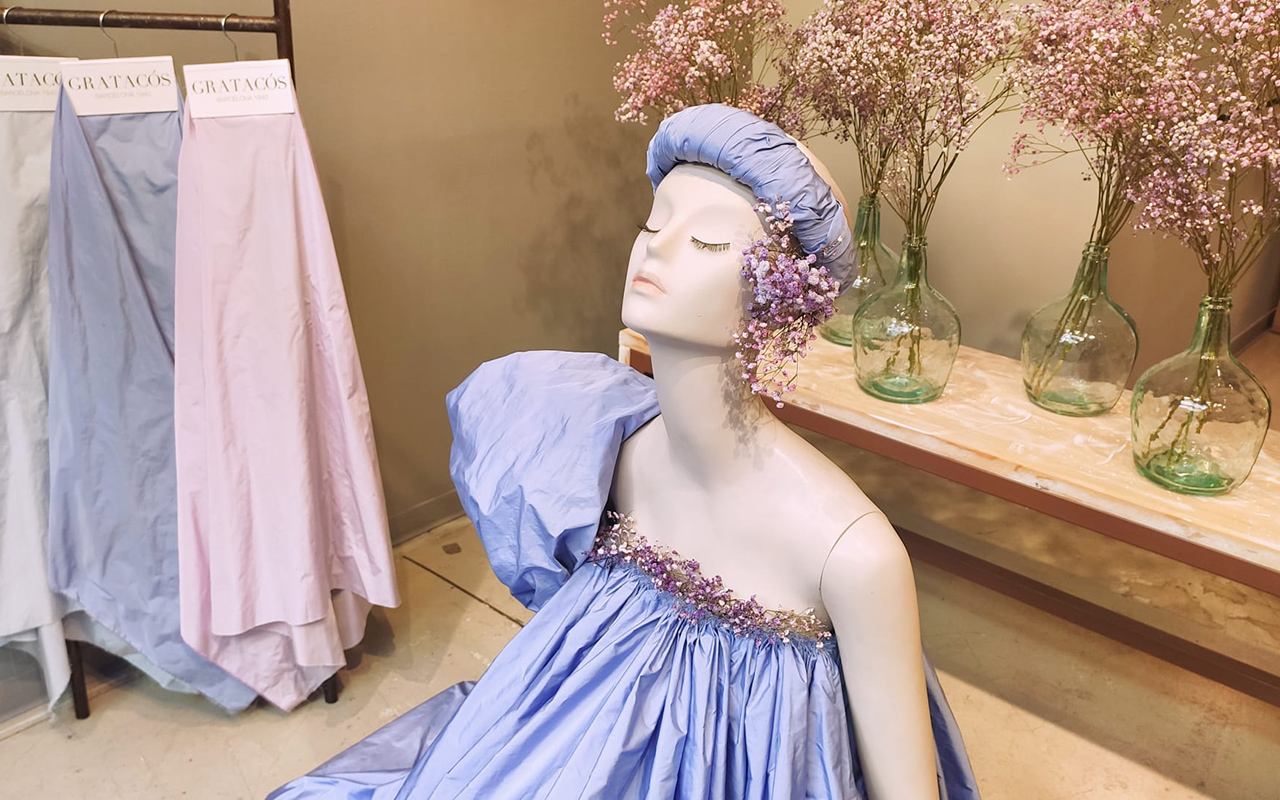
February 2022. Echoes of spring
Winter was short-lived in 2022 and the high temperatures, unusual in February, were unknowingly a foretaste of what would come next and would remain the usual trend throughout 2022, one of the warmest years on record. In the traditionally coldest month of the calendar, we took a look at our shop window betting on the incipient spring that was already rearing its head. The first green shoots, the white and pink flowers of the almond trees and, in general, a new awakening of the flora that we express through taffetas (Picasso) and colour in its softest tones.
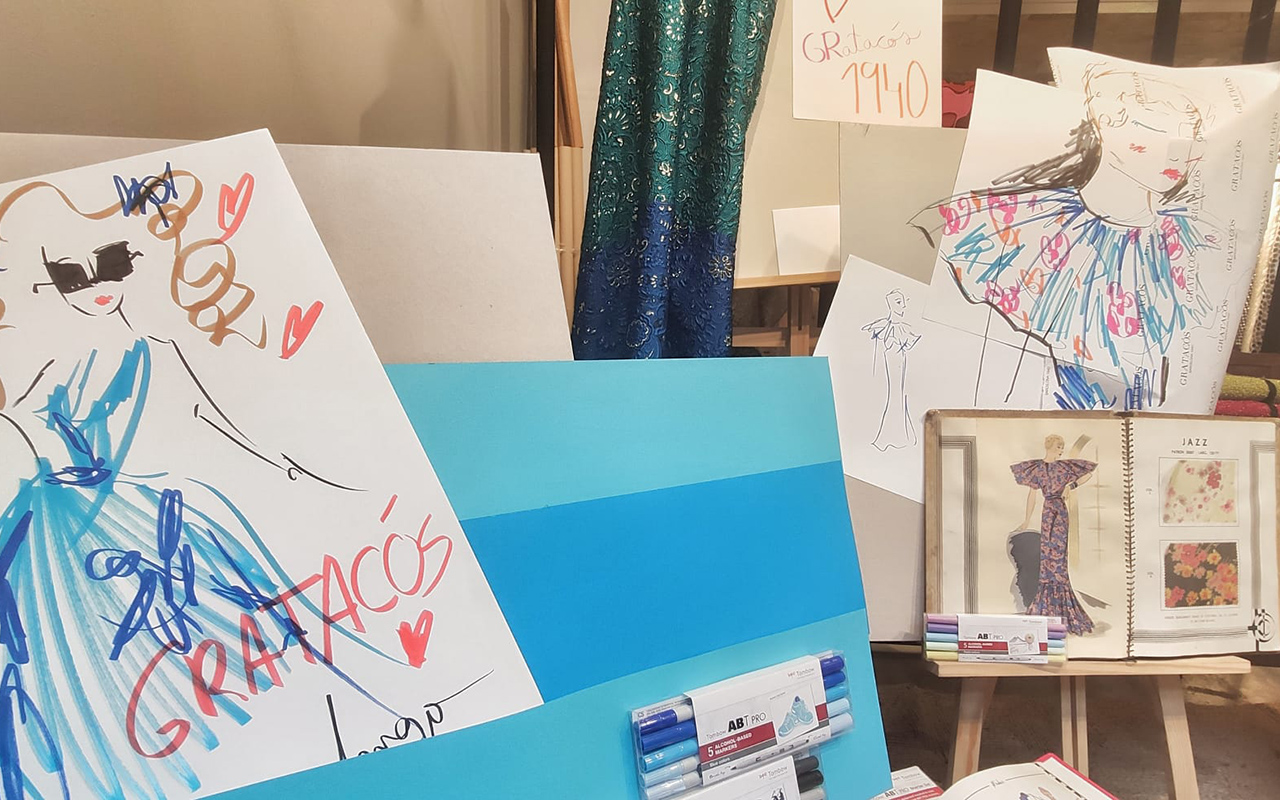
March 2022. An arty twist
In March there was an artistic turn towards fashion illustration with the identifiable stroke of Joel Miñana, where his colourful mannequins were the absolute protagonists of the window. Using coloured pencils, markers and geometric lines, Joel interpreted some of the key fabrics of the season in an arty key . This contemporary vision was complemented with cuts from vintage dresses, fabrics from other seasons, and classic drawings that review the history of Gratacós, offering two visions that define our company: tradition with modernity.
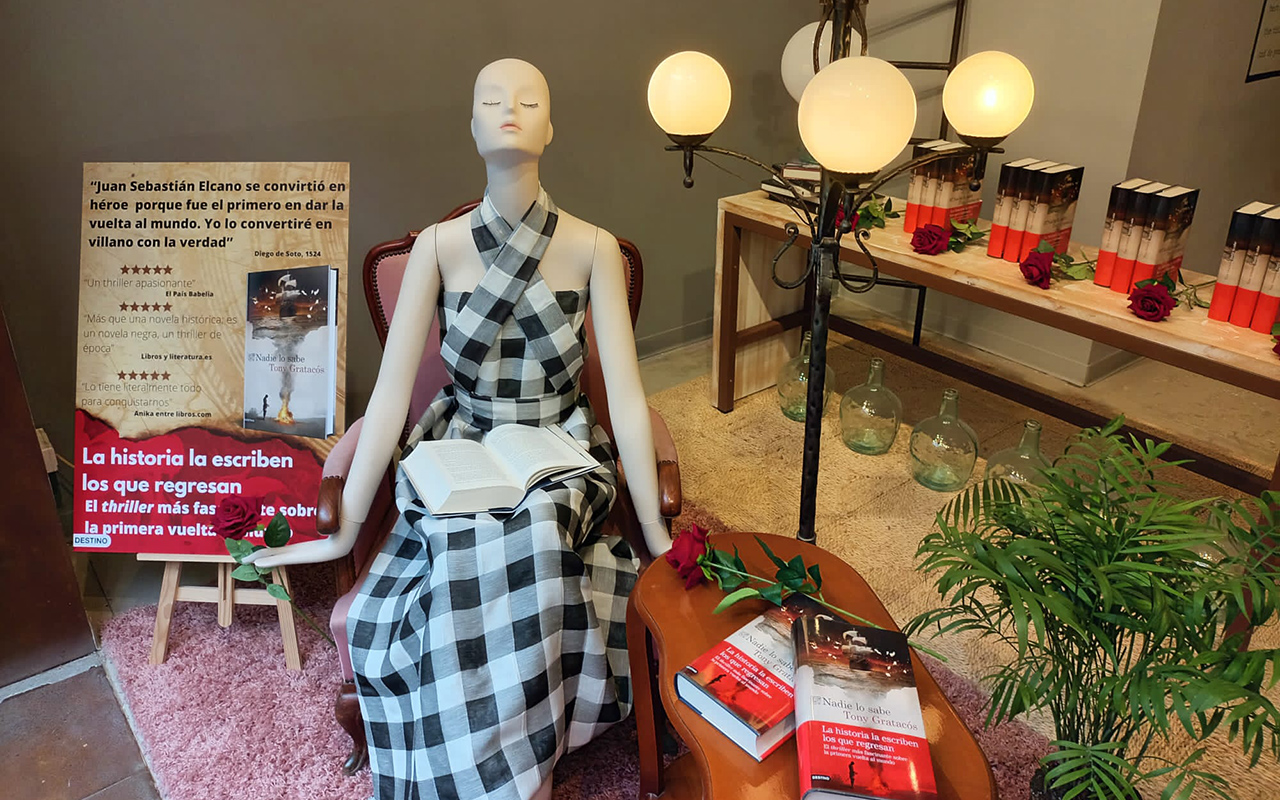
April 2022. A book to remember
In the month dedicated to literary culture, we wanted to do our part by paying tribute to a specific book: ‘Nobody knows’ (Planeta, 2022) by Tony Gratacós . A historical thriller about some of the mysteries of the first circumnavigation of the world. The author gives a twist to the figure of the navigator Juan Sebastián Elcano, one of the few survivors of the Magellan expedition in an ambitious story that immerses us in one of the most splendid and fascinating periods in the history of Spain and that hides a secret that has taken five hundred years to come to light. The shop window could not miss some signed copies, roses and a mannequin with an imperishable fabric, the Gingham linen check that is renewed every year without losing its classic essence.
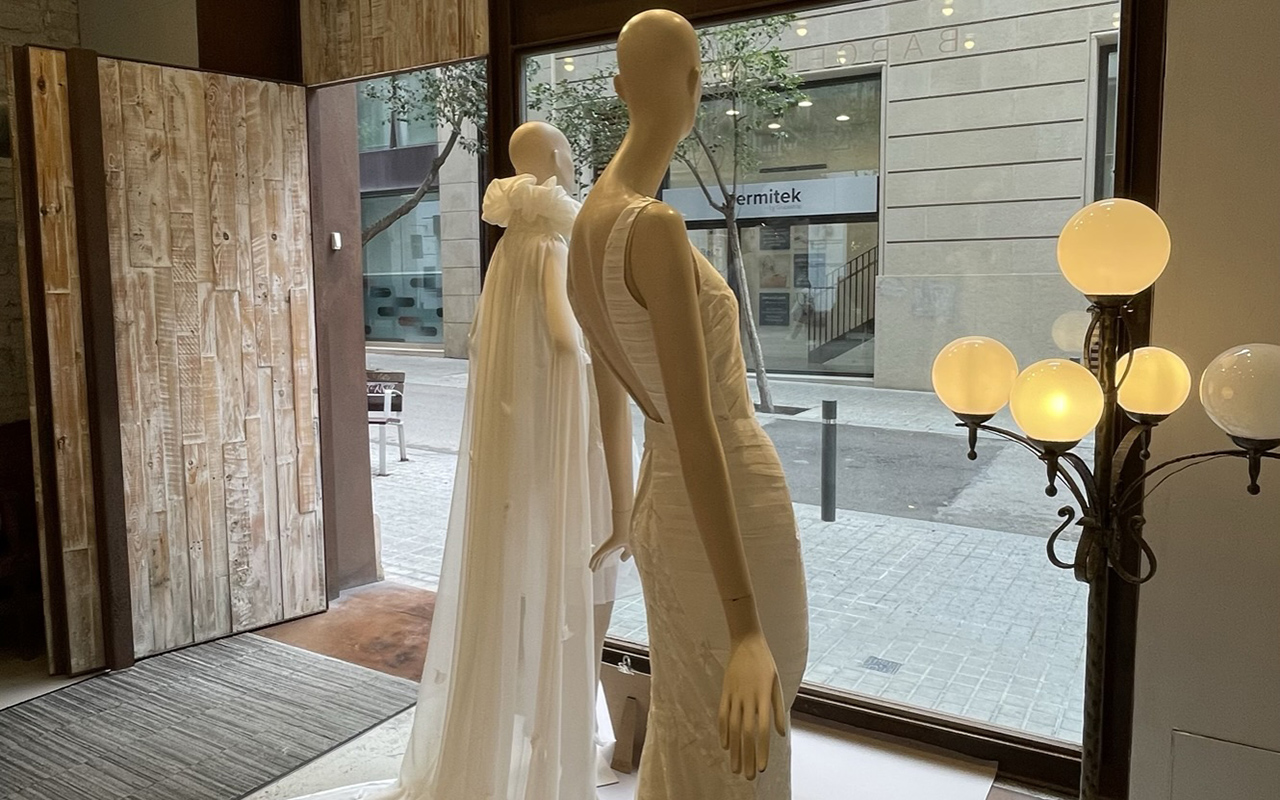
May 2022. The brides of the year
The bridal showcase took place in May this time, making visible the work of the last two winners of the contest IED Barcelona that the school organizes every year through their postgraduate course in Bridal Gown Design. On this occasion, the moulages by Myrian Medina, winner of 2022 and Nicole Claux , winner of 2021. Two wedding dresses, one made of georgette (Danubio) and the other made with mikado on the bodice and sequin embroidery on the tail of the skirt. The fabrics provided by Gratacós together with the unique cutting and sewing technique gave way to one of the most special showcases of 2022.
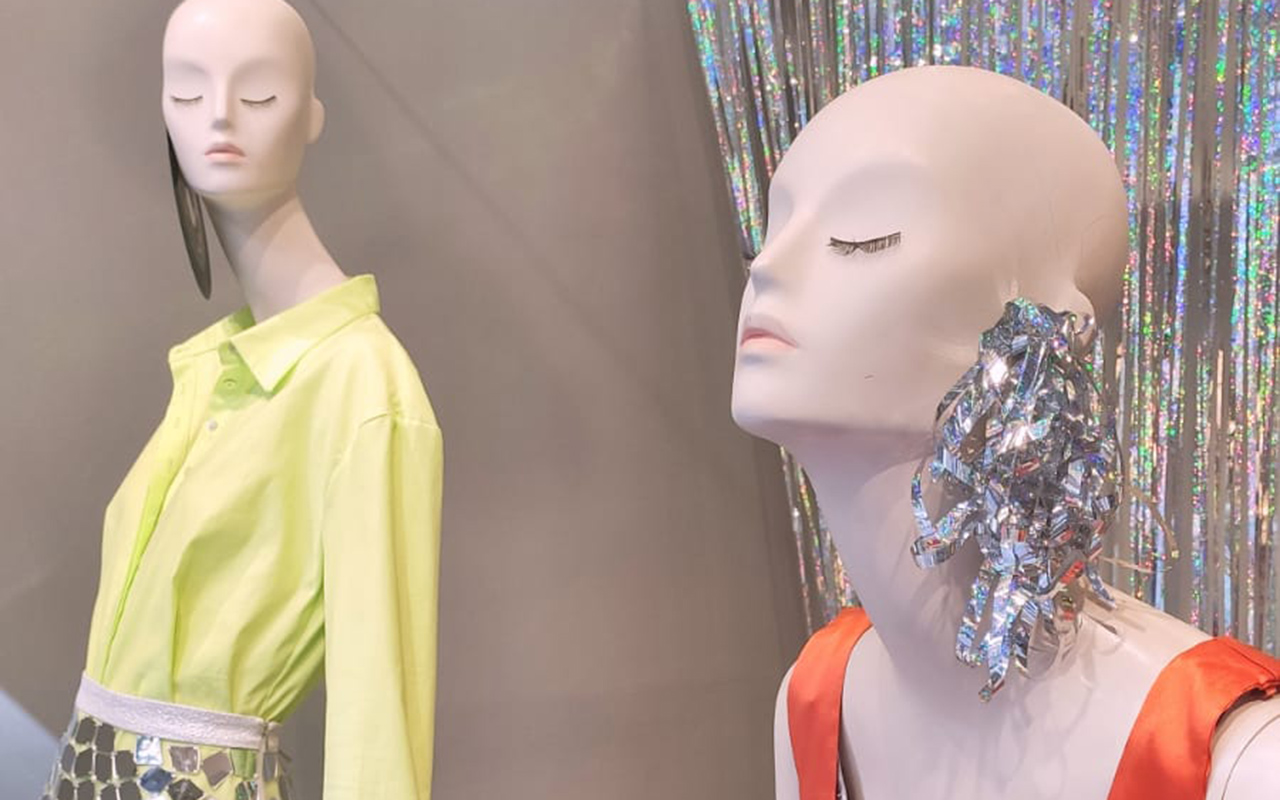
June 2022. Studio 54 returns
In June we welcomed what would be the longest summer of the 21st century, recalling the disco aesthetic of the 70s. Iridescent materials, reflective crystals and subtle shimmering fabrics to kick off a time full of outdoor celebrations. The bling bling aesthetic was achieved by Joplin Atelier, the Barcelona born firm of Laura and Aida Molano who succeed with their glam rock style , creating feminine and opulent looks in volumes, colours and fabrics. The mannequins wore two looks in lime cotton and orange silk satin combined with pieces made with mirror effect appliqués on tulle as a miniskirt.
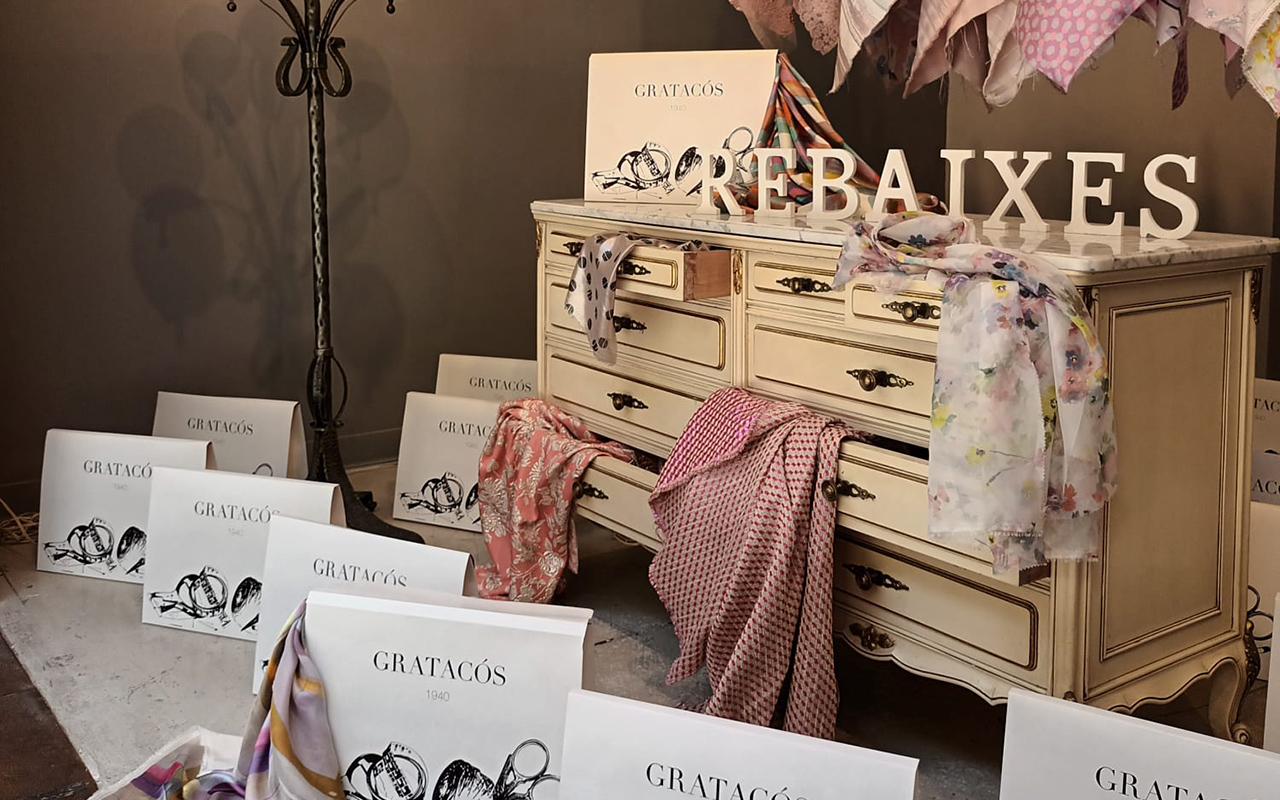
July and August 2022. Sales time
The sales were the stars of the holiday months and we showed a selection of our best seasonal fabrics in various shades of pink and ecru: jacquards , prints and embroidery mostly. The shop window recreated a feminine room with a certain air of disorder, through a chest of drawers with a vintage spirit , where sumptuous fabrics sprouted from each of the drawers. A tribute to the carefree divas of classic cinema brought to our land.
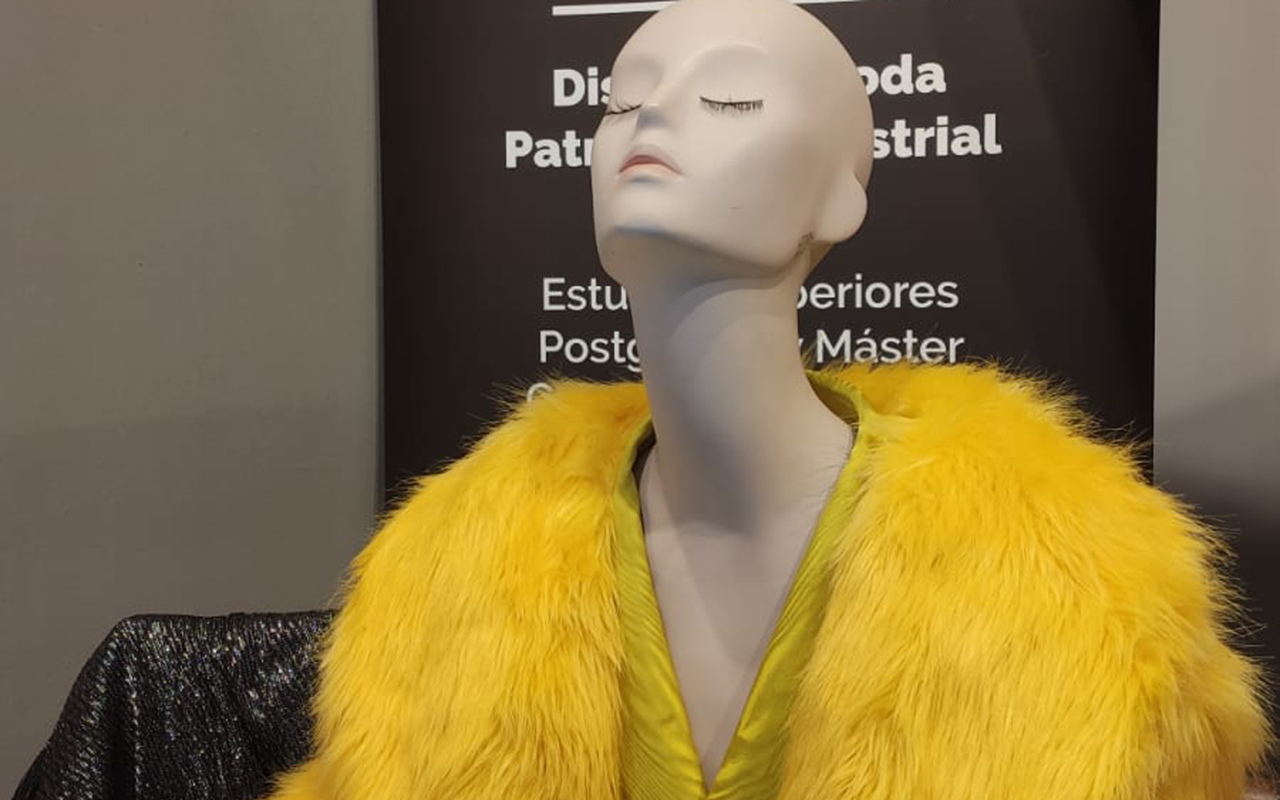
September 2022. Back to school
In the fashion industry, the year traditionally begins in September, coinciding with the change of season, the new catwalk calendar and the most powerful magazines in the world invest in million-dollar covers to compete in sales. This month, the designer Emile Albretch from the ICM school exhibited her latest models through pieces made with different jacquards , knitted with lamé and moiré. The result was an interesting mixing exercise with a colourful result that hooks the new generations.
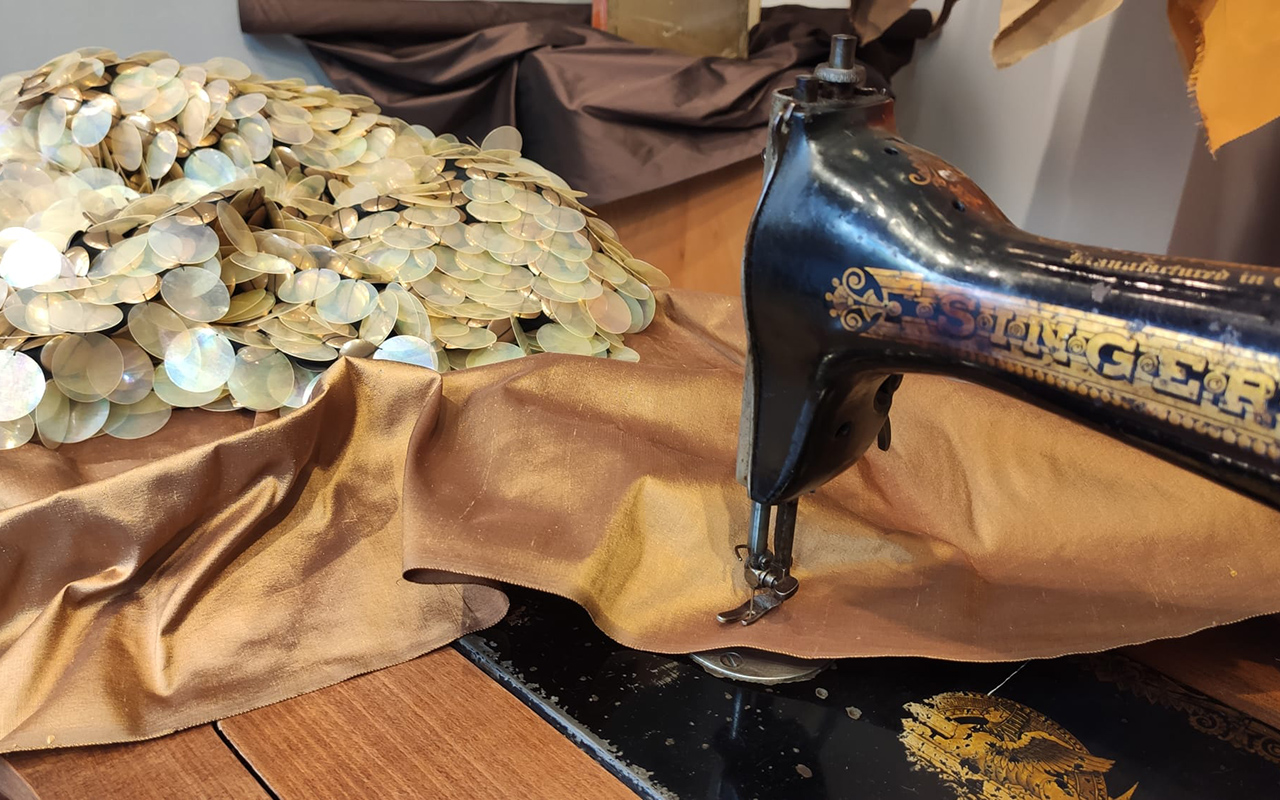
October and November 2022. Home sweet home
The quintessential autumn months were dedicated to exploring the traditional universe of the home. Sewing, cutting and sewing, leisurely hobbies that require the work of the hands with a dose of creativity, perseverance and patience. From this intimate refuge, the dreams of tomorrow are woven through wonderful fabrics such as wild silk in gold or transparent XXL paillettes.
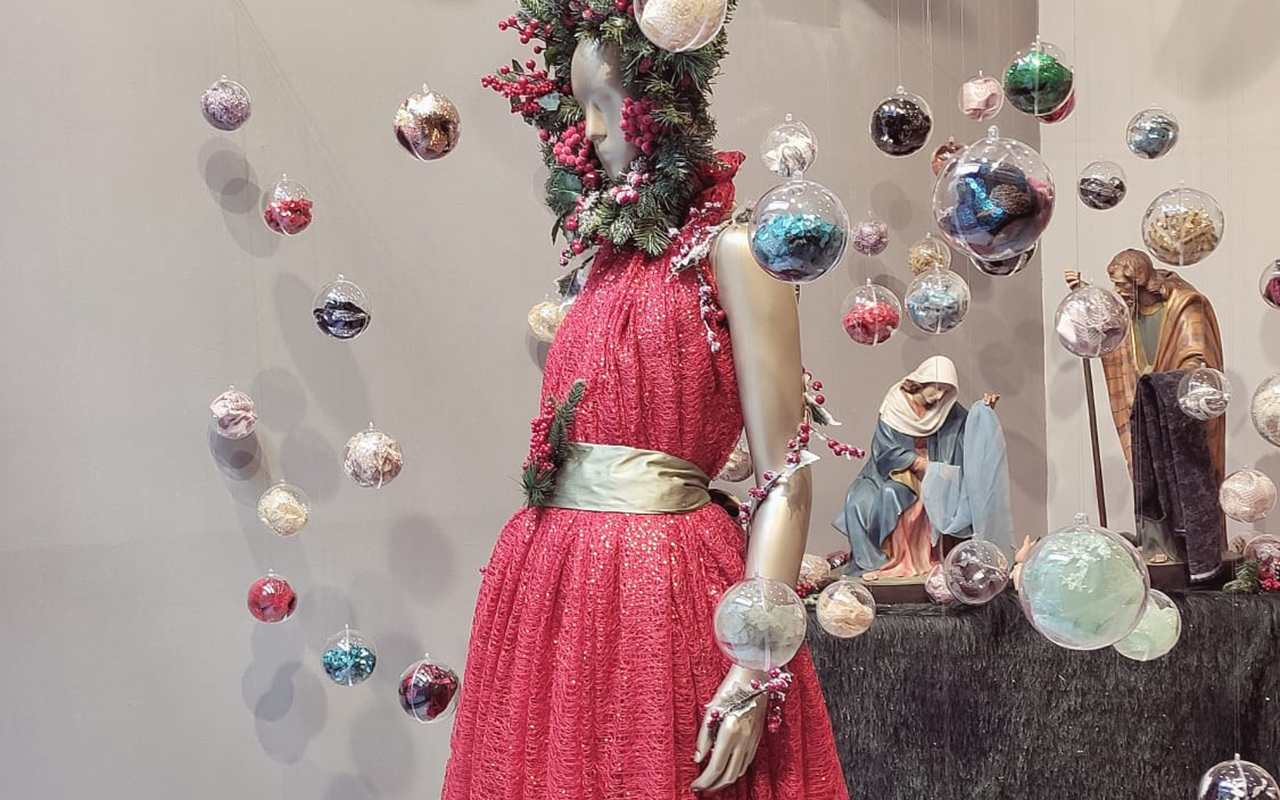
December 2022. Red Christmas
We say goodbye to the year with a classic tribute to Christmas. Crystal balls that enclose remnants of fantastic fabrics, the traditional nativity scene that reminds us that no matter how times change, there are customs that remain intact over time, and a spectacular mannequin in the centre dressed in red sequins with winter decorations that remind us that winter has already begun, despite being just as atypical as at the beginning of the year. What will 2023 bring us? Regardless of the desires of each one, we await the arrival of new shop windows that will surprise you and invite you to enter our space in Barcelona. Happy New Year!
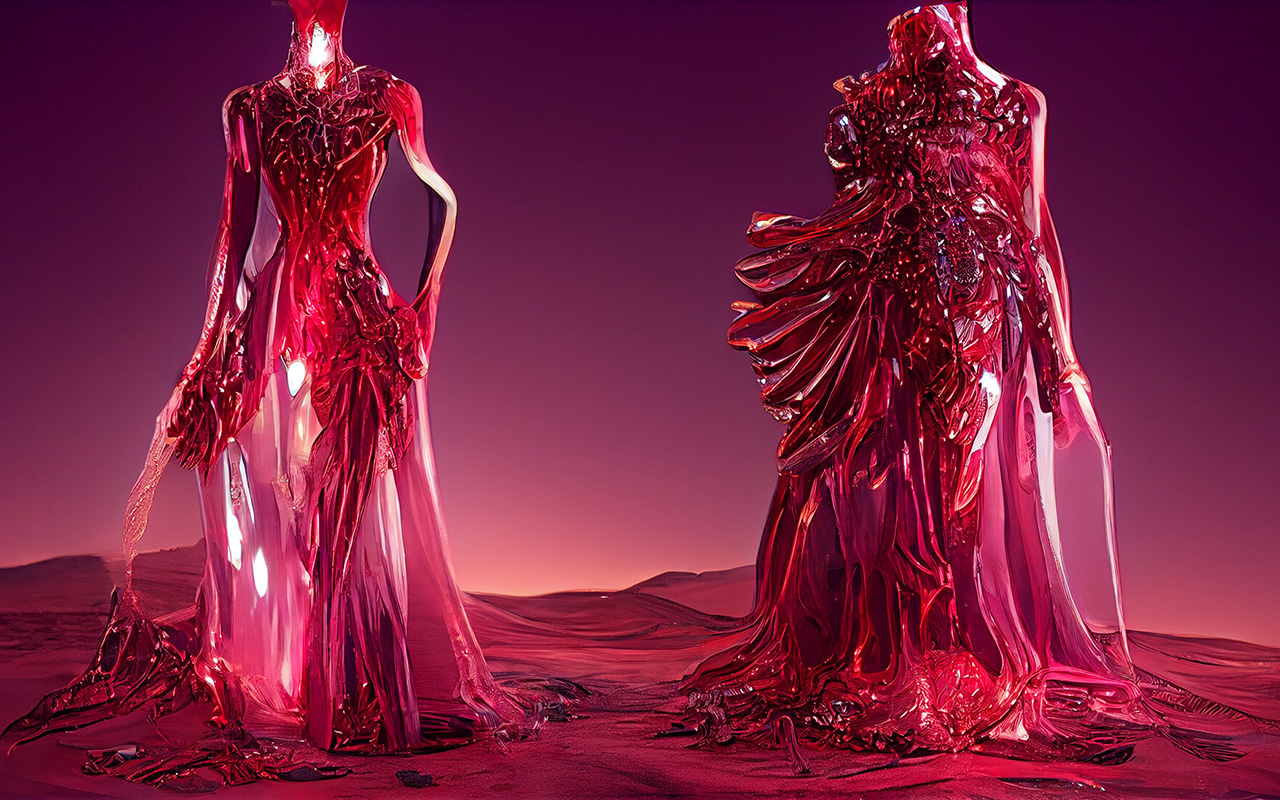 All About Viva Magenta, the Color of the Year 2023. Pic: Pantone
All About Viva Magenta, the Color of the Year 2023. Pic: Pantone
Is it rosy red? Reddish purple? Perhaps crimson red or rather, a deep raspberry hue. All these nuances that transition between red, pink and purple define the unique Viva Magenta , the colour that Pantone has chosen to guide 2023 and inspire disciplines related to art and design .“ It is brave and intrepid, and a pulsating colour whose exuberance promotes a joyous and optimistic celebration, writing a new narrative”, declared Leatrice Eiseman , Executive Director of the Pantone Colour Institute . Viva Magenta 18-1750, this is its technical name, is a tone that vibrates with energy and vigor. “A lively red that encourages experimentation and unrestrained self-expression. An electrifying, limitless tone that comes through with a bold statement,” said Eiseman .
“Viva Magenta promotes a joyful and optimistic celebration, writing a new narrative”
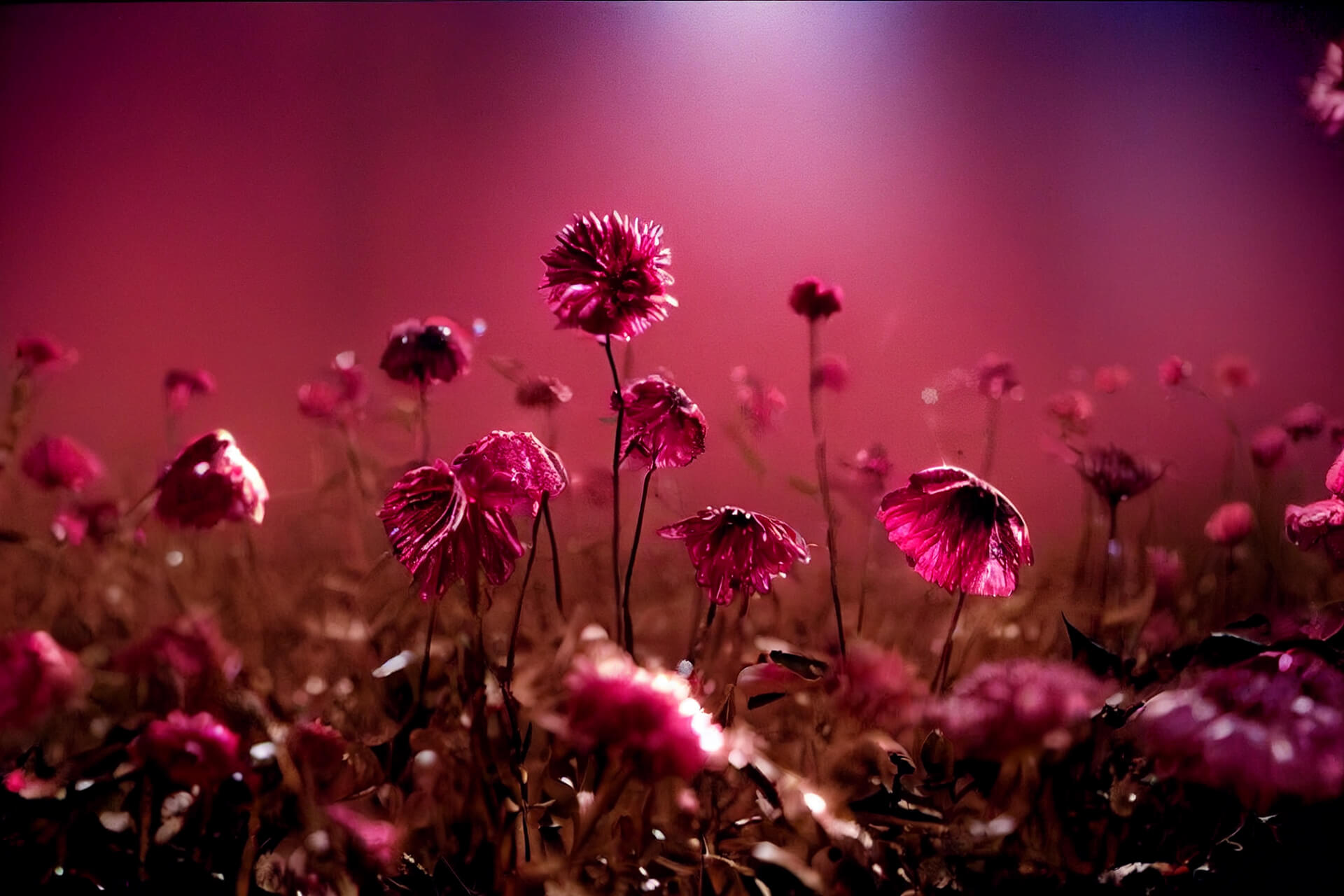
The arrival of this enigmatic red is not accidental. Pantone introduced the Viva Magenta shade in 2019, but it quickly rose in popularity to rise to stardom as the Colour of the Year 2023. This boom has been largely fueled by events in society in recent years. As Laurie Pressman, vice president of the Pantone Colour Institute , put it, “It’s an unconventional colour for an unconventional time.” The experience of Covid and its social and economic consequences have forced changes that, voluntarily or not, have transformed people’s lifestyles. And there, after two years of uncertainty expressed through cold tones ( Very Peri, 2022) or dual (Ultimate Gray + Illuminating , 2021), now comes a hybrid tone with enough personality to be able to light up 2023. Unlike its predecessor, Viva Magenta combines coldness and warmth in the same colour, and aims to mix the physical with the virtual, a dichotomy that cannot be more relevant today with the rise of virtual reality.
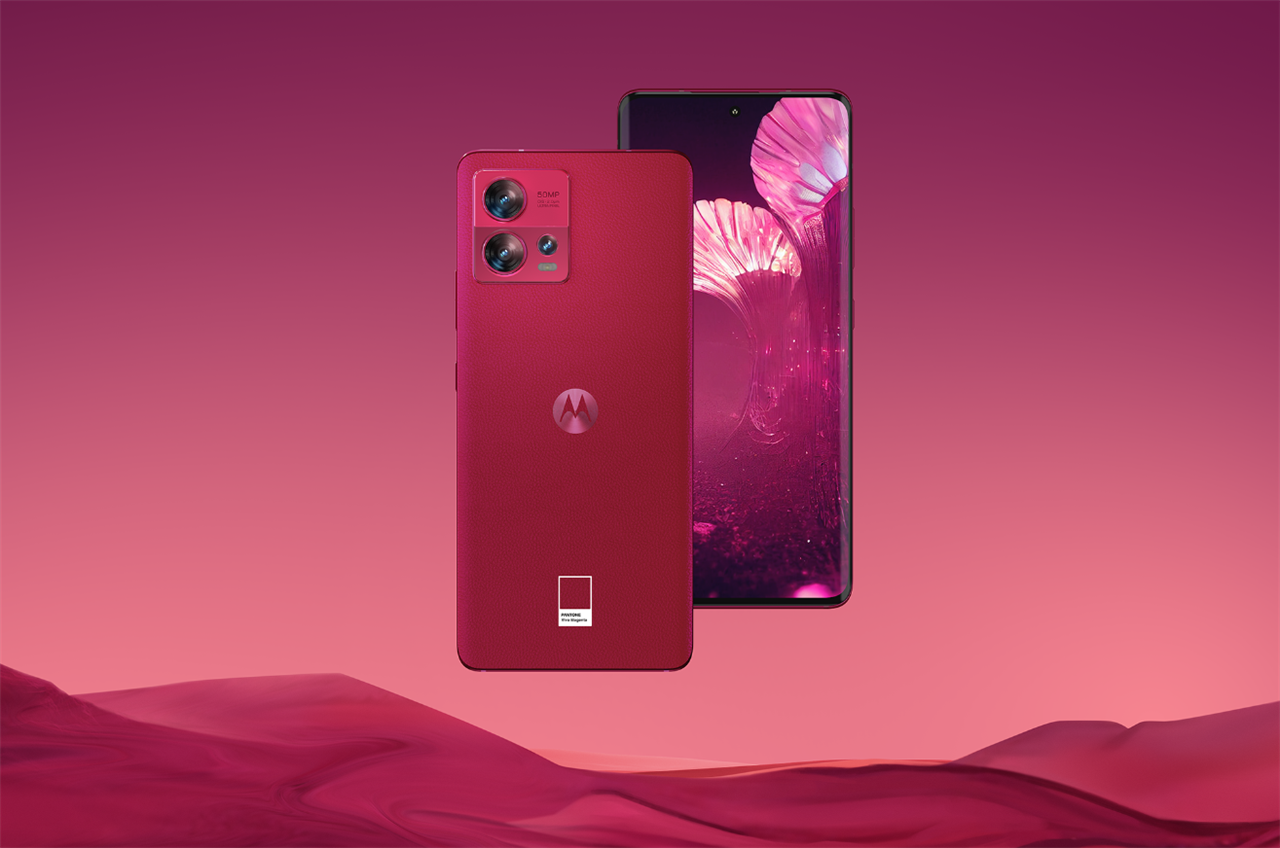
“It’s an unconventional colour for an unconventional moment”
Viva Magenta has already been spotted by trendhunters who work at the Pantone Colour Institute This choice is never the result of whim or chance, on the contrary, it is the result of a deep sociological and anthropological analysis of today’s society. Choosing the colour that will mark the year combines research, method and instinct. And magenta was there, in worlds as varied as fashion, cosmetics, concept store design , digital art, social networks or decoration. The question was, why pay attention to that carmine red that is already present in society and what emotional and psychological values is it transmitting? Pantone quickly looked up its meaning. According to the international authority on colour, in this era of technology, the aim is precisely to be inspired by nature and what is real. Pantone 18-1750 Viva Magenta is inspired by cochineal red, one of the most precious of all natural dyes, as well as one of nature’s strongest and brightest hues. Therefore, rooted in the primordial, the colour of 2023 reconnects with the original matter, revitalizes the spirit and helps build a new inner strength. “We set our sights on a colour that highlights our need to shift our perspective, highlights our desire to feel empowered, and gives us the strength to boldly, possibly, and fearlessly launch into a new path with complete confidence.” Pressman expressed.
“We have set our sights on a colour that makes us want to feel empowered”
Seen this way, Viva Magenta is a hue that is presented as a revitalizing balm that connects our interior to project ourselves strongly to the exterior.
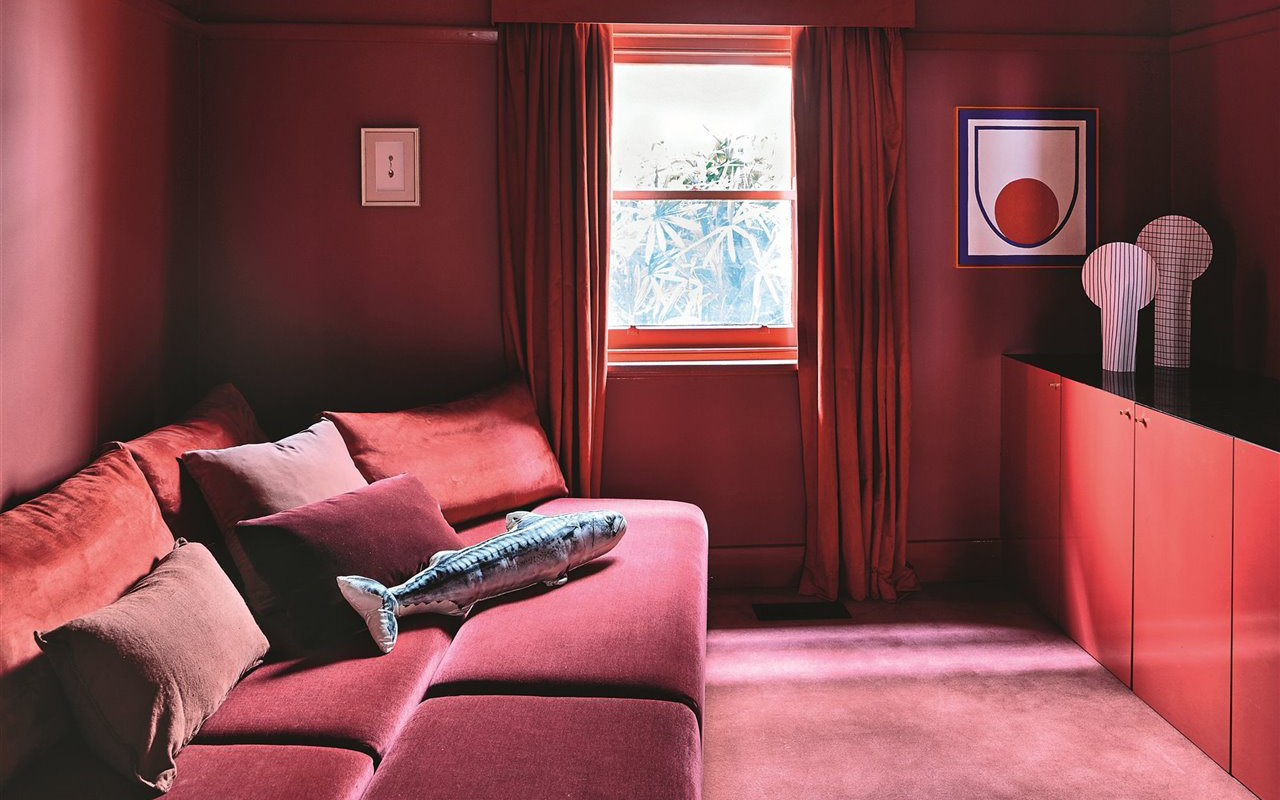
How to apply Viva Magenta in our daily lives?
Reddish tones and explosive mixtures such as intense pink-red have been imposed everywhere, from the catwalks to the metaverse, and where it has the most possibilities of expansion is in interior design, be it a private home or a commercial establishment. According to Eiseman, kitchens (and appliances), which have long harbored a respect for red, can now be imbued with “a touch of novelty” through Viva Magenta and its ability to break away from the “same red hue of always”, which defined previous generations. Pantone 2023 colour is also suitable on glassware or any other reflective surface, and can even nestle in cushions and other small decorative items to make a “beautiful, dramatic and theatrical statement” in your home. Although such a lively colour can intimidate or condition the current of neutral tones that are prevailing in decoration, the truth is that Pantone affirms that consumers are more prepared than ever to begin to embrace all the possibilities of colour.
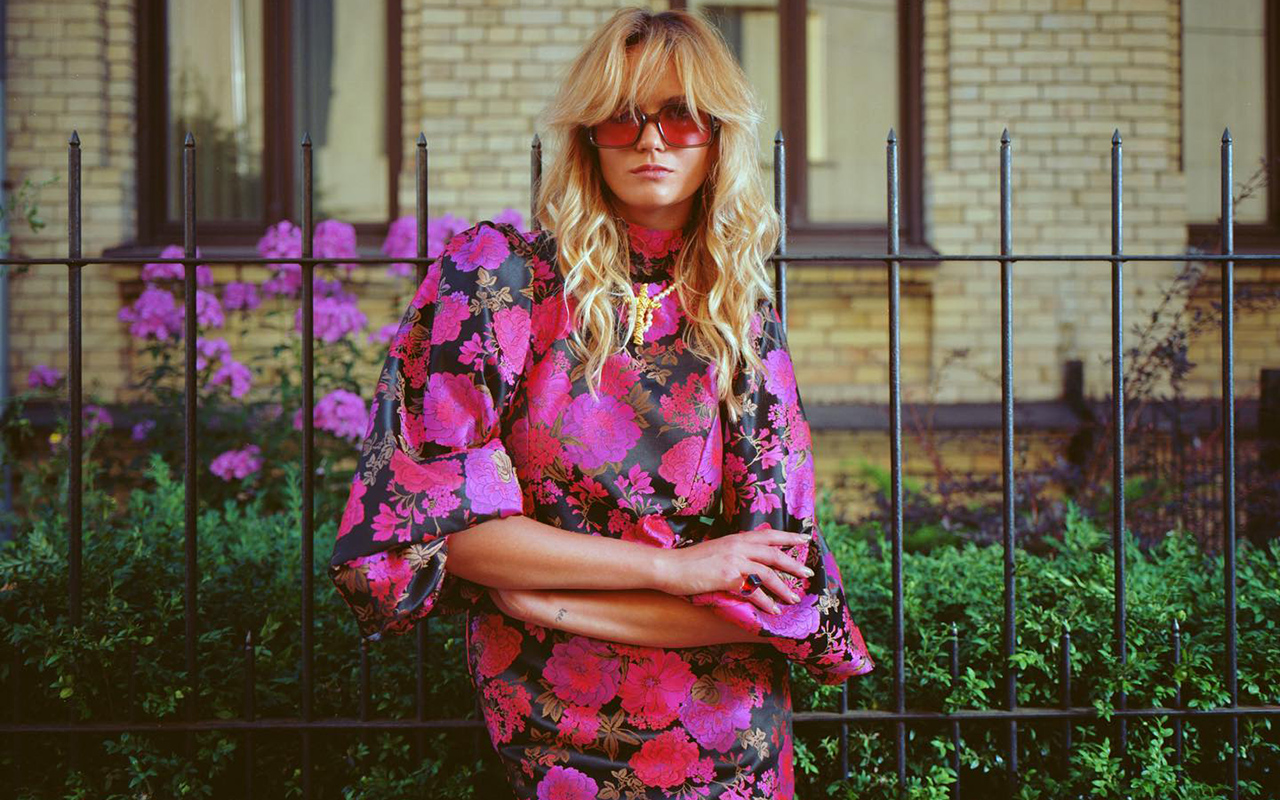 Acuamona AW22/23. Pic: Acuamona
Acuamona AW22/23. Pic: Acuamona
And in fashion, how is it appreciated?
There is no doubt. The fashionable colour of 2022 has been the brightest fuchsia pink, a faithful ally of Valentino and its explosive Pink PP shade, and emblem of the entire Barbiecore aesthetic. Now, Viva Magenta is presented as a natural evolution of that hue, providing less stridency and keeping its magnetism intact. In truth, red has been one of the most repeated tones on the winter catwalks and for summer it returns with force, but it remains to be seen how the next collections that are being developed for 2023/2024 evolve so that Viva Magenta appears even more strength.
As the powerful colour that it is, Viva Magenta does not go unnoticed and takes centre stage in any outfit, even if it appears in small doses. On the one hand, it feels perfect surrounded by neutral tones such as black or white, or both together. They are the colours that best suit you with effortlessly flattering looks. On the other hand, for a more groundbreaking result, the colour of 2023 combines with its chromatic range: pastel pinks, lilacs or fuchsias, and also with complementary blues or greens, providing a touch of rebellion and transgression. In any case, if fashion needs a dose of optimism, strength and joy, to move forward it will inevitably embrace Viva Magenta. We’ll see it…
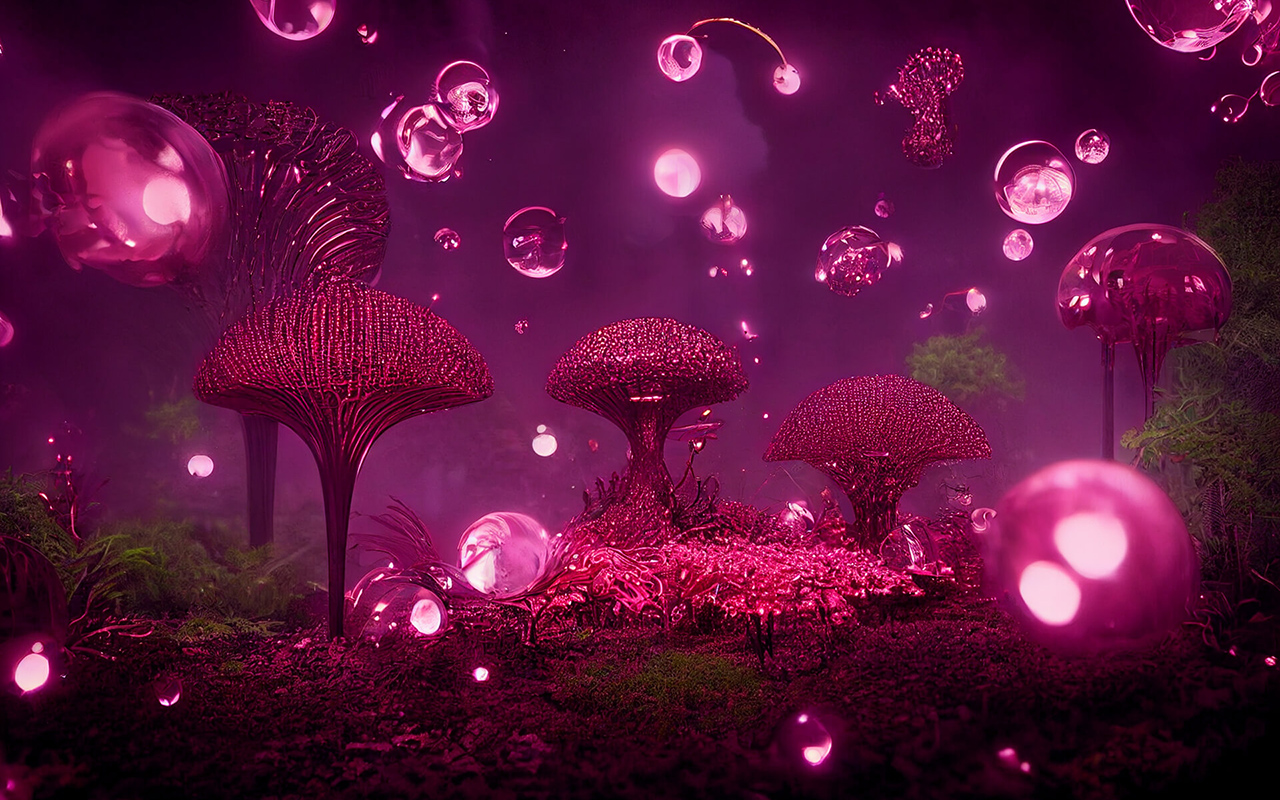
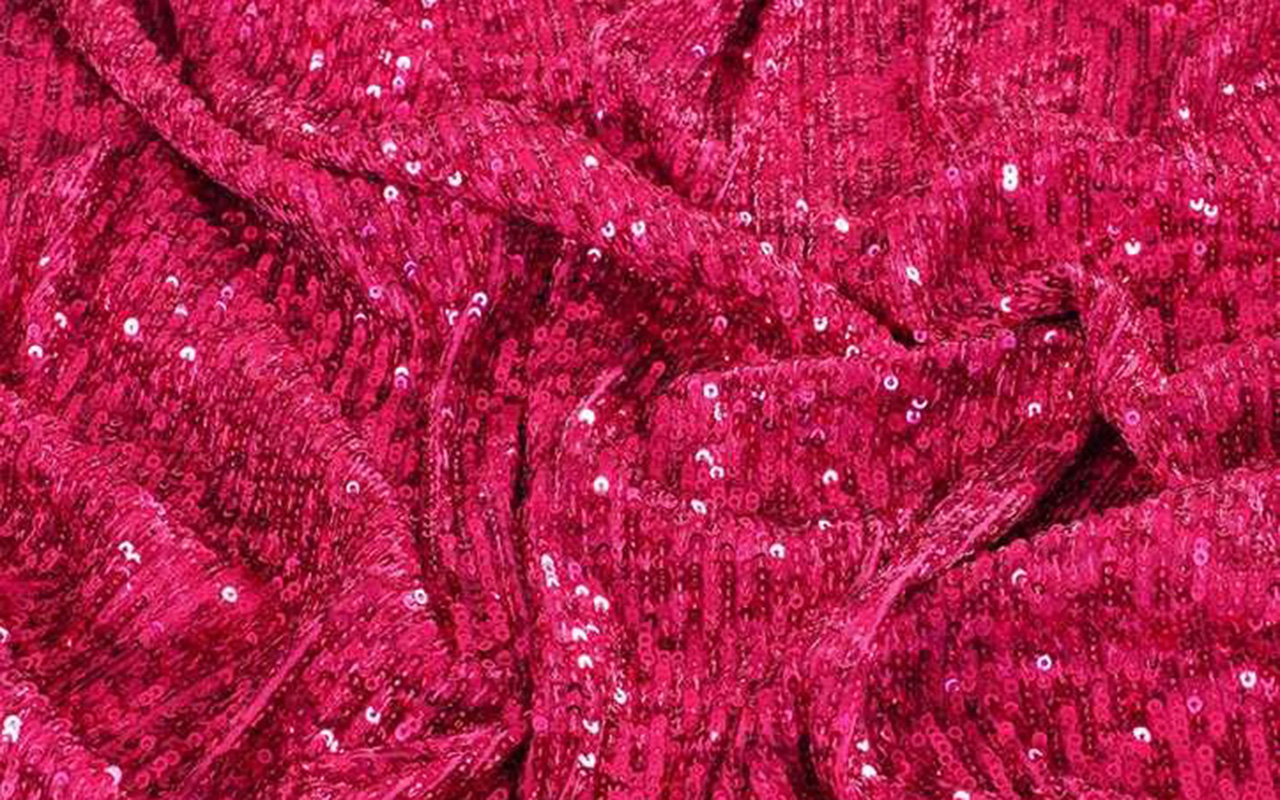
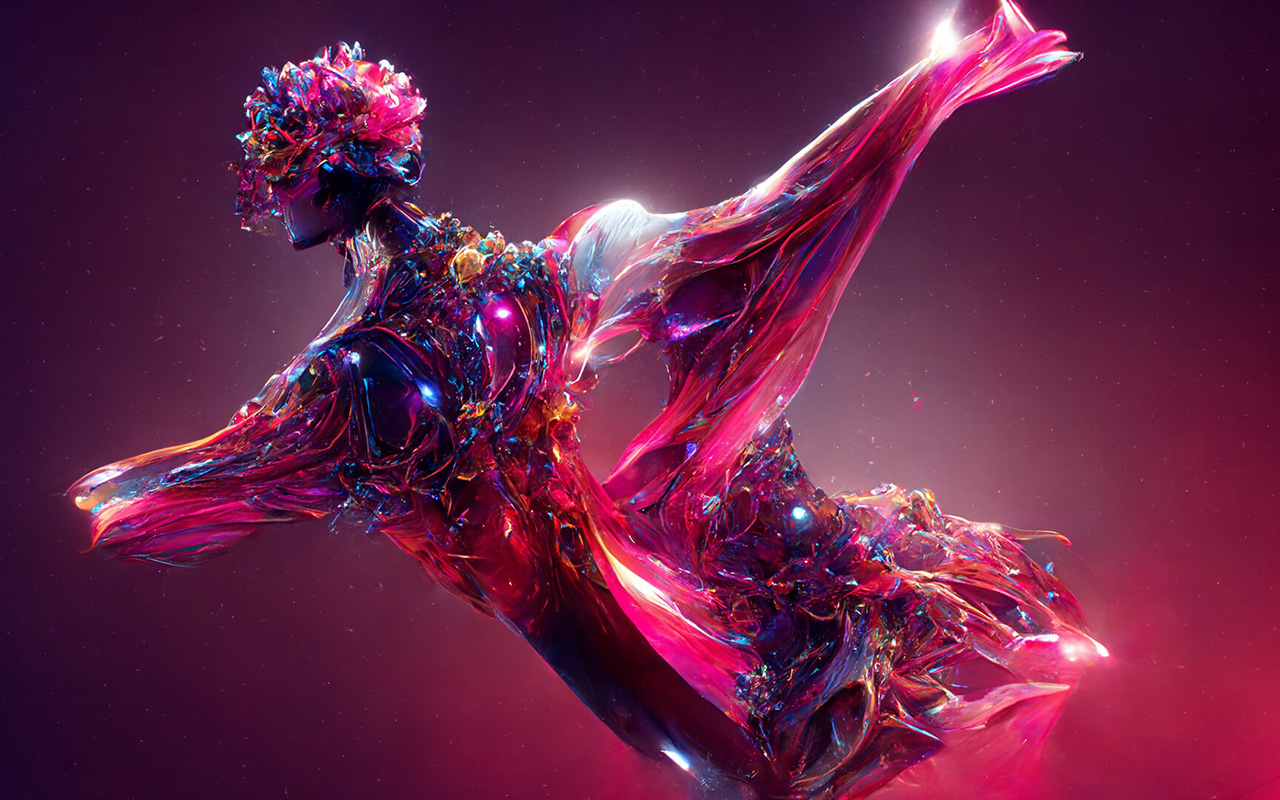
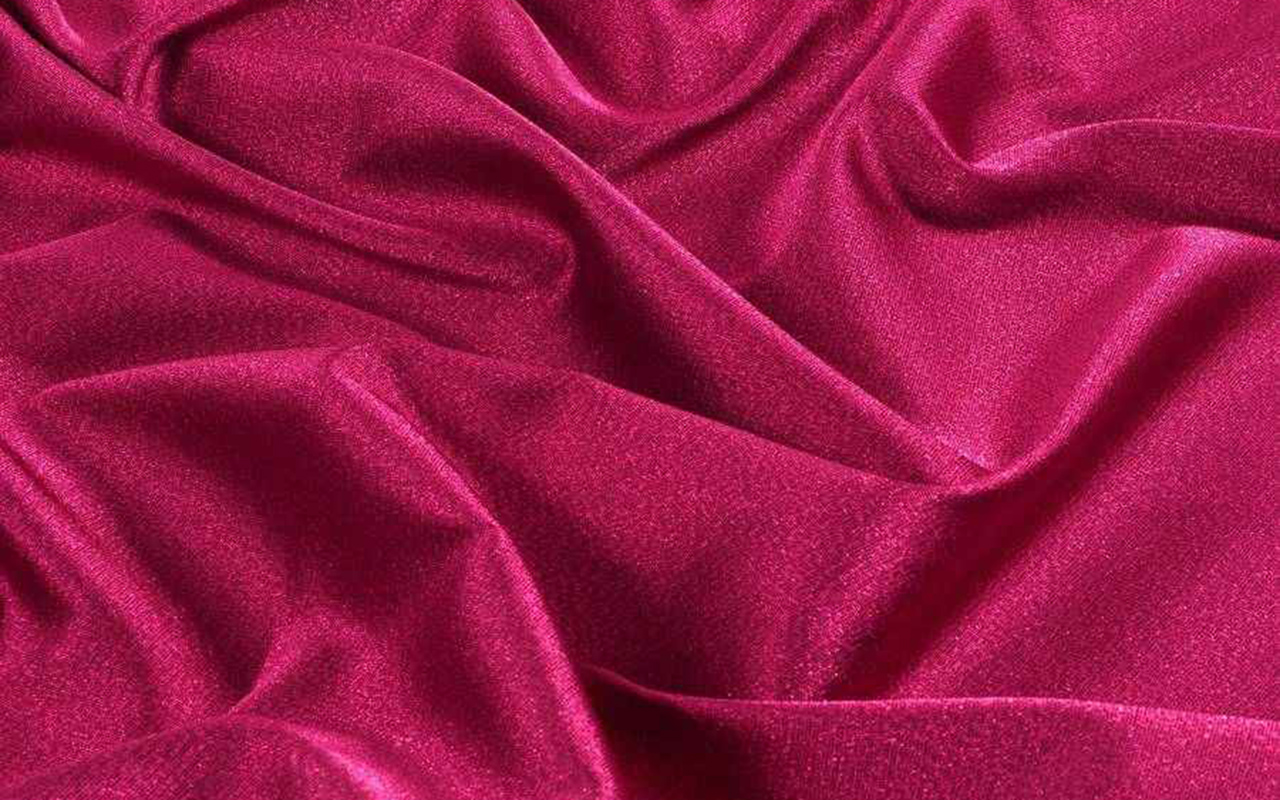
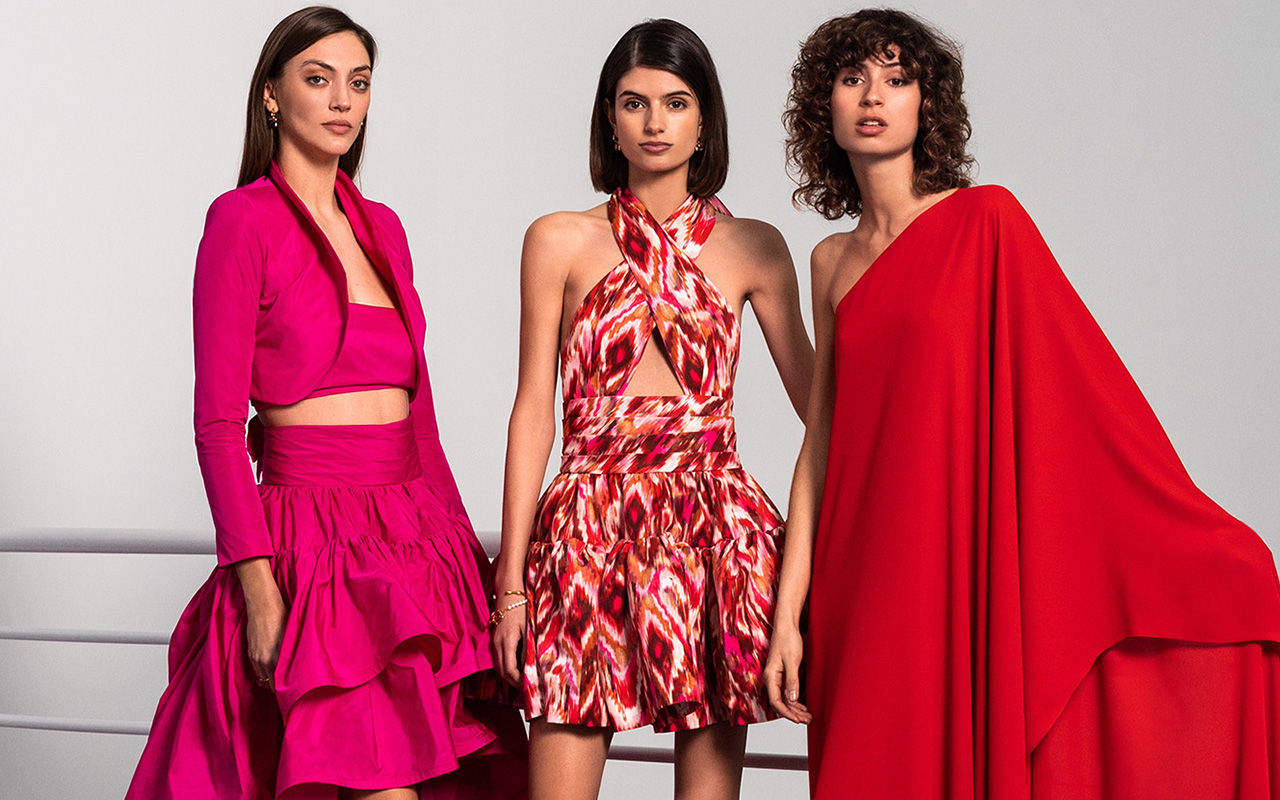
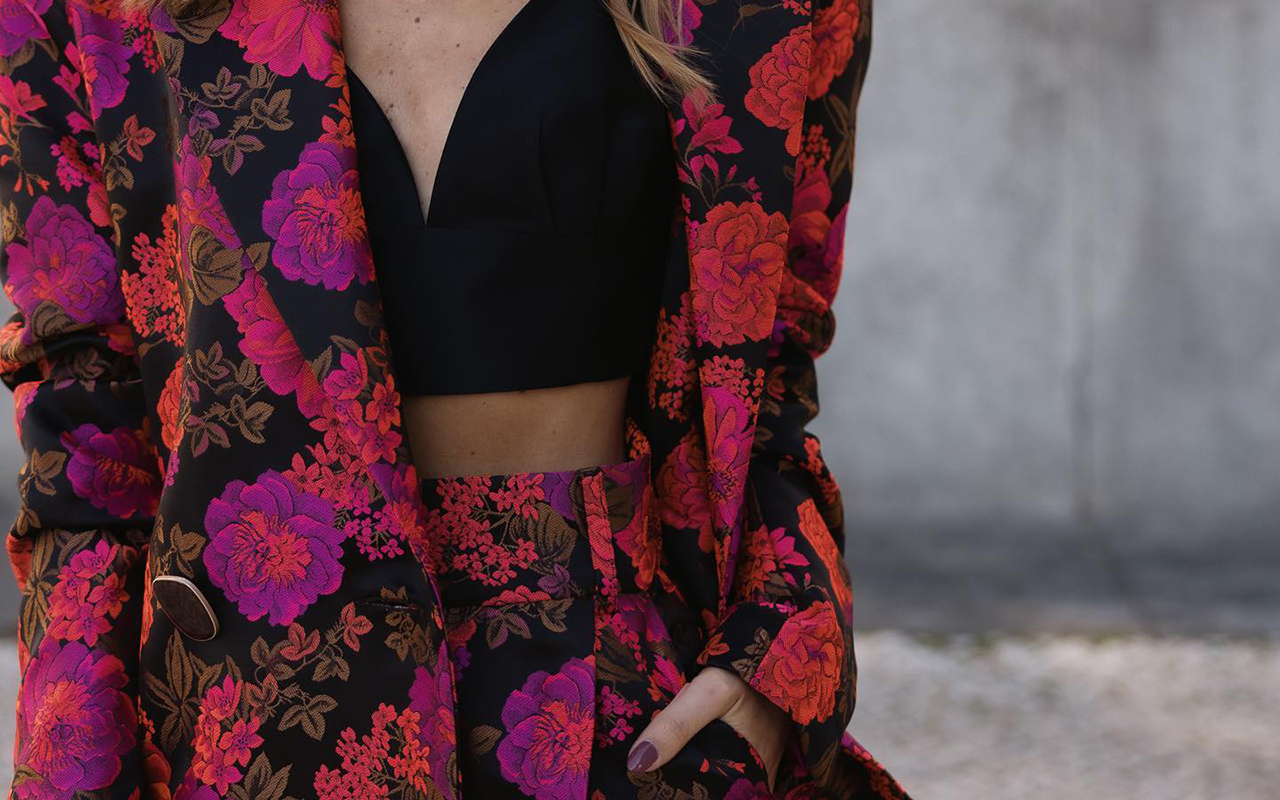
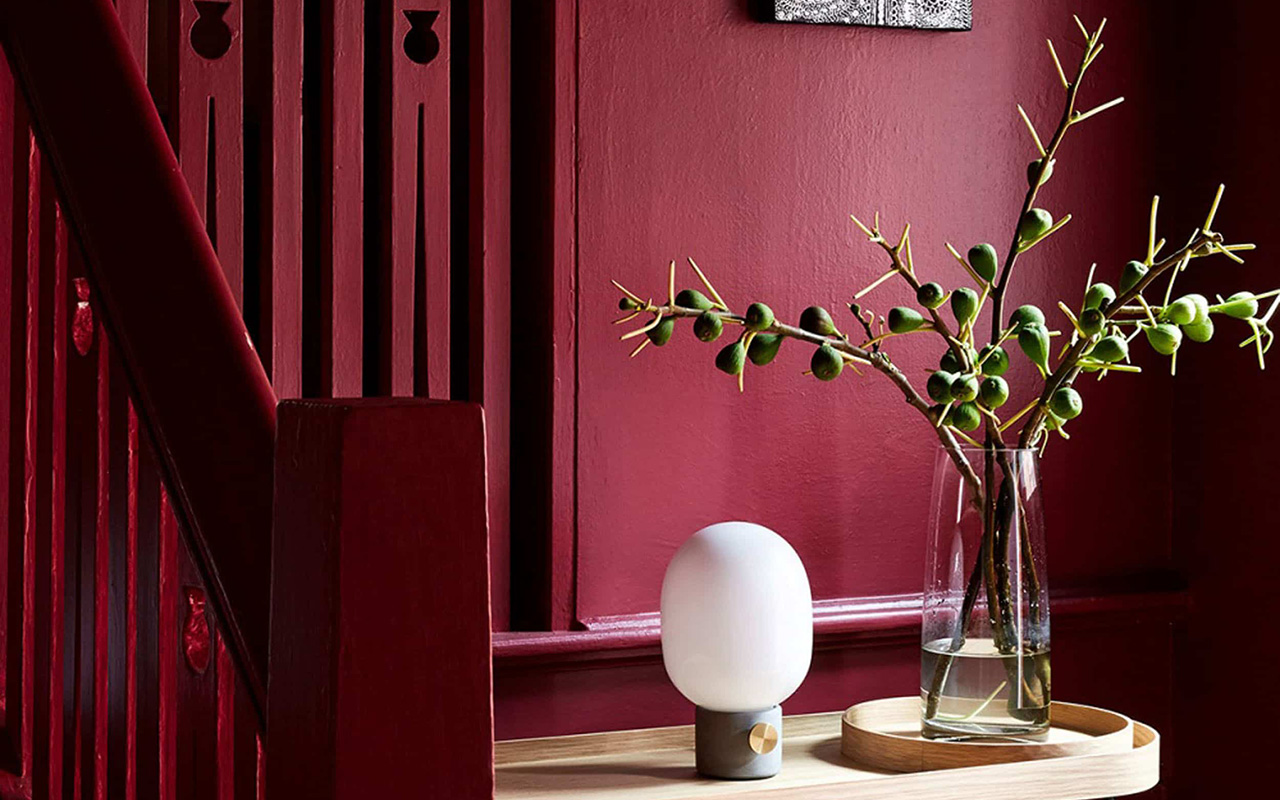
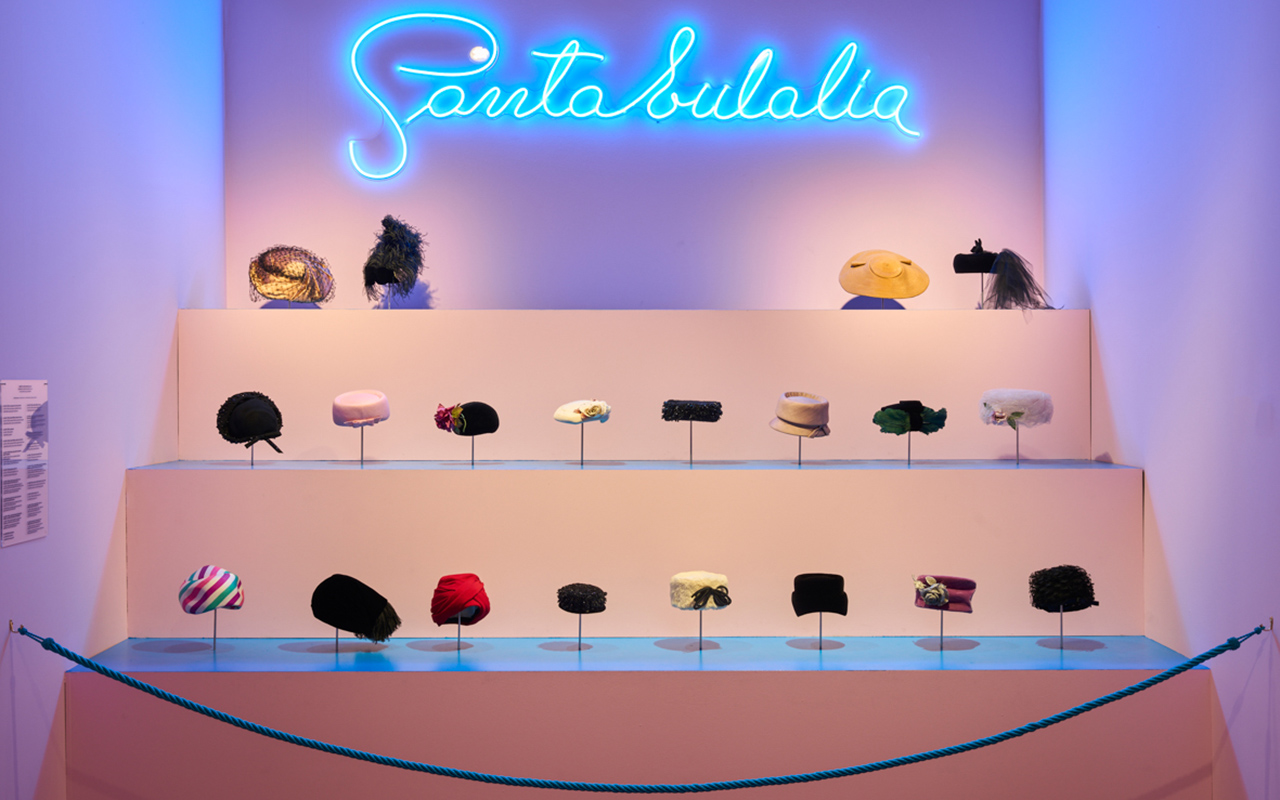
As a family-owned fabric company that blends tradition with innovation, we’re enthusiastic about long-standing businesses that have that respect for heritage, without losing sight of essence or curiosity to see out new things. Saint Eulalia It is one of those houses that has crossed generations and has established itself on its own merit as a reference emblem in Barcelona and abroad for elegant fashion. Now, an exhibition premiered in Palau Robert pays homage to her career through the most representative dresses of the golden years of haute couture in a brief but symbolic tour where the beauty of the festive models are the protagonists of this unique sample of anniversary.
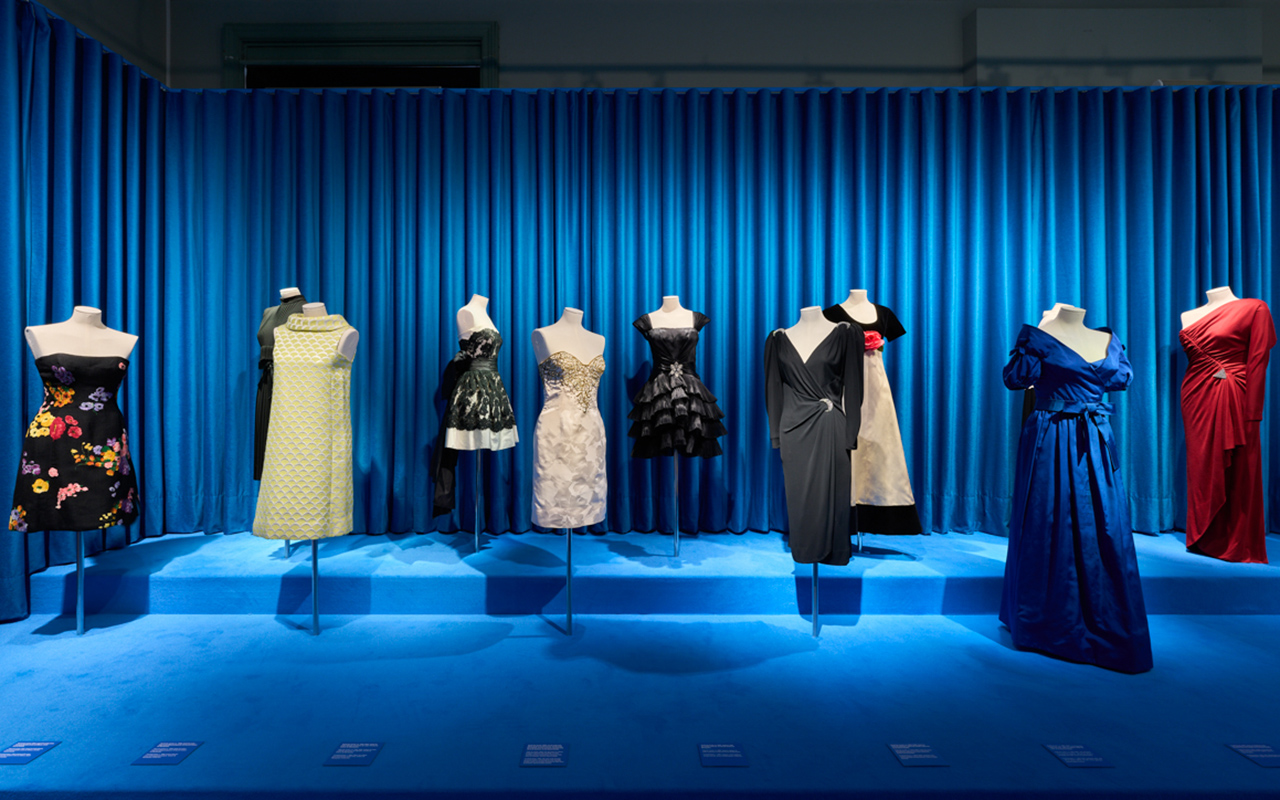
A brief historical tour
The history of Santa Eulalia is intertwined with the story of Barcelona. It was originally founded in 1843 and was installed in Calle Boqueria as a textile store. Over the years, the space changed and the business expanded to also house shirts and tailoring made to measure. With the fall of the medieval walls of the city and with the urban projection of the new Ensanche, where the Catalan bourgeoisie quickly settled, the establishment moved at the beginning of the 20th century to Paseo de Gracia, where it is currently located. There is a date that marks a before and after: 1926. It was when Santa Eulalia held the first haute couture show, being a pioneer in Barcelona of this new formula from Paris for presenting fashion. An initiative that took place fruit of the talent of Pedro Formosa, creative director of the house until 1970. Since then, the most elegant handmade dresses and hats in the city have come out of his workshops and have dressed the wealthy classes of Barcelona and beyond. Good art and know-how in clothing arose from the Santa Eulalia workshops thanks to the meticulous craftsmanship of the tailors and dressmakers who worked to create exclusive designs for their distinguished clientele. There is another date that deserves to be remembered that denotes the work and prestige of the establishment. In 1941, Santa Eulalia formed part of the Cooperativa de Alta Costura and led fashion together with Pedro Rodríguez, Asunción Bastida, Manuel Pertegaz and El Dique Flotante, recognized as the Big Five of Spanish Couture; honors that they shared, in parallel, with Cristóbal Balenciaga.
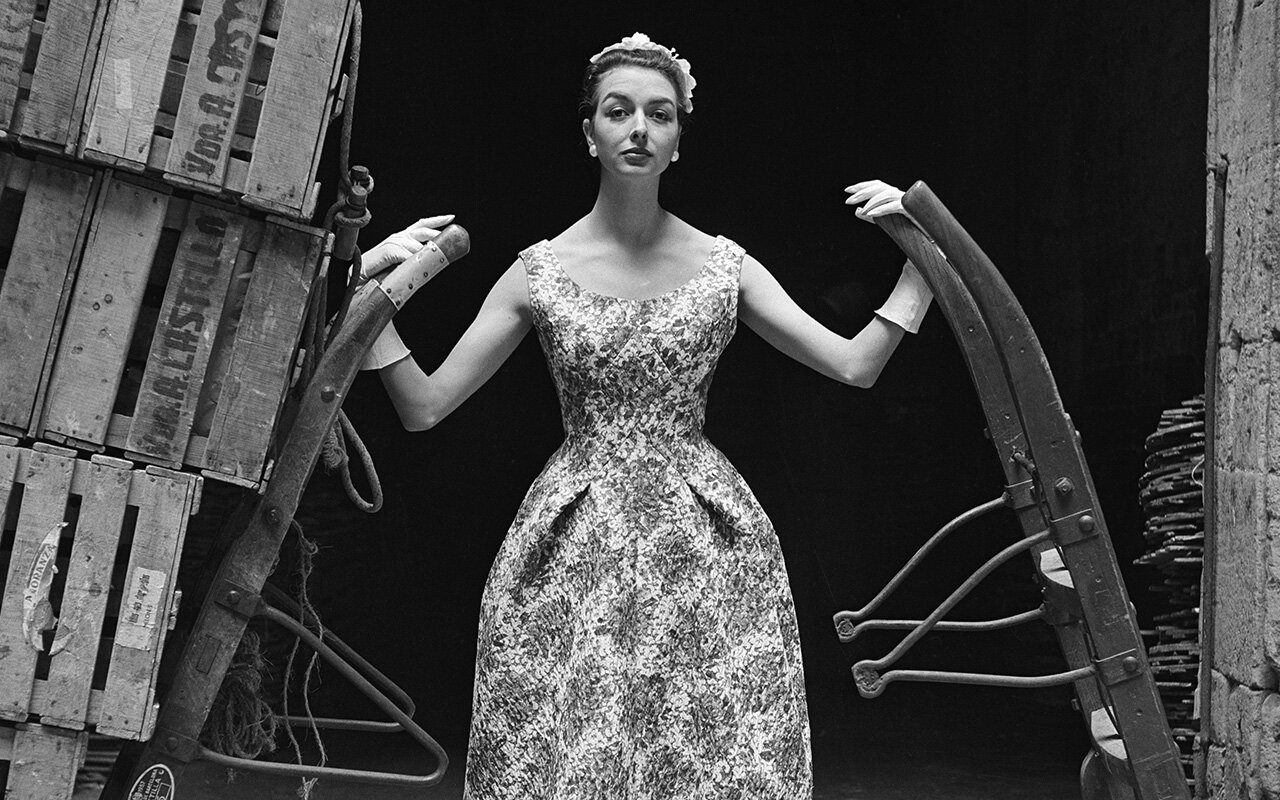
The legacy through the dresses
Under the name ‘Santa Eulalia, 180 years of fashion’, the exhibition proposes a journey of 70 years (1930-1990) to enjoy a time in which Barcelona, with Santa Eulalia as a reference, was a leader in fashion design. Throughout four different rooms, organized by types of Street and Day, Night, Long Dresses and Brides, the visitor will be immersed in the wonderful world of Haute Couture through carefully selected dresses and hats, as well as one audiovisual piece that also includes advertising posters, fashion photographs and communications from Santa Eulalia that evoke the golden age of Haute Couture.
The exhibition has been led by Josep Casamartina, a renowned art historian specializing in the history of fashion, who has structured a fascinating journey bringing together 40 pieces (of the 500 pieces recovered) not only from the Santa Eulalia own archive but also others from the Fundació Antoni de Montpalau, the Barcelona Design Museum (DHUB), the Terrassa Textile Museum and Documentation Centre, and the Madrid Costume Museum.
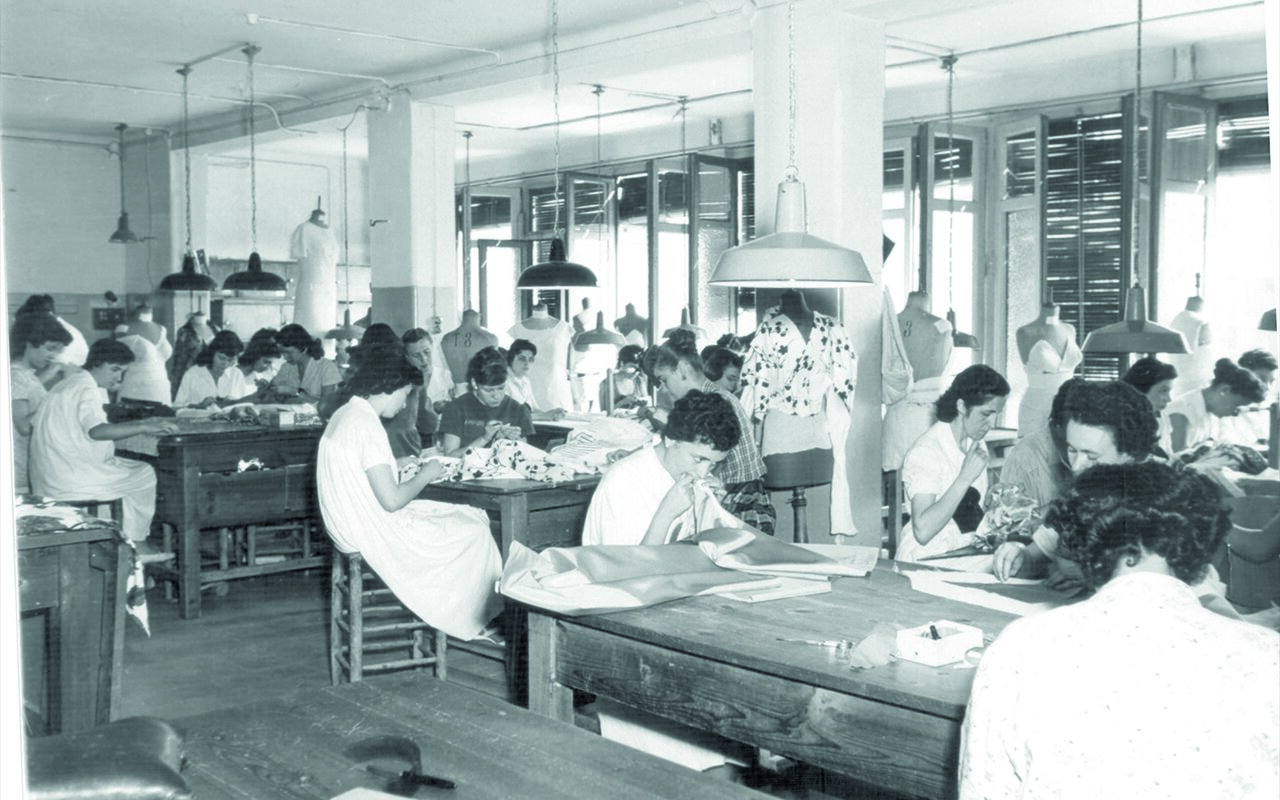
All the dresses recreate the beauty of the craftsmanship of Santa Eulalia characterized by a very refined pattern and quality fabrics perfectly turned into elegant designs far from the stridency, which maintain contemporaneity over the years. There are designs that bear witness to a time of celebrations: dances, cocktails, evening gowns or operatic premieres at the Barcelona Lyceum, brought together the women of the time in society and were special occasions to wear a Santa Eulalia dress for the first time. . The evolution of the models, according to the trends of each decade, feminine details or fantasy elements are present throughout the exhibition.
On the other hand, the creative and scenographic direction has been carried out by Nacho Alegre, who is in charge of the Apartamento Studio project. Alegre has also been the editor of the catalogue that accompanies and collects the content of the exhibition in an absorbing retrospective that brings together fashion photographs, historical archive material and previously unpublished objects from private collections. The catalogue is published in a limited edition of 4,500 copies and can be found both in Palau Robert and Santa Eulalia and in selected bookstores. The free access exhibition will remain open until the 22nd January, 2023.
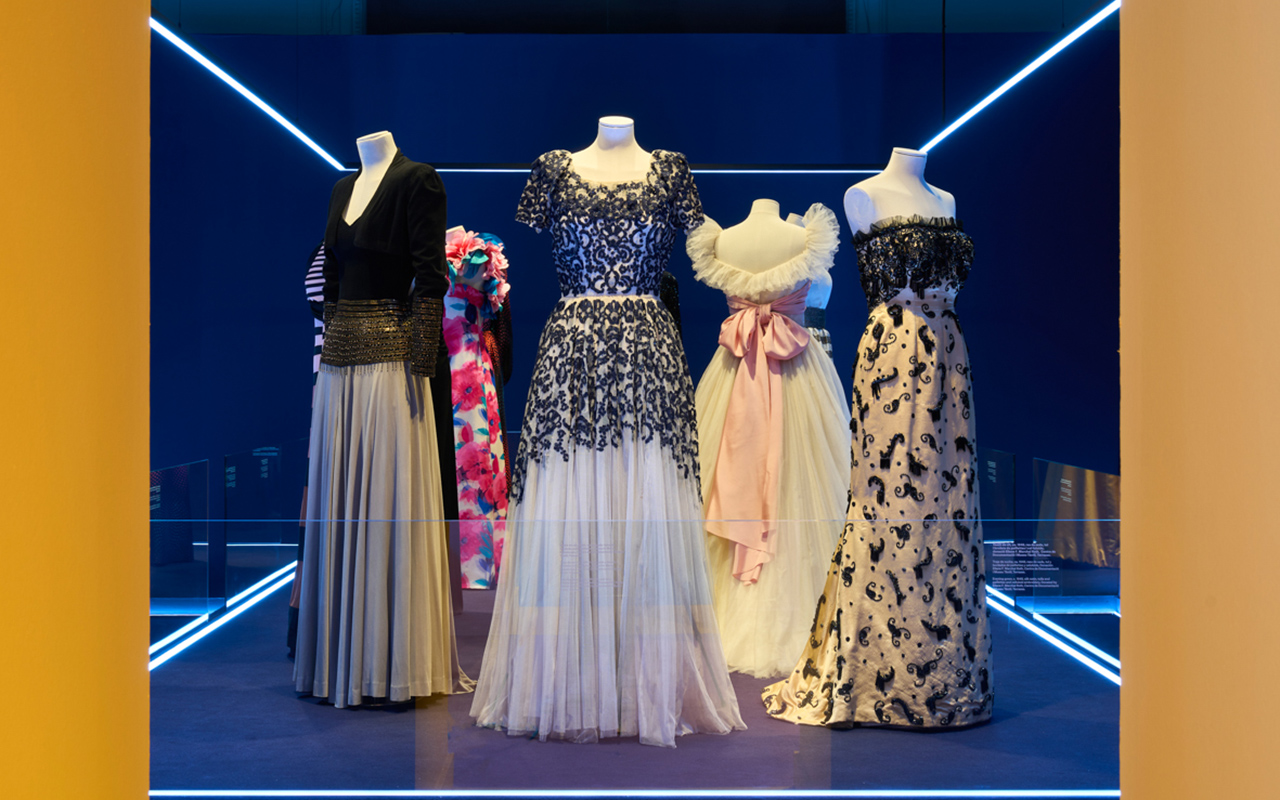
Santa Eulalia, today
Today Santa Eulalia maintains its status as one of the most influential fashion stores in the sector internationally and continues to be a benchmark for luxury in Barcelona. The establishment, which each season offers the collections of the international designers most desired by the new generation of consumers, is currently led by Luis Sans, a member of the fourth generation of the owner family, and his wife Sandra Domínguez. This marriage, which is also a business one, adapts to the new times to maintain the artisanal essence and the good knowledge of Santa Eulalia, without losing sight of the latest trends that are triumphing in the market.
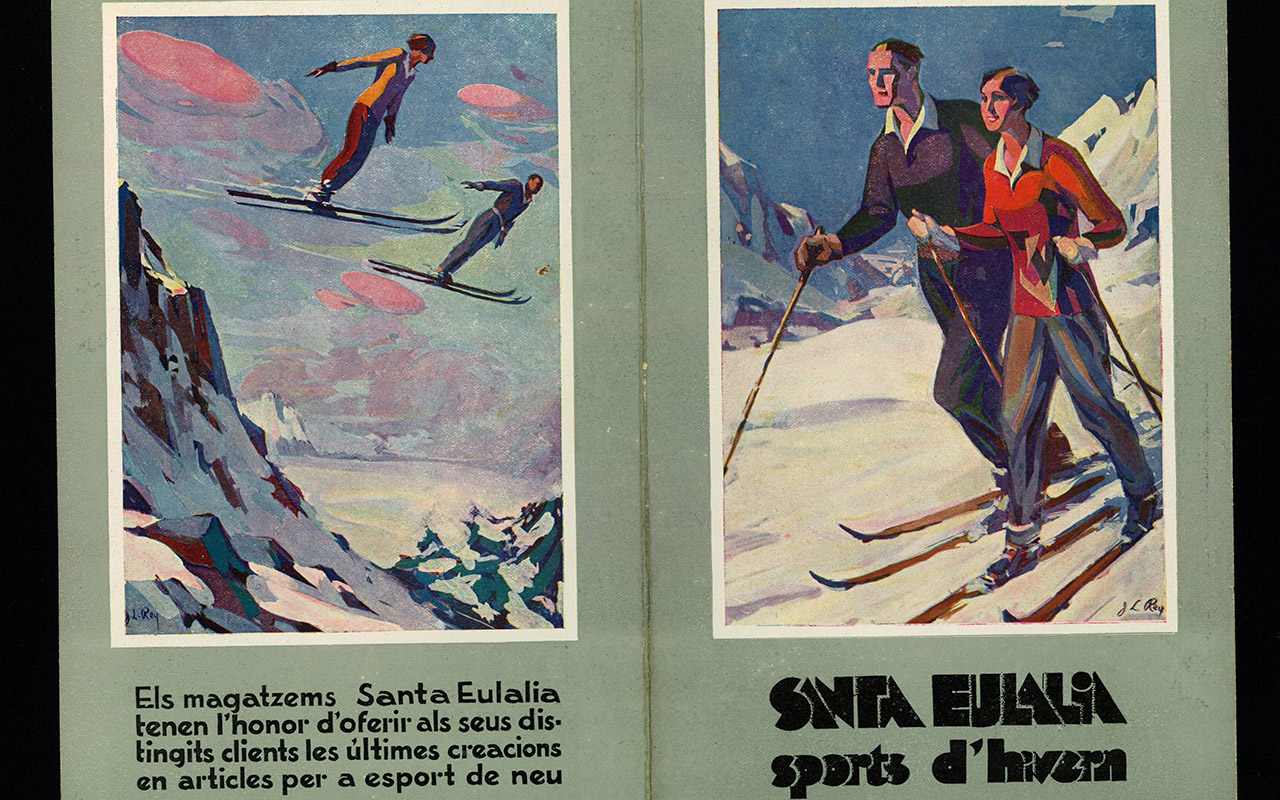
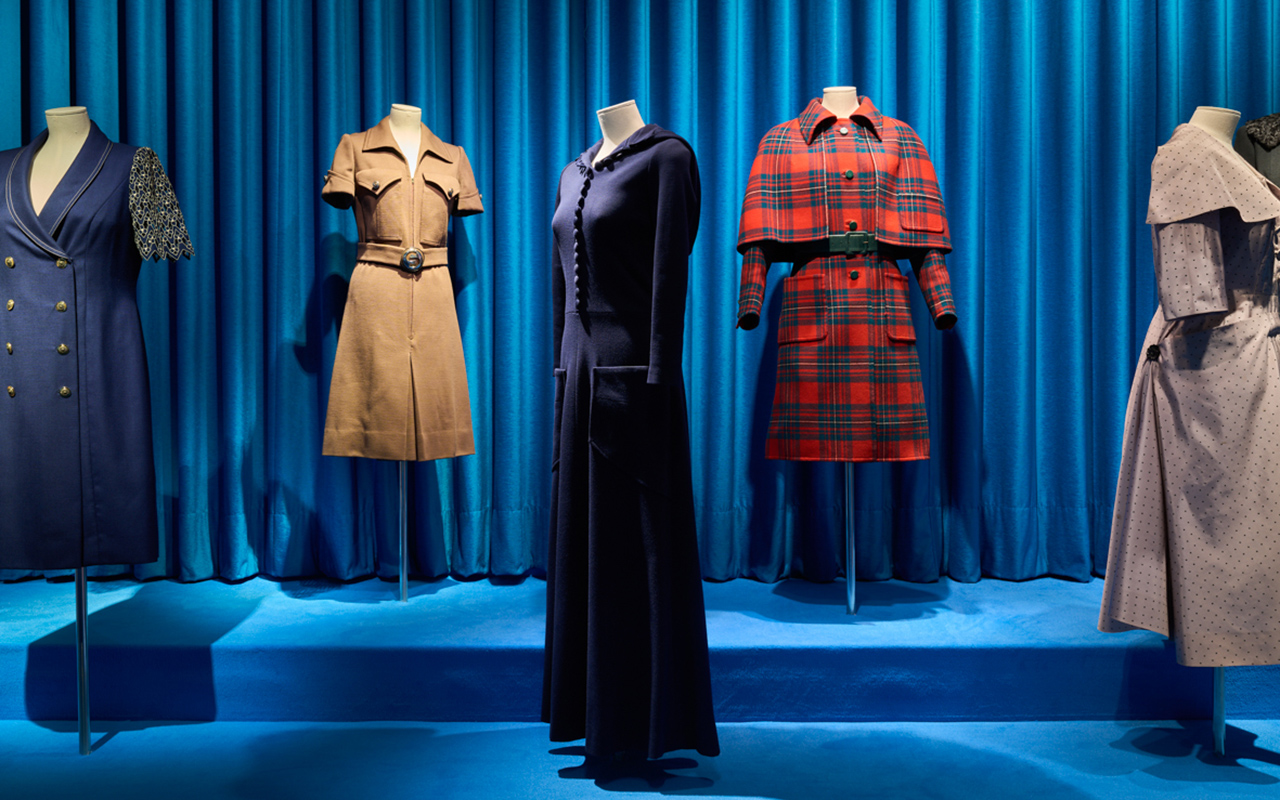
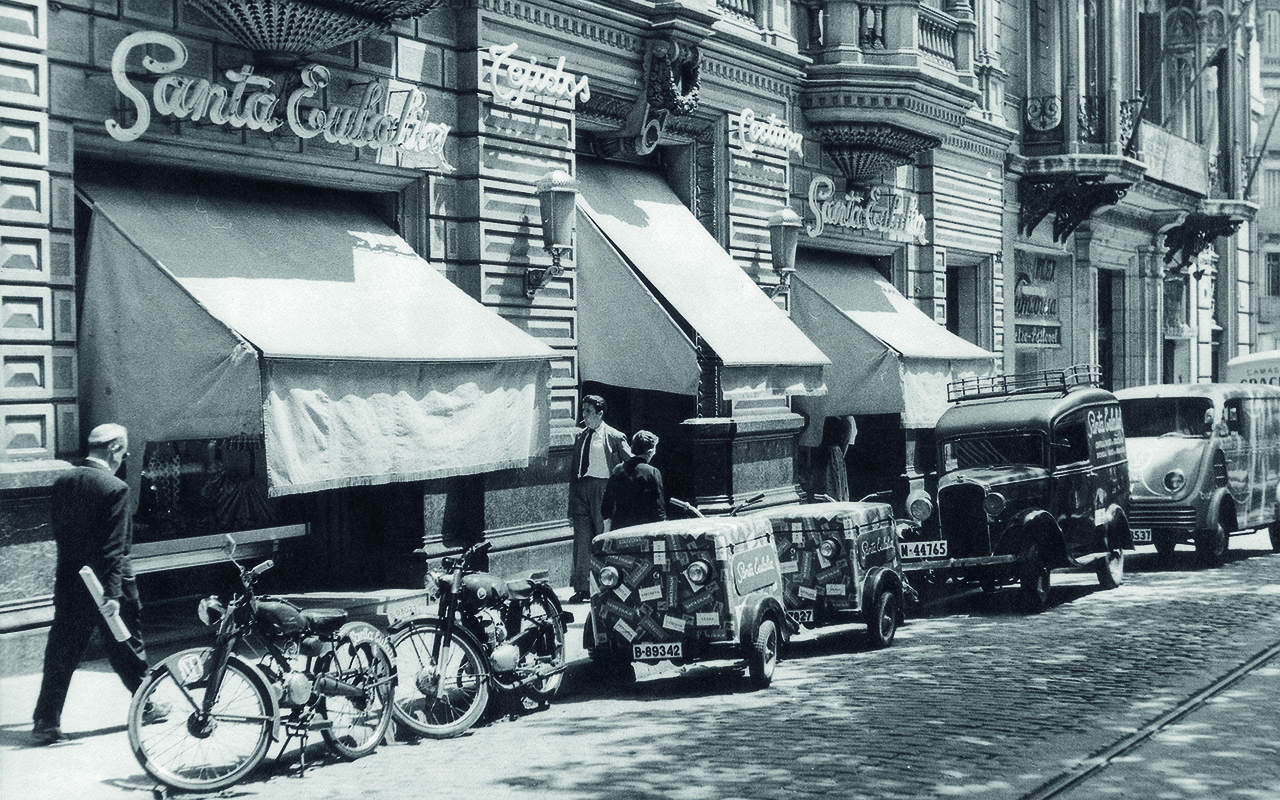
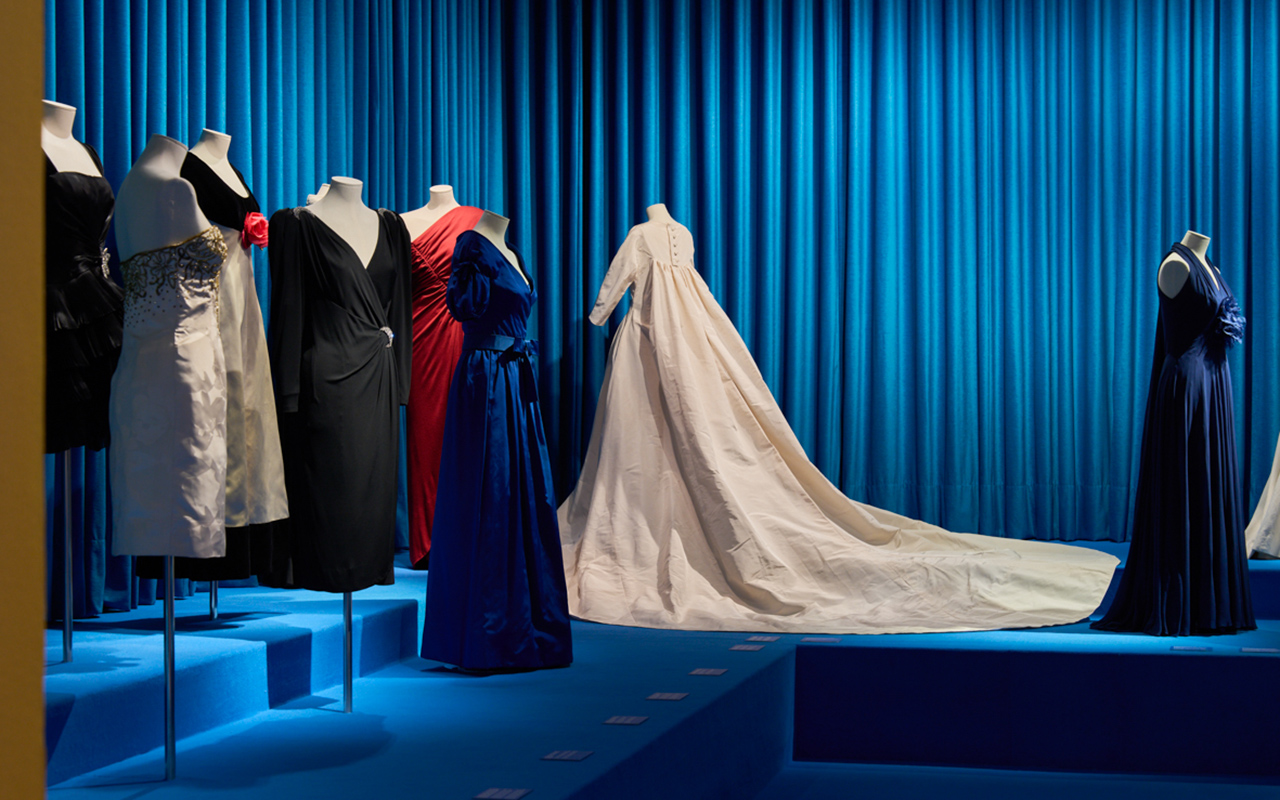
Viernes 04 noviembre 2022
Sorry, this entry is only available in Español.
Mi�rcoles 05 octubre 2022
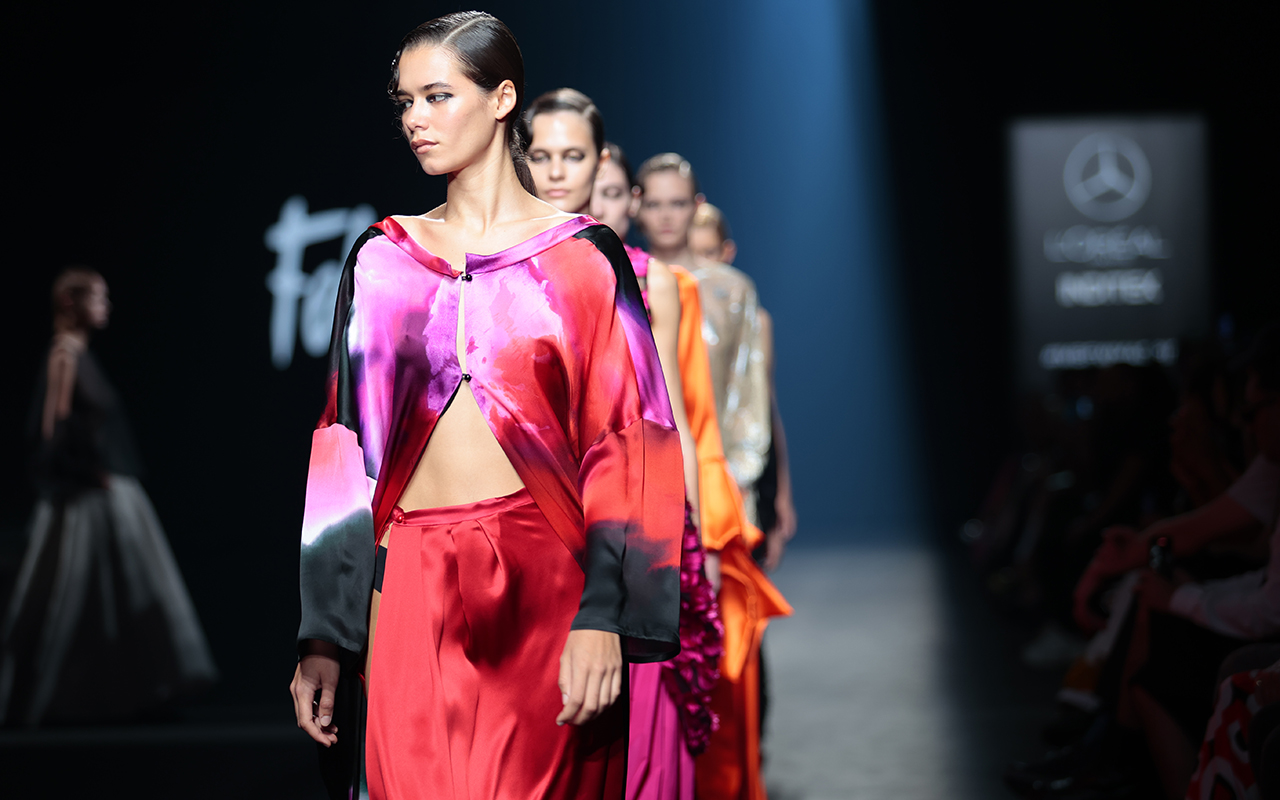
Fely Campo. Spring-Summer 2023. Pic: Gus Geijo
Gratacós has shone with its own light at the Great Spanish Fashion Week by stepping on the Mercedes-Benz Fashion Week Madrid catwalk, held in mid-September. Evidently, this has ocurred so indirectly through designers who are regular users of our and who have once again trusted in our know-how to create the magnificent collections for the coming summer season. In this edition we want to especially mention the collaboration that our family business has made with the designer Fely Campo in an urban and sensual SS23 proposal, where luxury is appreciated in every detail. Not only the creator from Salamanca has relied on Gratacós fabrics to devise works of art in movement. Other designers have also supported us, such as Álvaro Calafat, Aurelia Gil, Duyos, JC Pajares, Isabel Sanchís, Malne, Maison Mesa, Odette, Pilar Dalbat and Redondo Brand. To follow, we expose some details of each collection and also more details of the exhibited looks.

Fely Campo
Fely Campo understands fashion as “a tireless search for beauty”. A language that moves perseveringly and in which the designer from Salamanca finds the balance between the silence and the noise of our current way of life. Under this inspiration, the creator transmits in ‘Nagore’ an idea of sensuality that aligns with the frenetic urban rhythm of cities like Madrid, Tokyo or New York. Surprising cities in full vibration with which Campo alludes to notions such as the maelstrom, vibration and drive, but also evokes other values such as stillness, subtlety and desire, through fabrics, patterns and silhouettes that want to participate in this urban bustle.

Thus, ‘Nagore’ is a luxury prêt-à-porter collection with which Fely Campo wants to represent the movement of our current rhythm of life. To do this, the designer, who has been dressing women from all over the world for more than 40 years, creates a contemporary image based on the concept of fluidity with ductile and versatile garments that reflect the feelings of today’s woman who is looking for Spanish author fashion aware of the need to consume sustainable fashion. Following her elegant and sober style, Fely Campo clings to an excellent pattern design with silhouettes that love subtlety, fabrics that become vulnerable to movement, exuberant floral prints and in a rich colour palette that ranges from neutrals: whites, light grays and black, to the radiant shades of fuchsia, orange and red with metallic nuances. The designer’s SS23 proposal is, above all, an explosion of feminine beauty in full motion.

Álvaro Calafat
Álvaro Calafat debuts on the Spanish catwalk with a new emotional collection where art and architecture merge with fashion. His third proposal is a heartfelt tribute to the death of one of the young designer’s best friends from Malaga. To talk about death, but also about its connection with life, love and sex, Calafat takes those present to the Khajuraho temple in India and does so through a free and creative interpretation of patterns, 3D structures, volumes and minute details. The silhouettes become daring, the fabrics combine rigidity with lightness and some surreal elements characteristic of her irreverent style do not go unnoticed.

Aurelia Gil
Aurelia Gil pays tribute to the trajectory of her brand, which turns 20 in 2023, through a timeless proposal that is a declaration of intent. Thus, ‘3 6 5’ represents a single collection a year made up of garments that fit together and work at any time of the day, in order to take another step towards sustainability.
The Canarian firm’s collection is made up of a large selection of the brand’s iconic garments that have been revised and updated through design and the use of new materials, such as Lycra yarn for crochet pieces. Gil is also committed to colour contrast and the mixture of fabrics. ‘3 6 5’ also has the added vision provided by Canarian artisans who have created the accessories that accompany the collection to reaffirm the values of tradition, craftsmanship and trade.

Duyos
With its own recognizable style, Duyos finds the inspiration for the next SS23 collection in Estonia through a sensory journey through its stunning nature, its crafts and tradition, and even its gastronomy. To translate experiences into fashion, the designer from Madrid allies himself with cotton jacquards, embroidery, organza, silk and tulle, which he uses to illustrate the floral explosion of early summer, but also other elements of native landscapes. Forest greens, luminous pinks, floral purples, evocative golds… which, subtly combined, represent the colourful energy of the country.
In the new Juan Duyos collection, his usual stylistic traits are not lacking either: overlapping garments, play on volumes and a mixture of motifs and textures that represent the playful but functional spirit based on handcrafted sewing.

Isabel Sanchis
Isabel Sanchis has celebrated 30 years in fashion while keeping its credentials intact. The objective of the Valencian designer, who borders on excellence in needlework, has always been to magnify the femininity of contemporary women by working with care on the chosen materials and fabrics, with exclusive embroideries, strategic volumes and very precise pattern making.
The next collection for summer 2023 represents a very personal collection based on signature elements, flowers and volume. To do this, Isabel Sanchís interprets flowers in different ways, maintaining elegant and extremely feminine designs. The proposal is eclectic, it represents the diversity in today’s society, and there are pieces that start from laser-cut neoprene, passing through lighter pieces of organza or chiffon, with other sewn garments with volumes made with recycled liquid satin and feathers. The colours used are striking, where red, pink and green predominate, giving strength to the pieces in this collection for a woman of 2023.

JCPAJARES
JCPAJARES reaffirms its commitment to fashion without seasonality with its ‘Annual 22 23’ proposal. It represents the third annual collection where summer, winter and timeless garments come together through innovative, conscious and environmentally friendly designs.
‘ANNUAL 22-23’ becomes the firm’s most special collection thanks to the collaboration with master craftsmen. A union that revives and provides new aesthetic codes to centuries-old techniques that are about to disappear. Ceramics, blown glass, hand embroidery, wicker, fabrics made on century-old looms navigate through a collection that strengthens the character, style and stamp of the young designer’s signature. Also noteworthy are the innovative and sophisticated patterns, the sexy silhouettes combined with other oversize, the strategic gathers and the unexpected openings that materialize thanks to wool cloths, organza and silk dots, crepes and neoprene, among others.

Malne
Paloma Álvarez and Juanjo Mánez, the design tandem that hides behind the firm, is inspired by the symbolism of birth to present a dazzling collection in every way that is set in a hostile environment such as the desert. In ‘Birth’, Malne reflects on a process of transformation in a positive light: the end of an era, and the birth of new ethical paradigms and ways of life, in which nature is part of the beauty of that necessary mutation.
To take it to the field of fashion, Malne uses bright fabrics that reflect the sun’s rays on the sand and shades characteristic of the desert landscape such as sand tones or night blues. The silhouettes are daring without neglecting the sophistication that characterizes the Spanish brand.

Maison Mesa
The controversial figure of Elagabalus, Roman emperor of the 3rd century AD, inspires the new summer collection of Meson Mesa. An irreverent emperor, who breaks with the gender schemes, with established sexuality and with the power systems, who grants women the political power destined exclusively for men. Under this influence, femininity, desire and power are the central elements around which all the garments revolve, a story about feminine power without ties.
On the catwalk, Juan Mesa’s firm that mixes tradition and avant-garde, exhibits geometric pieces that generate volumes and drapes according to their construction structure. Also evening dresses along with day pieces such as sweatshirts, shirts or jackets, all united under the influence of the sun god Helios, which reflect its light with nuances and sparkles, with its colour or with embroidery and applications. The colour palette is bright and ranges from white to yellow, passing through celestial blue and gold, dusty greens and nuanced pinks against their more intense versions.
If we talk about fabrics, the new collection mixes classic materials with more contemporary and innovative ones, cotton voile, organdy, satin, mikado, silk muslin and crepes with metal fabrics, shiny and lurex finishes in Jacquard or knit, going through metallic or translucent sequins and others that create camouflage military embroidery. Fabrics that reflect light with their shine also predominate, with lurex, with satin weaves, fringed fabrics that add shine and movement, even fabrics that change their colour after continuous exposure to sunlight. In short, Helios is present from the concept to its textile manifestation.

Pilar Dalbat
Pilar Torrecillas, creative director of the brand, is inspired by the heritage monuments of her native Granada to present a harmonious collection that pays homage to native architecture.
On the catwalk, Pilar Dalbat composes 32 looks that combine linen gazar fabrics with tulle, pleats and taffetas creating new silhouettes full of transparencies. Metallic fabrics, present in the designs of each collection, also appear again this time in different textures. Evening garments are characterized by brightness, transparencies and pleats. Dresses, waistcoats and skirts that, accompanied by methacrylate embroidery and glass beads, combine with silky and neoprene tops. Lime green in taffetas, crepes and fantasy gives way to versatile and flowing garments.
In this new collection, Pilar reaffirms once again a way of making slow fashion collections, defending author fashion made in Spain.

Odette
The prêt-à-porter brand Teté by Odette presents a proposal inspired by the self-confident woman who wants to shine and who invests in completely handmade pieces made in Spain. Thus, the ‘Selena’ collection gathers the profile of its consumers with tailor-made looks for them. On the catwalk, the designer Odette Álvarez changes some patterns, now advocating femininity in a more subtle and simple way. Therefore, the silhouettes become minimalist and the fabrics caress the body creating fluid and sensual shapes.
The fabrics rich in crystal details, fringes, beads, plates and sequins, and the colours that flow between gold and silver, resounding fuchsia, white and black are the axis of this proposal inspired by the lights and shadows of the landscape. mole.
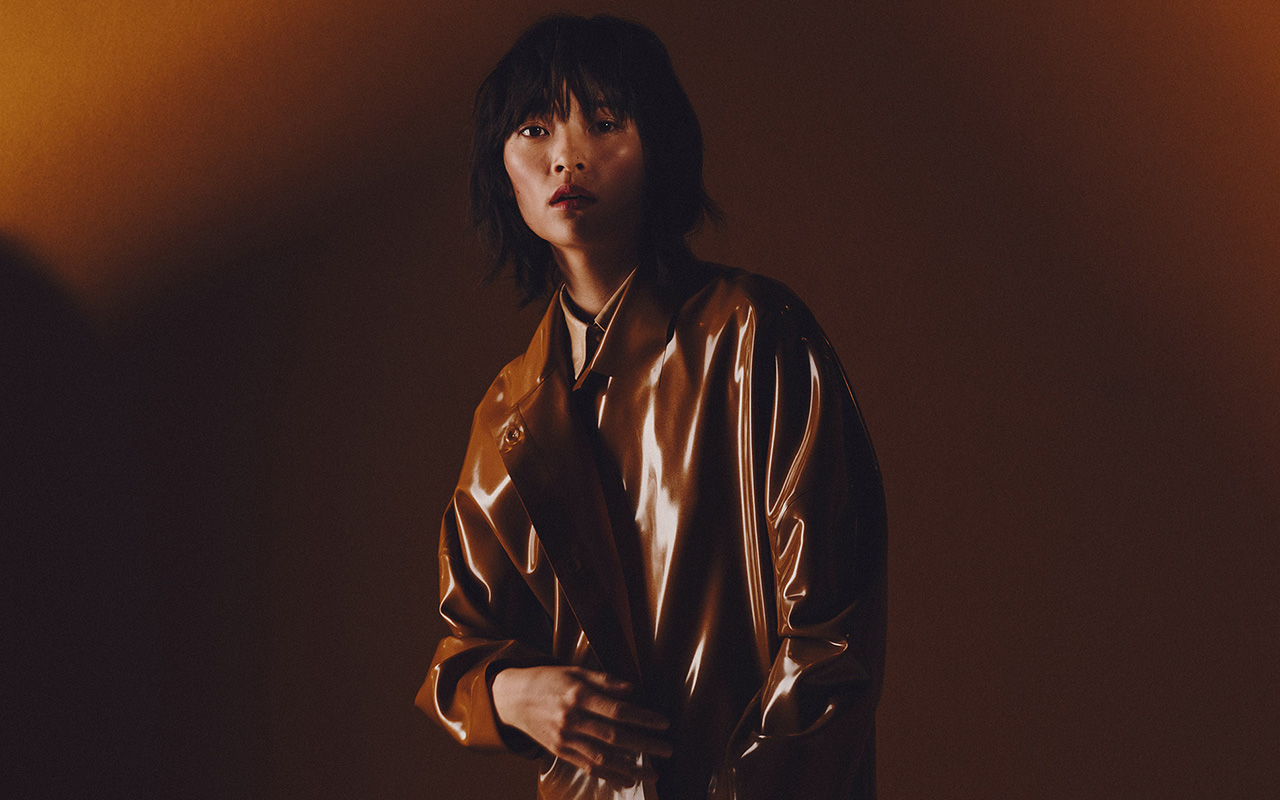
Brown. Right from the start it sounds ugly and unpleasant, it triggers some ridicule and in general, it represents an underappreciated colour: Only 1% of people admit to having it as a favorite, being the hue that generates the most rejection among the population. On a psychological level, brown has negative connotations because it is associated with the old and outdated, poverty, dirt or everyday life. The ordinary is represented in brown. The discreet also because brown, being the mixture of primary colours, goes unnoticed. These mental associations are related to the history of clothing and the use that was given to this underestimated colour in art. Despite this, brown also has a luminous underside: it represents the earth and is present in nature, through flora and fauna. In design and decoration, brown is highly appreciated because it refers to warmth, recollection and well-being. The rustic environments, with a great presence of wood, leather and mud and clay, are in brown tones. Below, we explain some curiosities about this reserved shade that is essential in autumn, the season that we psychologically associate with brown.
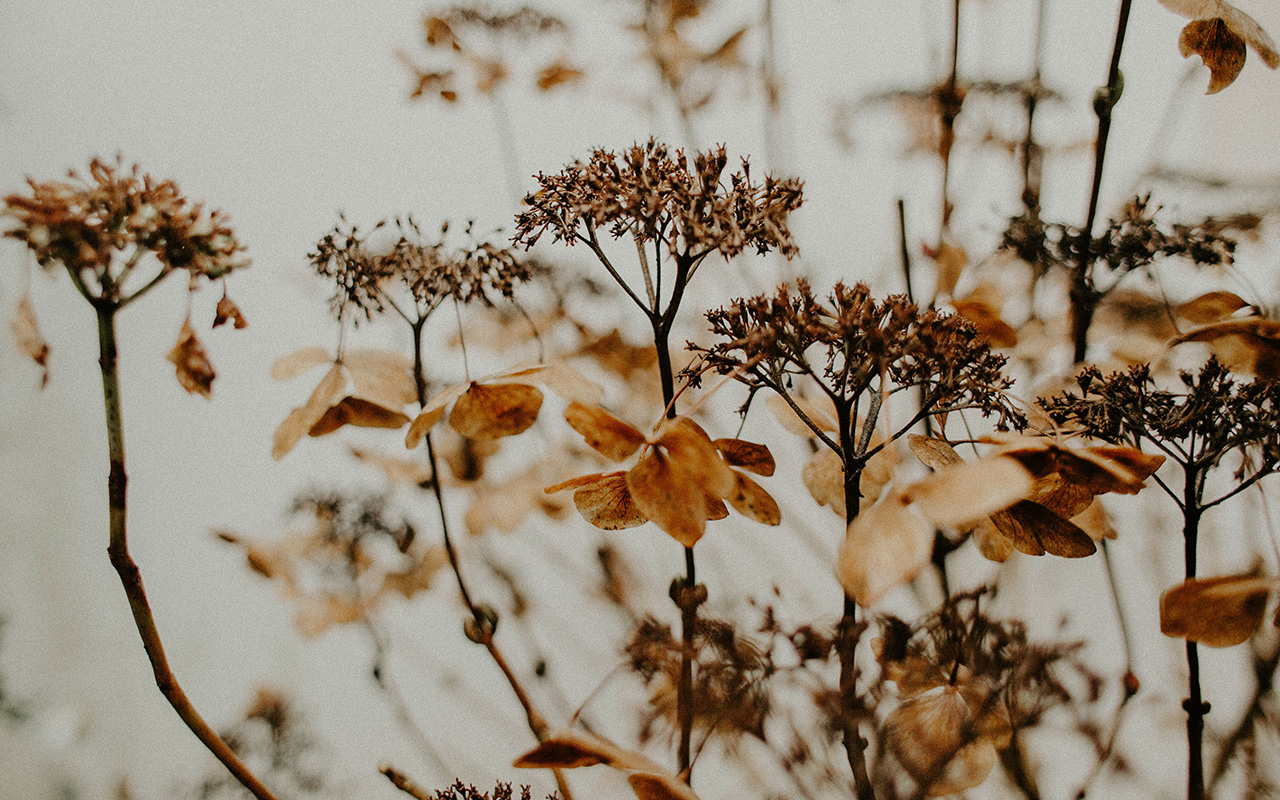
The origin of brown
Brown has always been there, and it abounds all around us. These tones are very common in nature: the bark of trees, the skin and hair of animals, clay soil, arid soils, mud flows… Brown represents mother earth, where it emanates with all its force. , its nature, and, therefore, life and death. Maturity is brown, so in autumn, this colour shines in all its intensity. The flowers lose their youth and the leaves gradually turn this shade to announce the end of their cycle.
Etymologically, the name of the colour is a Gallicism. It refers to “marron” which means chestnut in French. This word was introduced in the mid-nineteenth century to designate what was previously known as chestnut. The acceptance and use of the term among the population was so great that it was introduced into the normative dictionary in 1927. Therefore, not even a century has passed since our language has accepted the word brown to designate the brown or brown colour. Despite this, today we continue to use the old adjective to name hair and hair that is neither blonde nor brown.
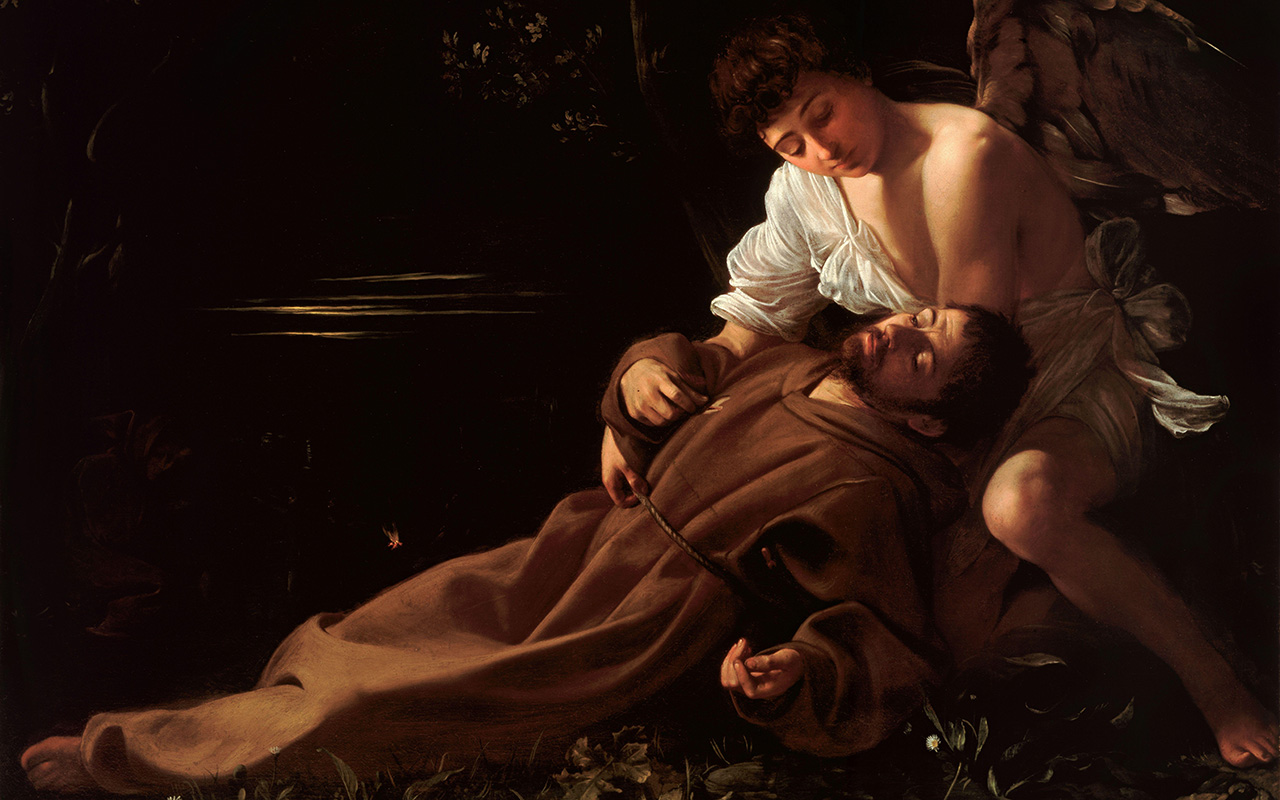
The colour of humility and poverty
Historically, brown has always been an abundant colour, easy to produce and in many cases, represented undyed fabrics through elaborate pieces of flock and hair of goat, deer and hare spun with raw and brownish flax and hemp. Therefore, the brown clothing was the original and did not need any added treatment. Since Classical Greece and practically up until the end of the 18th century, pieces of clothing in bright colours such as red, ultramarine blue, green or golden yellow were status symbols -they were expensive colours to produce- and were reserved for women. privileged classes. The undyed garments clearly showed an inferior status and for this reason, the popular classes used them frequently, with brown being the colour associated with simplicity, humility and poverty. For example, in Ancient Rome, brown clothing was associated with the poor or the barbarians – those peoples who did not master the dyeing arts. The term used to address the commoners was “pullati”, which literally means those dressed in brown. In the Middle Ages, brown was considered the ugliest colour on the spectrum because it was the colour worn by peasants, serfs, servants, and beggars. It also represented an abundant, ordinary and vulgar colour, values opposed to the opulence of the nobility. Therefore, brown was seen as a worldly colour, associated with the crowd, the mob and why not, with dirt. Feces, mud and bitumen are brown and frequently surrounded the plebs.
If brown also represented a symbol of humility, it was not surprising that the first Christian monks used this colour to preach a simple life, away from all kinds of luxuries. When the colours for the different orders were established, the brown and gray colours dressed the monks who took a vow of “maximum poverty” such as the Franciscans known for their brown robes as a symbol of Christian humility.
Brown was also, for centuries, the colour of mourning for the poor because black-dyed fabrics were inaccessible to the most popular classes.
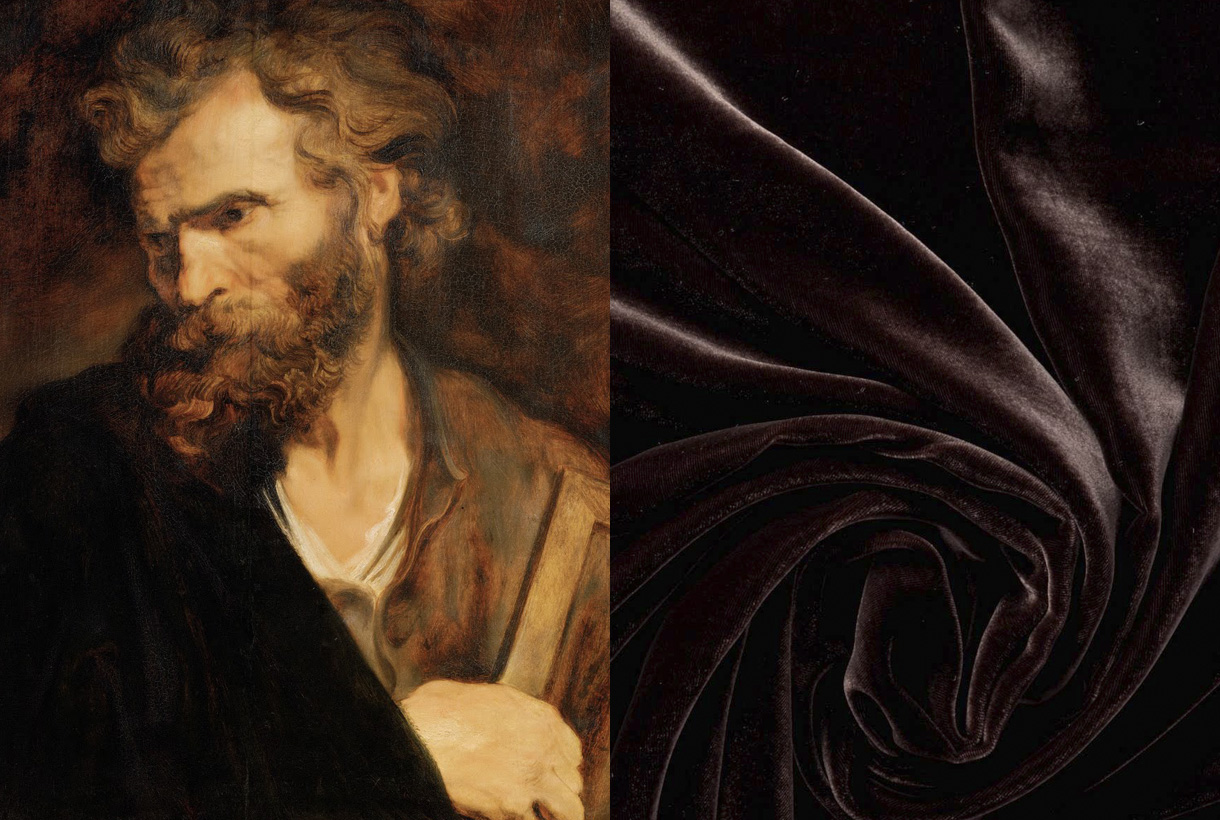
A change of conception
The aesthetic ideal of vibrant colours lasted as long as the cost of luminous tints remained high. This paradigm began to change from the eighteenth century when it was possible to dye pure colours for the first time (red, blue and green were the most valued) at reasonable prices. This fact changed the value system: pure colours were then considered simple, and the dyer’s art was transformed into the art of mixing dyes. From there arose, in the rococo era, the predilection for pastel colours, and the introduction of chestnut as a fashionable colour among the nobility. To obtain the coveted brown, they were dyed several times with different colours, one after the other, to obtain a more varied tone. For example, Louis XVI had a predilection for flea colours (he called them coleurs de puce ) with very varied nuances: old flea, young flea, flea back, flea head, flea leg… All would refer to a type of brown distinct.
Goethe, on the other hand, considered pure colours to be negligible, since they were difficult to combine in the clothing of sophisticated people: “The use of solid colours undoubtedly has many limitations; On the other hand, colours such as dirty, dead, the so-called fashion colours, show many gradations and nuances, most of which are graceful”, he said. The “dirty colours” were all shades of brown, and the “dead colours” referred to those that darkened to black with its various variations that were more versatile. This is how German culture progressively turned the meaning of brown upside down. From the plebs and marginalization, it came to represent the culture and good taste of the upper classes.
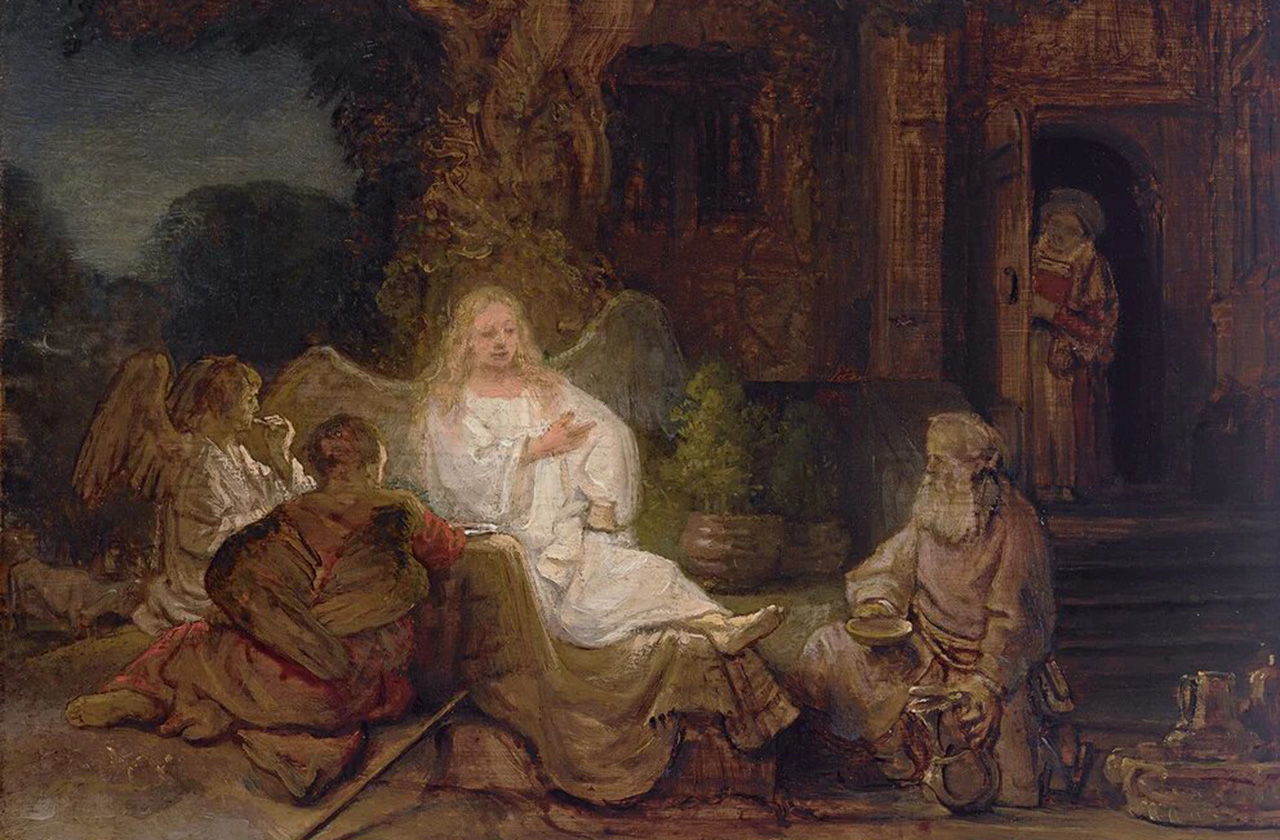
Brown in art
Although brown has been used in art since prehistoric times, this hue was rarely used in art until the Renaissance. In the Middle Ages, for example, artists preferred bright, distinctive colours to paint pictures or illustrate religious books. In the 17th and 18th centuries brown was in greater use. Caravaggio and Rembrandt used various shades of brown to create chiaroscuro effects, where the subject stood out from the darkness. Rembrandt also added shading to the ground layers of his paintings because it promoted faster drying. The artist began to use a new brown pigment, called Cassel earth or colony earth. This was a natural earth colour made up of organic matter, such as soil or peat. It was used by Rubens and Anthony van Dyck, and later became commonly known as Van Dyck brown. The French Impressionists of the 19th century were not very fond of the colour in question, with the exception of Paul Gauguin who created luminous brown portraits of the people and landscapes of French Polynesia.
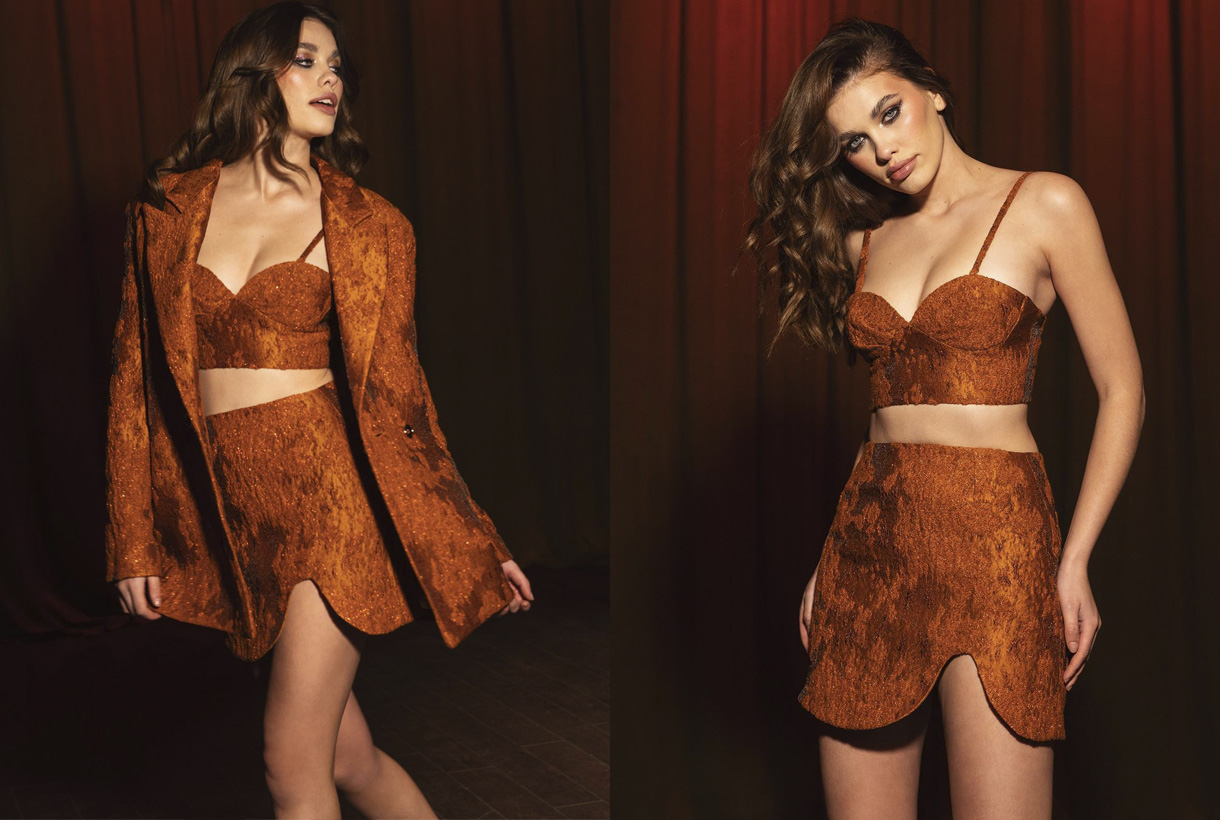
A colour appreciated in fashion
Traditionally, it was thought that the person who wore brown conveyed to the world that they wanted to go unnoticed. The psychological effect it causes is that of being an ordinary colour, even mediocre. In fact, there are still rules attached to clothing issues that go back to this imaginary of colours. For example, high-ranking executives are said to be banned from wearing brown suits because they detract from their status.
Beyond certain beliefs or traditions, fashion has adopted brown in its bed and has given it infinite possibilities. Brown is a warm and deep tone, it exudes magnetism, it is easy to combine, and therefore it adapts perfectly to countless looks because it makes its discretion its best asset. Not in vain is it considered a neutral like white, black or navy blue. Despite being traditionally related to autumn, brown this 2022 has been worn in spring and summer, through youthful and fresh looks that have been followed by some celebrities and fashion prescribers such as Cardi B, Dua Lipa, Selena Gómez, Kendell Jenner or Rihanna. Wearing it in a total look version has also been the preference of the big fashion firms.
At Gratacós we want to show you some of the key fabrics for the new season in shades of brown to show you their full potential. You will also find other items at discounted prices. You will find them available in our online store.
In short, brown will never go down in history as one of the most significant colours, but it will walk hand in hand with it thanks to its simple, versatile and discreet nature.
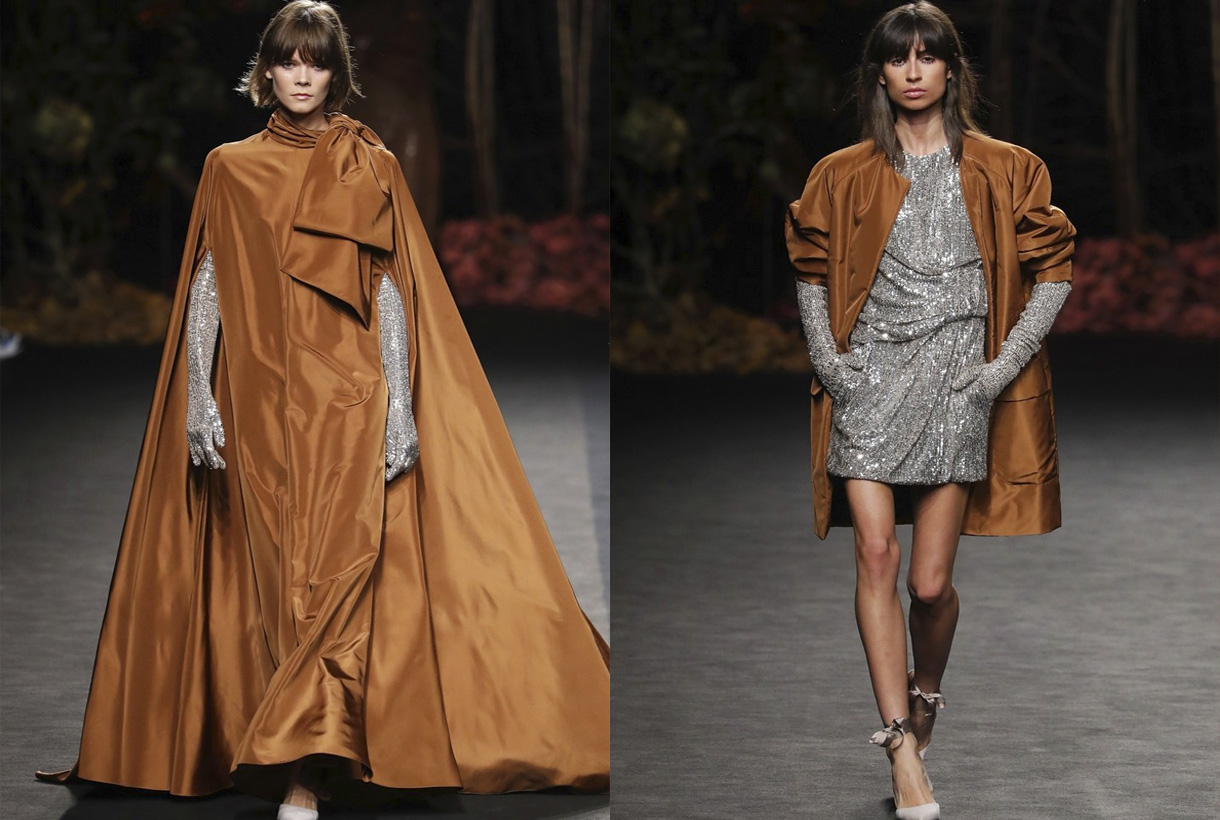
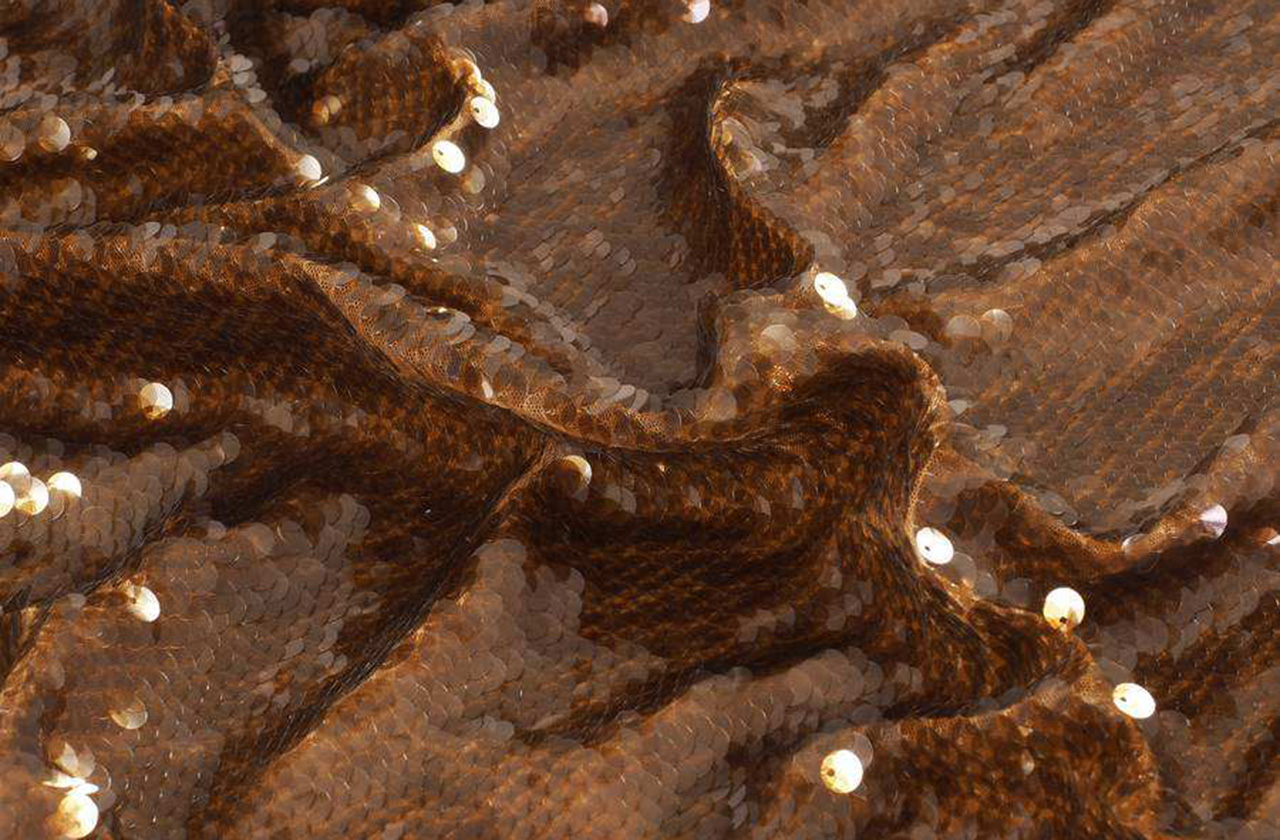
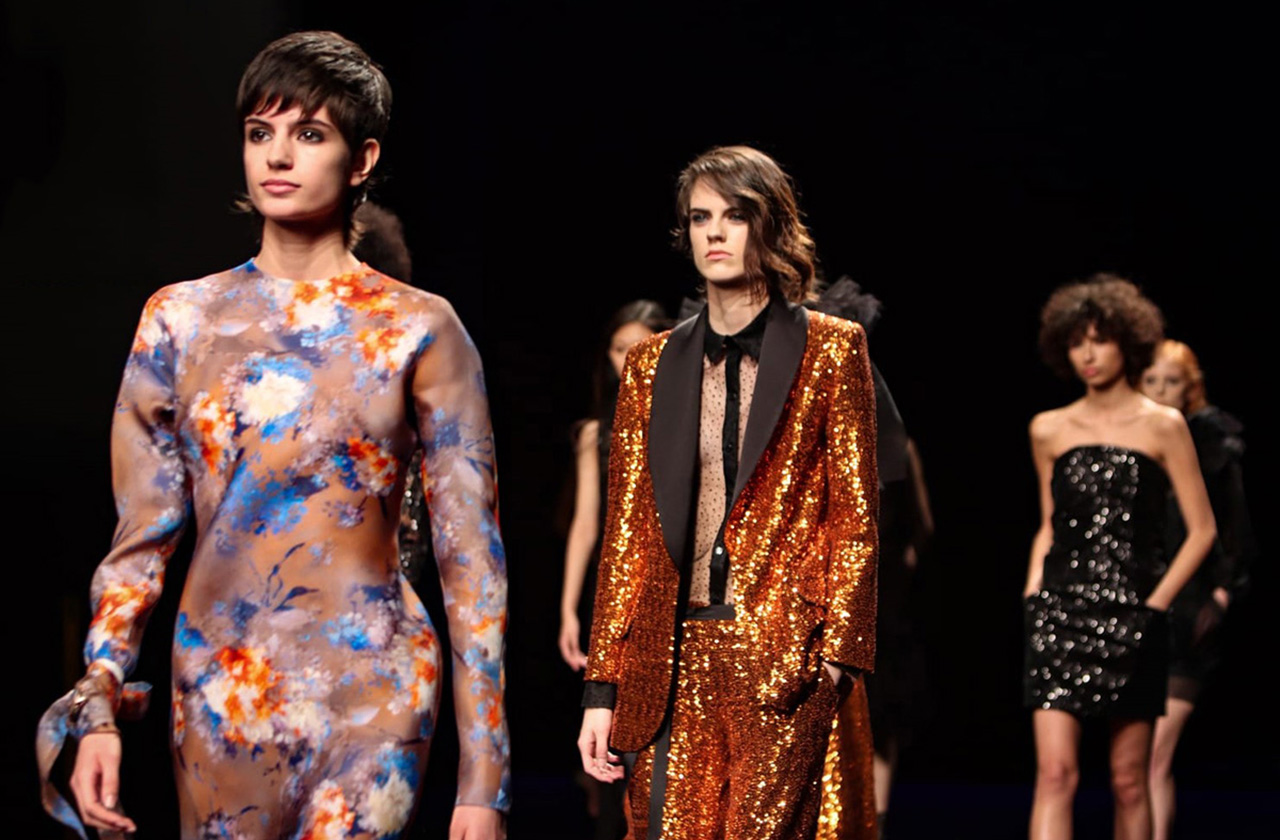
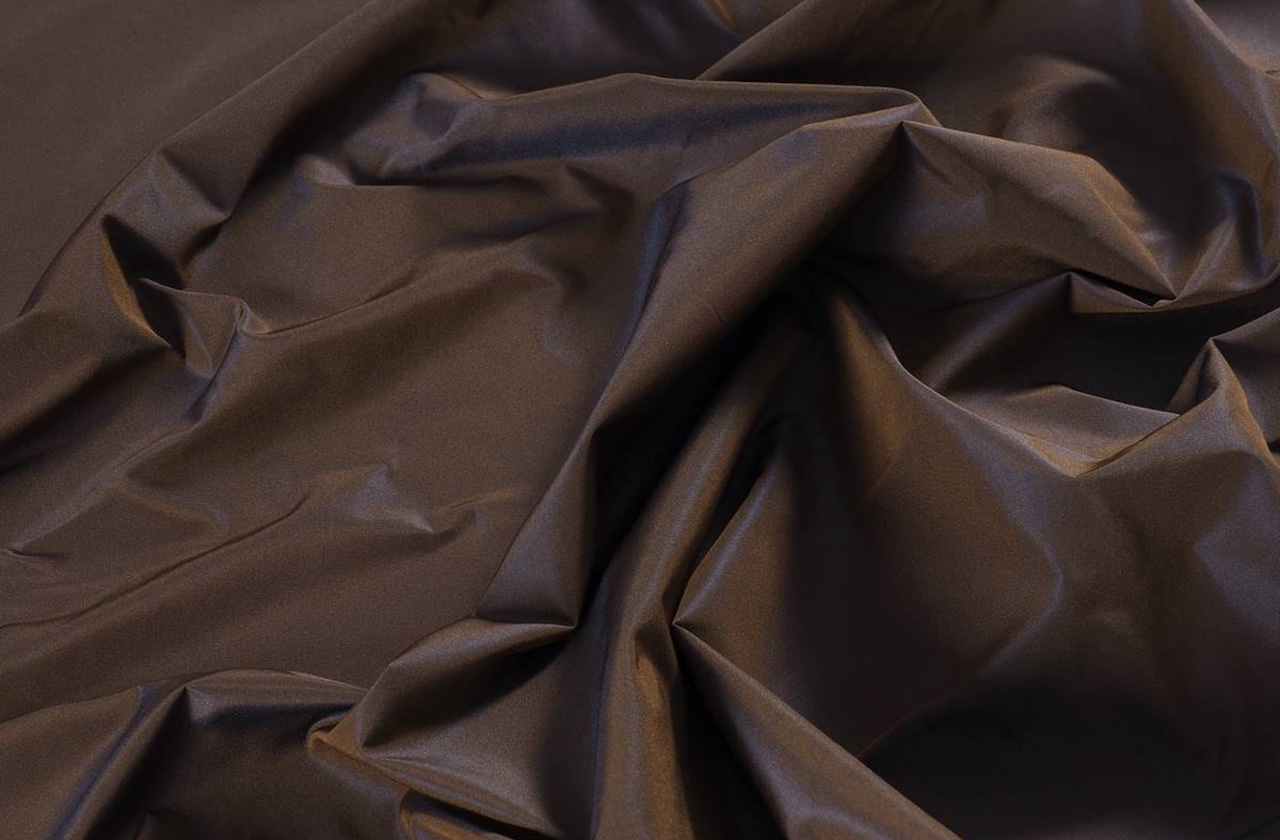
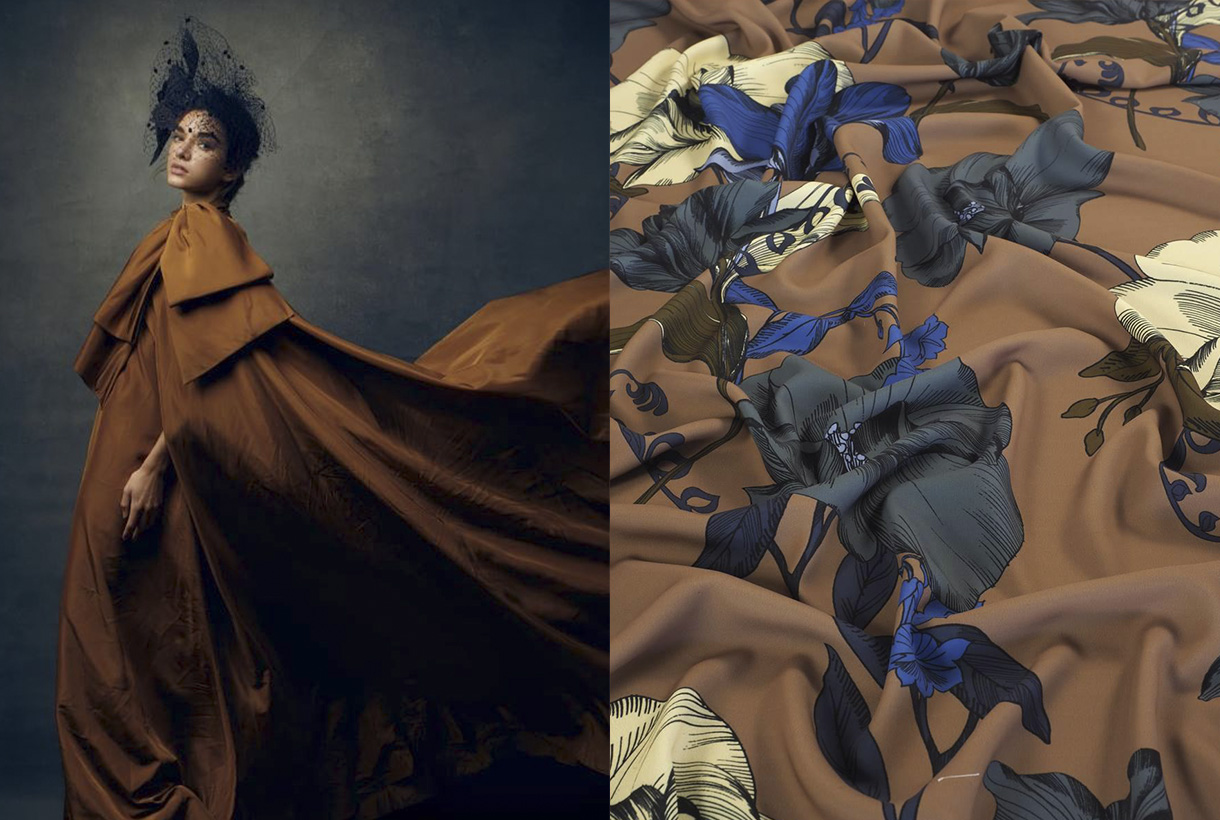
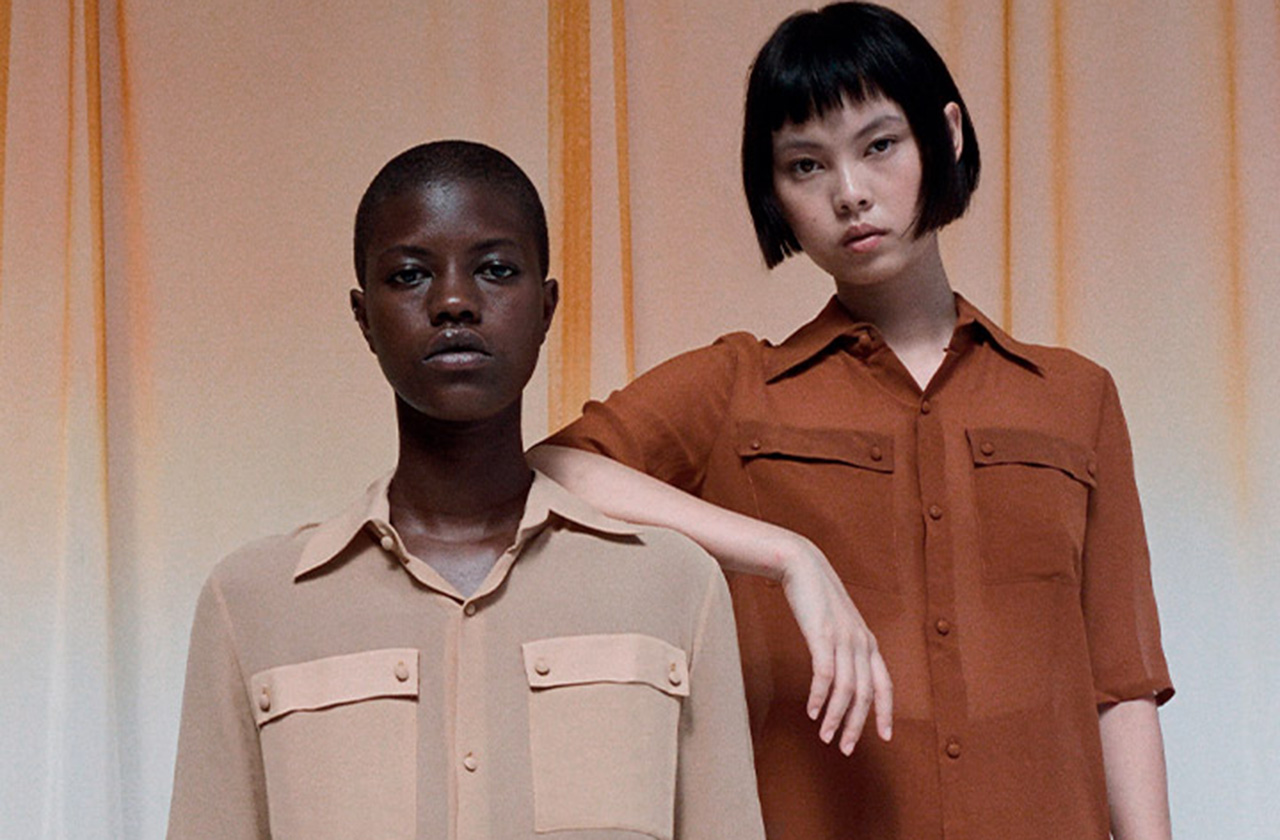
Sorry, this entry is only available in Español.
 El diseñador de moda y director artístico de la muestra, Jean Paul Gaultier, en CaixaForum Barcelona.
El diseñador de moda y director artístico de la muestra, Jean Paul Gaultier, en CaixaForum Barcelona.
Jean Paul Gaultier is the enfant terrible of fashion in his own right. Although he is no longer creatively spearheading his namesake brand, now spearheaded by his successor Olivier Rousteing, Gaultier will always be Gaultier. A self taught genius. Transgressive and irreverent, but from his kind facet. A free verse of fashion that he revolutionized in the 70s, 80s and 90s exalting difference, celebrating diversity, breaking stereotypes and exploring the beauty of the margins. Gaultier was not interested in the classic or the conventional, but he did investigate how he could empower the women of his time through clothing. His designs were the perfect armor for a new generation that wanted to express their strength, dynamism and freedom through clothing. One of Gaultier’s icons, the pointed corset worn by Madonna on the ‘Blonde Ambition’ world tour in 1990 was created thanks to the influence exerted by the woman who has most inspired him: his grandmother and her extensive lingerie wardrobe reminiscent of the enfant terrible from his childhood.
This iconic garment, among others, can be seen live in the new exhibition premiered at CaixaForum Barcelona: ‘Cine y moda. Por Jean Paul Gaultier’. An exhibition co-organized by the La Caixa Foundation and La Cinémathèque francaise that proposes an eclectic journey that intertwines cinema and fashion with great creators and artists, from the personal point of view of the controversial creator, as a costume designer and as a movie buff. For Gaultier there is no cinema without fashion, and vice versa.

Backstage, desfile de Jean Paul Gaultier, colección Barbès, 1984, prêt-à-porter de mujer otoño-invierno 1984-1985. © William Klein.
Divided into five areas, the author’s exhibition where Gaultier captures his gaze, reviews the presence of the world of fashion in cinema, the collaborations of great designers in film costumes and the creation of male and female archetypes. The enfant terrible of fashion emphasizes key aspects that are present in his career as a designer such as female empowerment and pays attention to heterodox figures of male and female warriors, androgynous and transvestites, as well as the influence of rock, punk and and queer that have marked fashion so much in recent years.
After passing through Paris and Madrid, the exhibition, dedicated to the memory of the filmmaker Tonie Marshall, brings together in Barcelona a heterogeneous set of more than 100 pieces of clothing that are shown in nearly 70 looks, fragments of more than 90 films and 125 graphic representations (posters, sketches, frames and photographs), between originals and reproductions, mostly from the prestigious collection of La Cinémathèque Française and complemented by works from more than twenty national and international lenders.

Díptico Marlene Dietrich. Masque & Narcisse, 2021. © Bastien Pourtout i Edouard Taufenbach, colección Pierre Passebon, 2021.
Among the nearly 70 iconic film looks are dresses worn by Grace Jones in ‘A View to a Kill’ (1985), Catherine Deneuve in ‘8 Women’ (2002), Grace Kelly in ‘Rear Window’ (1954); Sharon Stone in ‘Basic Instinct’ (1992); Marilyn Monroe in ‘Nude Eve’ (1950); ‘Tay Garnett’s Seven Sinners (1940); Brad Davies in ‘Querelle’ (1982) or as we said at the beginning, the famous pink corset that graced Madonna on her world tour.
Also, the ‘Superman’ suits (which Christopher Reeve wore); ‘The Mask of Zorro’ (1998), with Antonio Banderas; the shorts that Sylvester Stallone wore in ‘Rocky’, or Victoria Abril’s wardrobe in ‘Kika’ (1993) which, together with that of other films such as ‘Bad Education’ (2004) or ‘The Fifth Element’ (1997) , was designed by Gaultier. In this line, haute couture designs by Coco Chanel, Pierre Cardin, Hubert de Givenchy, Manuel Pertegaz, Balenciaga and Sybilla, among others, are also on display.

Fotografía entre bastidores de la película ¿Quién eres tú, Polly Maggoo? 1966 © William Klein/ Films Paris New York.
Two films that mark the beginnings of Gaultier
Among all the parade of looks, projections and key garments, there are two films that take pride of place in the exhibition and have to do with the origins of the designer. The first would change the course of his life. Gaultier was then 13 years old when he first saw Jacques Becker’s ‘Falbalas’ (1945). A melodrama starring a seamstress and set in the hustle and bustle of a sewing house during the postwar period. This film is the “culprit” of his desire to dedicate himself to the world of fashion. From there he began to design figurines that he would later transform into designs. The other film that has marked the French creator has been ‘Who are you, Polly Maggoo?’ (1996) by William Klein, who in the film analyzes his time with a keen eye and lays bare the then incipient reality shows. It is a satire of the egocentric delusions of the world of haute couture, where at that time the space age dominated and everyone from the misanthropic couturier to the most versatile editor-in-chief fell.

Pedro Almodóvar, Victoria Abril y Jean Paul Gaultier en el plató de Kika, 1994 © Nacho Pinedo.
Moda y arte, actividades en paralelo
The exhibition ‘Cinema and fashion. By Jean Paul Gaultier’ will be open to the public until October 23. On this occasion, to investigate the close relationship between fashion and art, CaixaForum Barcelona has organized a cycle of conferences in September that proposes dialogues on how art and fashion influence each other: is art the source of inspiration for fashion or are fashion codes the ways the artist chooses to develop his poetics? The French philosopher and sociologist Gilles Lipovetsky, the architect Manuel Blanco, the journalists Isabel Margalejo and Carlos Primo, the popularizer Charo Mora (responsible for the cycle) or the model Sita Abellán, are some of the names that will illustrate the links between fashion and art, architecture, literature and music.




Detalles de la exposición ‘Cine y moda. Por Jean Paul Gaultier’
 The summer season begins with a trend less and less reserved for special occasions: sequins, which with their glitter catch all eyes. Disconnected from their comfort zone, these small metallic sheets sewn into the fabric become the protagonists of the moment together with other materials that dazzle on their own, such as iridescence or satin finishes that produce a more discreet shine.
The summer season begins with a trend less and less reserved for special occasions: sequins, which with their glitter catch all eyes. Disconnected from their comfort zone, these small metallic sheets sewn into the fabric become the protagonists of the moment together with other materials that dazzle on their own, such as iridescence or satin finishes that produce a more discreet shine.
On this occasion, sequins, along with fluorescent colours and transparencies, have featured on the fashion shows of the SS22 collections of Tom Ford, Michael Kors, Loewe, Valentino or Rodarte and are set to invade the street through resplendent outfits. The key to sequins, until now reserved for specific celebrations such as New Year’s Eve, is that there are many options to show them off successfully in garments to wear at all hours. Day and night without paying attention to brightness or excesses. From the rock & roll looks of Saint Laurent, to the sophistication of Chanel and Celine that combine them with tweed or in key details such as Gucci, Balmain or Paco Rabanne, creator of the iconic metallic mesh.

From Tutankhamun to Leonardo da Vinci
The origin of sequins dates back to Ancient Egypt, where small gold and silver discs were sewn onto the clothes of the pharaohs and their consorts as a sign of wealth. In fact, it was during the discovery of Tutankhamun’s tomb in 1922 that archaeologists found, among other objects, clothing decorated with shiny metal disks. A time that coincided, in turn, with the metallic fever of the Roaring 20s, embodied by the costumes of the flappers and the Egyptomania that unleashed this fact, which inspired the designers of the time to design outfits with metallic discs to stand out on the dance floor.
In English, the word sequin (sequin, is linked to the Arabic term sikka (coin) and al zecchino, a golden coin minted in Venice during the 13th century. The first sequins were coins sewn onto clothing, for reasons ranging from displaying wealth and status to making life difficult for thieves. It is also said that Leonardo da Vinci, one of humanity’s great inventors, devised a machine to produce small metal discs. A prototype that was never manufactured, but that already establishes the age of the sequin.
Later, in the 17th and 18th centuries, wallets and cases began to be used, and pockets appeared. Therefore, in men’s and women’s clothing it was no longer necessary to sew the coins to the clothes to keep them safe, and the small metal disks became a purely aesthetic ornament.

The sequin shines in the 20th century
Sequins as we know them emerged in the 20th century. Its sparkles began to adorn the rich dresses of the Belle Époque, added touches of light to the creations of the 1920s and returned to adorn the garments of the sensual 1950s. Actresses like Marilyn Monroe or Rita Hayworth succumbed to the sparkle of sequins with innumerable outfits that shimmered on and off the celluloid. A sparkly dress from the era that connects with today is the iconic beige dress that the blonde diva wore when she sang ‘Happy Birthday’ to President John F. Kennedy in 1962. That same crystal-covered gown was worn by Kim Kardashian in the Met Gala 2022.
The materials used to create the sequins also changed over time. The metal of the first prototypes evolved into gelatin in the 1930s. The latter material was lighter, but it was brittle and did not withstand changes in temperature well. Later, they became plastic, flexible and resistant to washing. Thanks to this change, sequins became more practical, less expensive and more affordable than their previous versions.
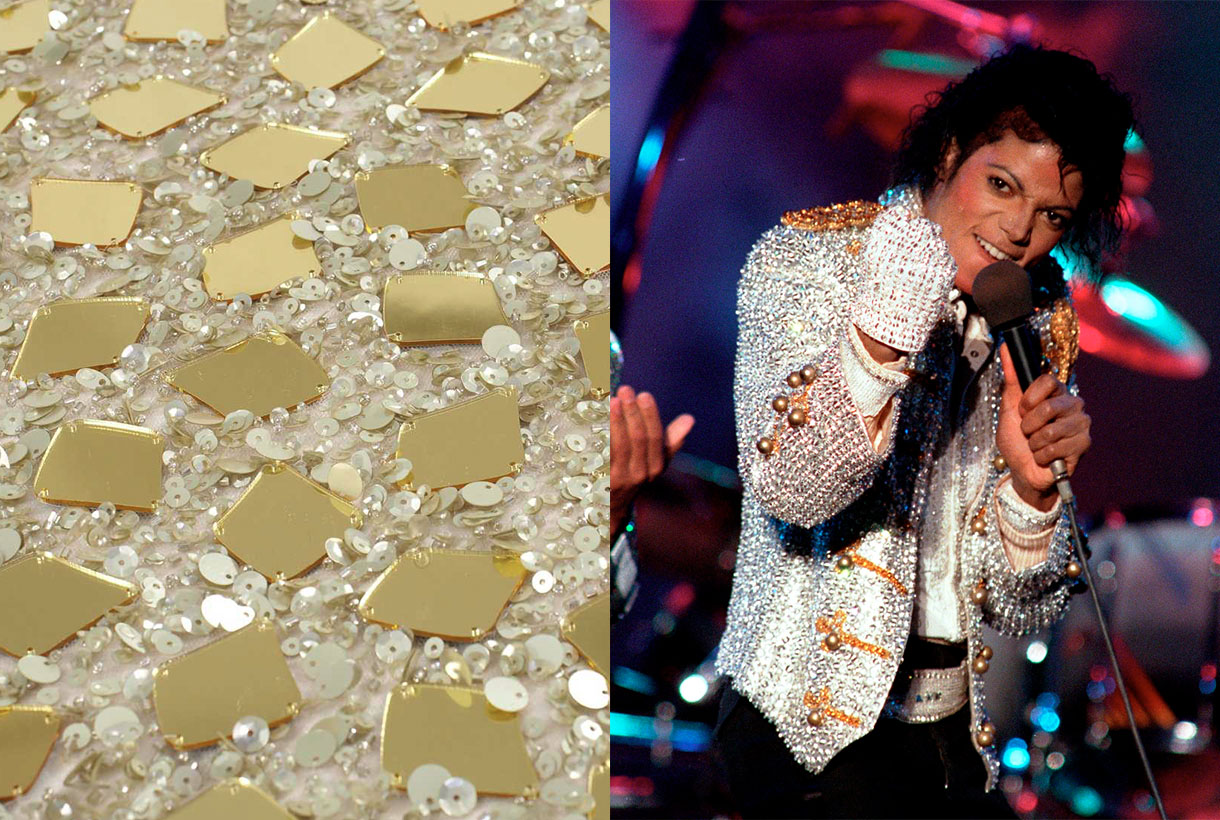
An ornament linked to music, movement and excess
With the innovation of new materials and the triumph of prêt-à-porter in the sixties, the use of sequins became popular in more common clothing that became daring, lively and colourful. The objective? Adorn the silhouette, empower it and become the center of attention. This manifested very well in the seventies with disco fever. In the countercultural movements, sequins and all shiny fabrics became a symbol of rebellion against the system they considered serious and boring. That’s when the glam rock era began . A sensual, androgynous, eccentric and revolutionary movement whose symbol was David Bowie with his iconic alter ego: Ziggy stardust . The man with the stars, and other singers of the time, wrapped themselves in lamé suits, sequins and lots of glitter.
Shiny fabrics, with sequins being the favourite, shone again in the 1980s. Michael Jackson was responsible for bringing glitter and pharaonic garments back to life with memorable performances where the King of Pop donned suits covered in sequins and rhinestones.

Nowadays, sequins, as well as other shiny fabrics, are subjected to the ups and downs of cyclical fashion. Its material is still based on plastic, now mostly recycled, but with special coatings. What has not changed is its meaning. Sequins spark the imagination, become visible and illuminate people’s daily lives. They are an element of escapism, something to cling to other fantasy worlds. And we already know that fashion is a dream and at Gratacós we like to make you dream through our sequin fabrics. Here we leave you a selection of the most innovative so that you shine with your own light.





















































































 The summer season begins with a trend less and less reserved for special occasions: sequins, which with their glitter catch all eyes. Disconnected from their comfort zone, these small metallic sheets sewn into the fabric become the protagonists of the moment together with other materials that dazzle on their own, such as iridescence or satin finishes that produce a more discreet shine.
The summer season begins with a trend less and less reserved for special occasions: sequins, which with their glitter catch all eyes. Disconnected from their comfort zone, these small metallic sheets sewn into the fabric become the protagonists of the moment together with other materials that dazzle on their own, such as iridescence or satin finishes that produce a more discreet shine.






